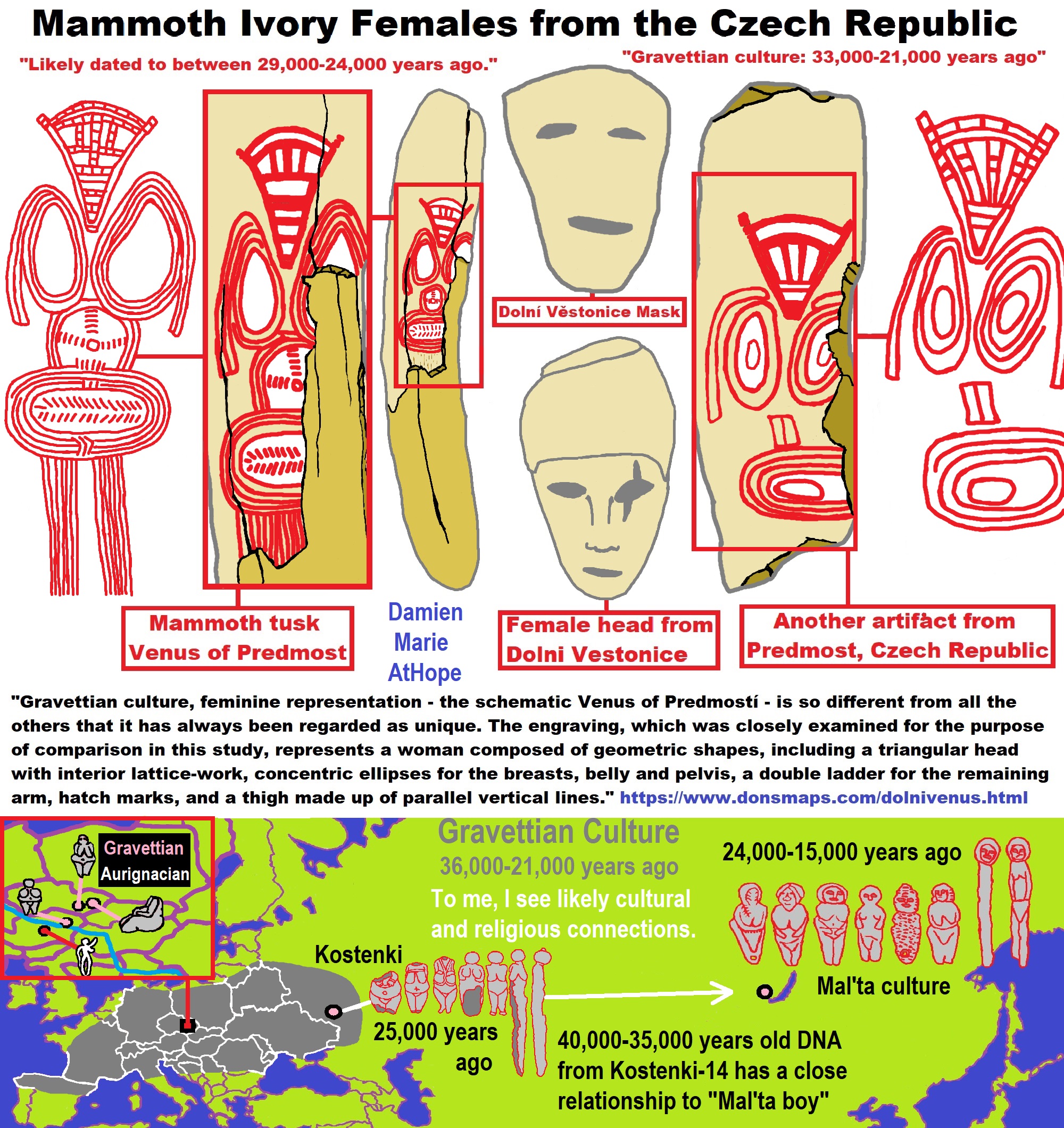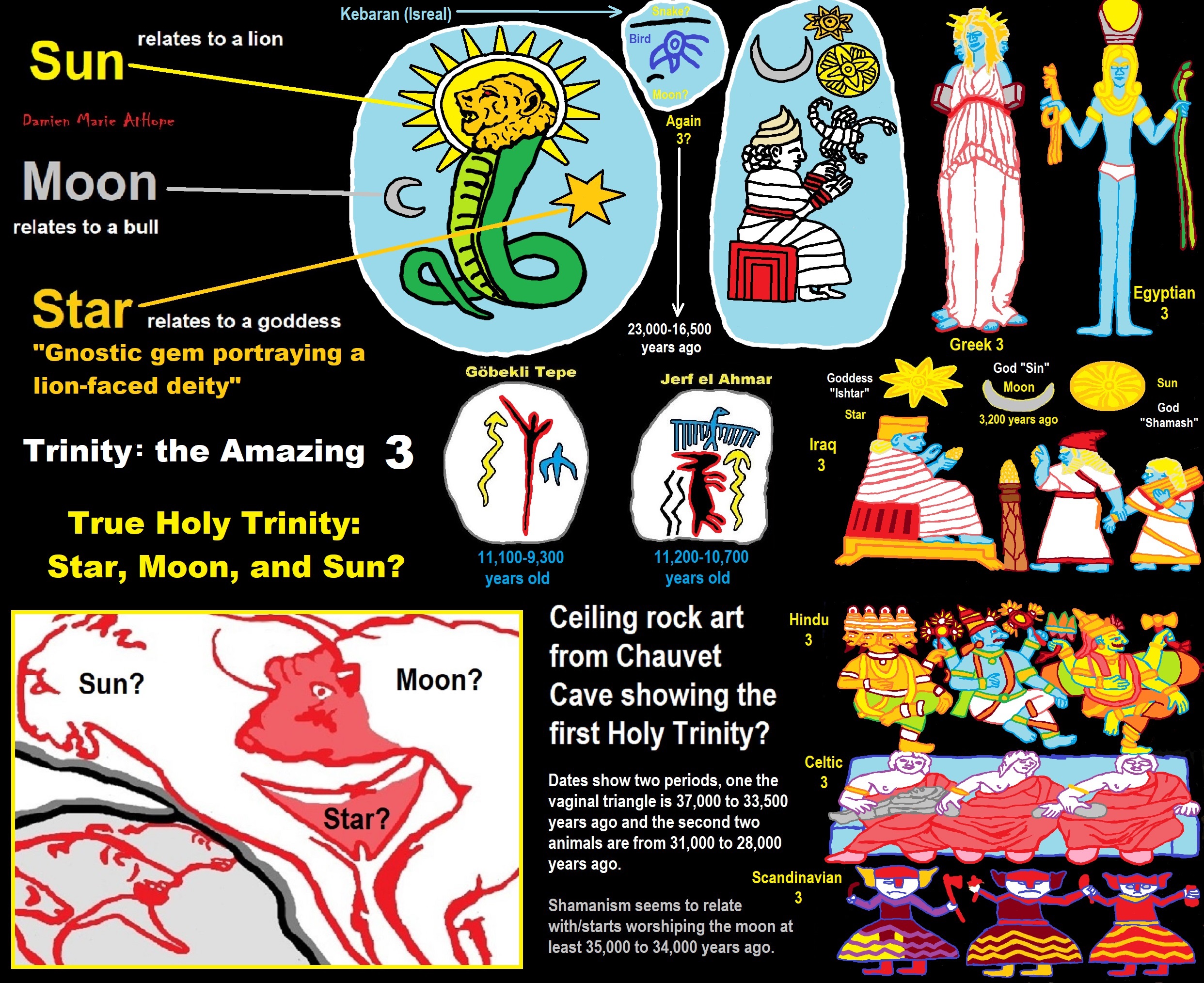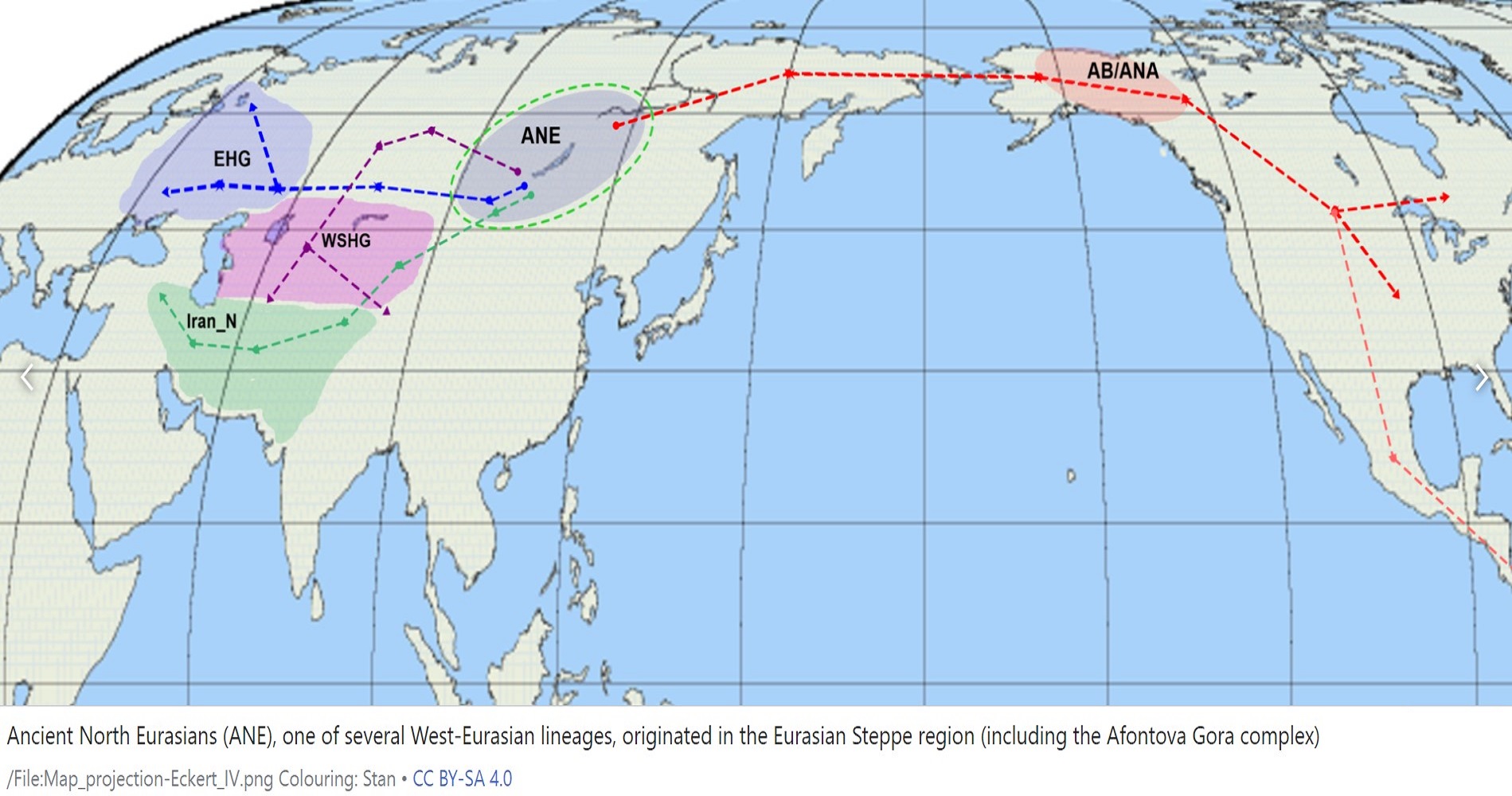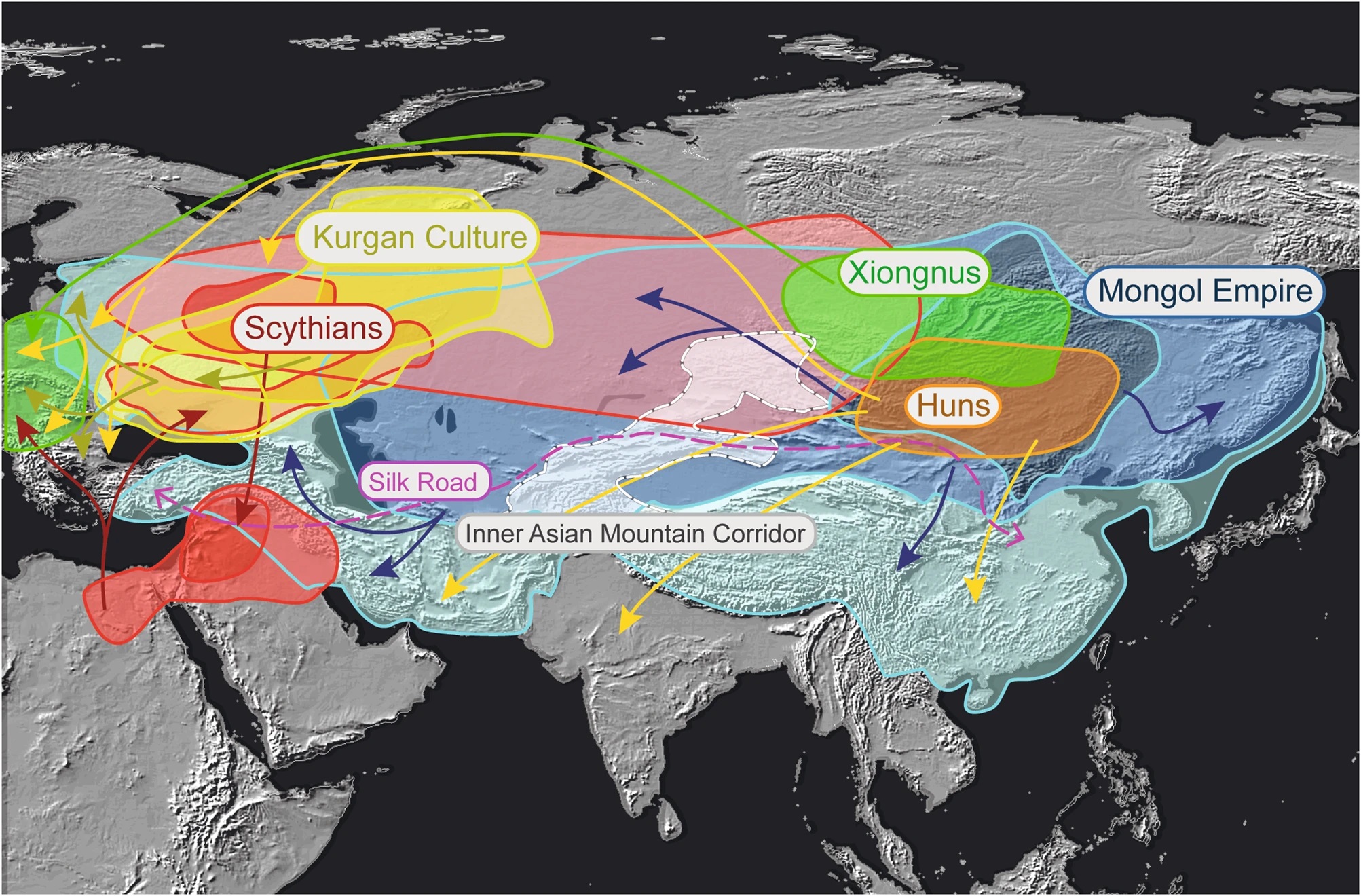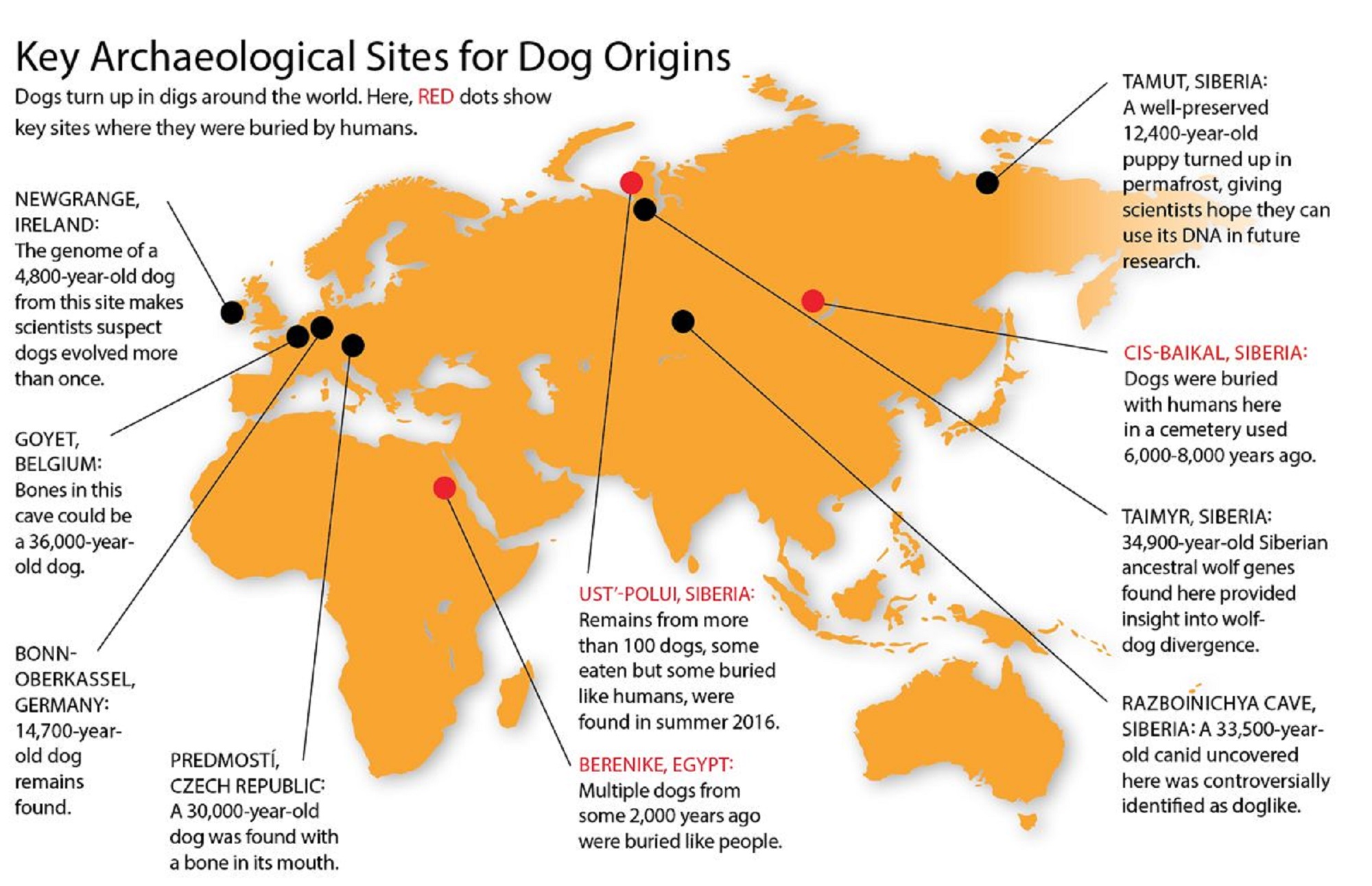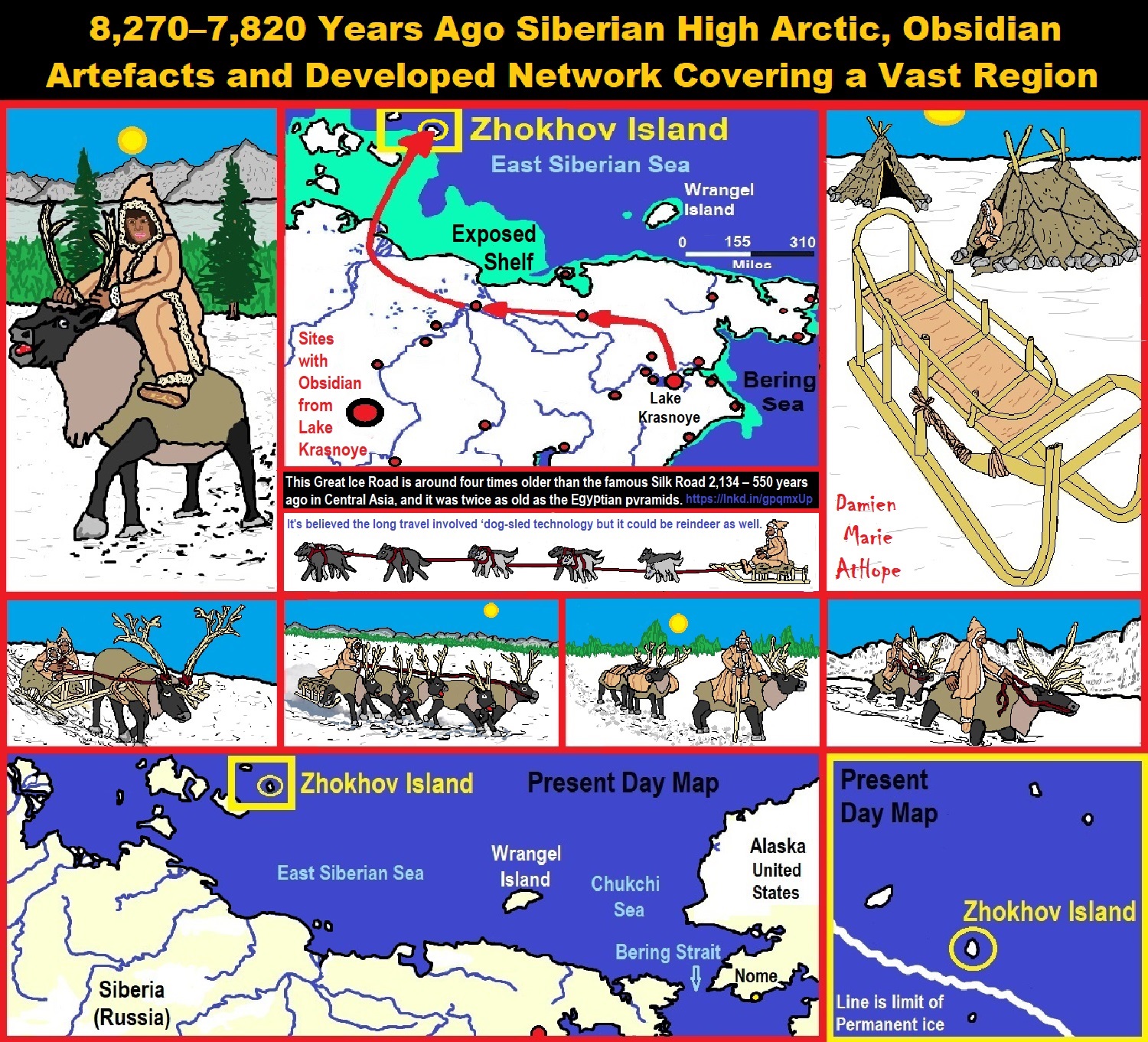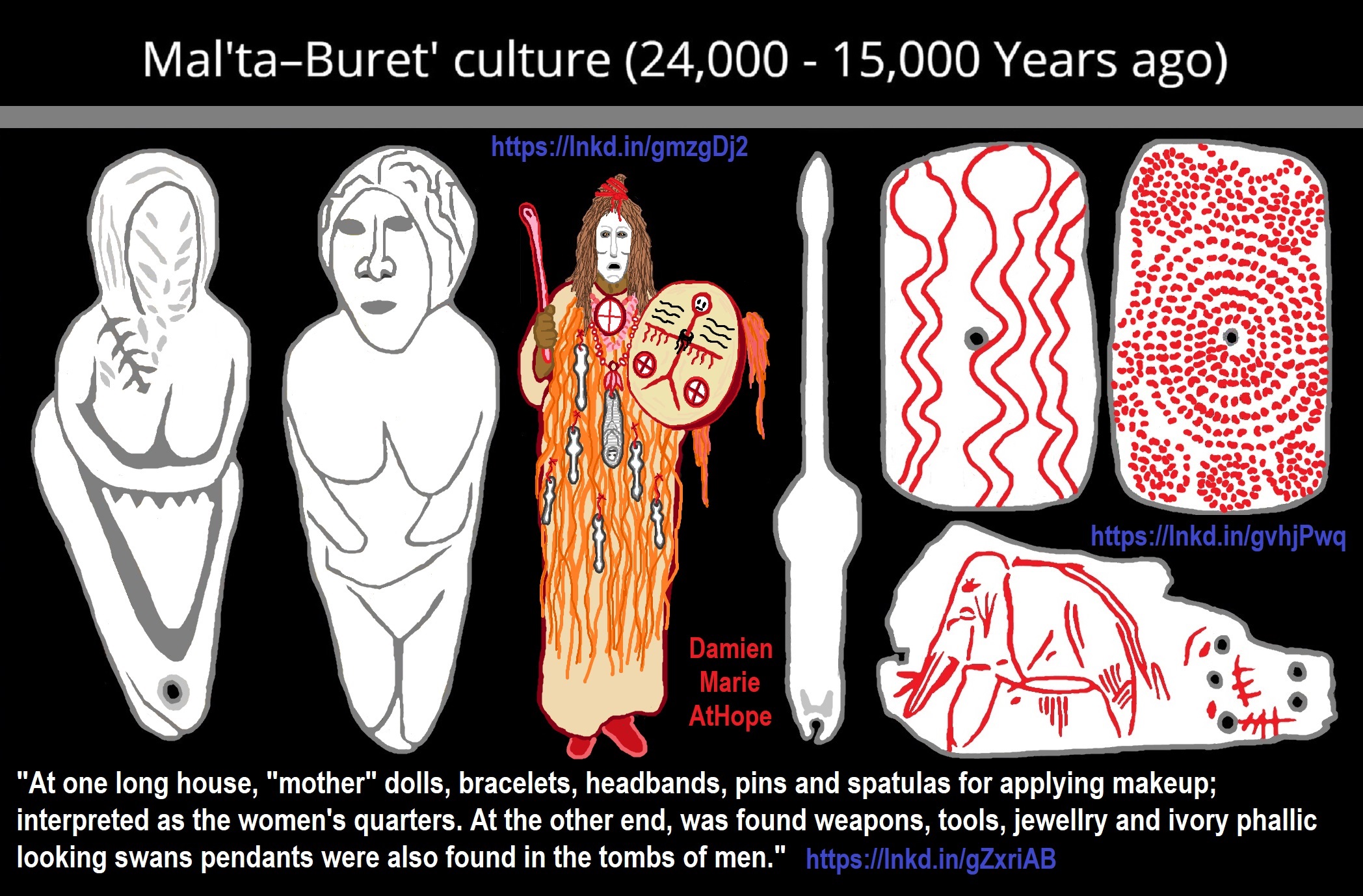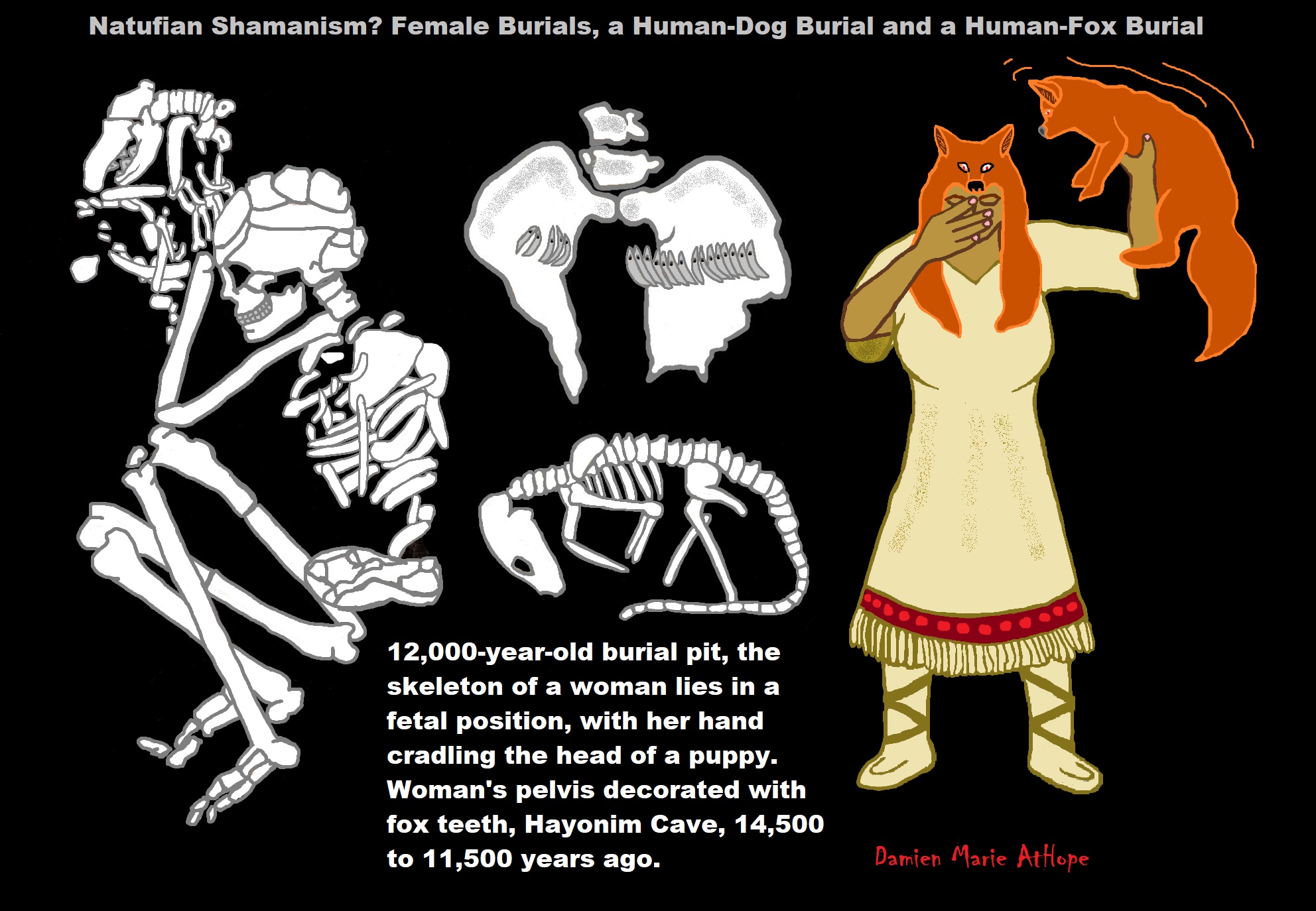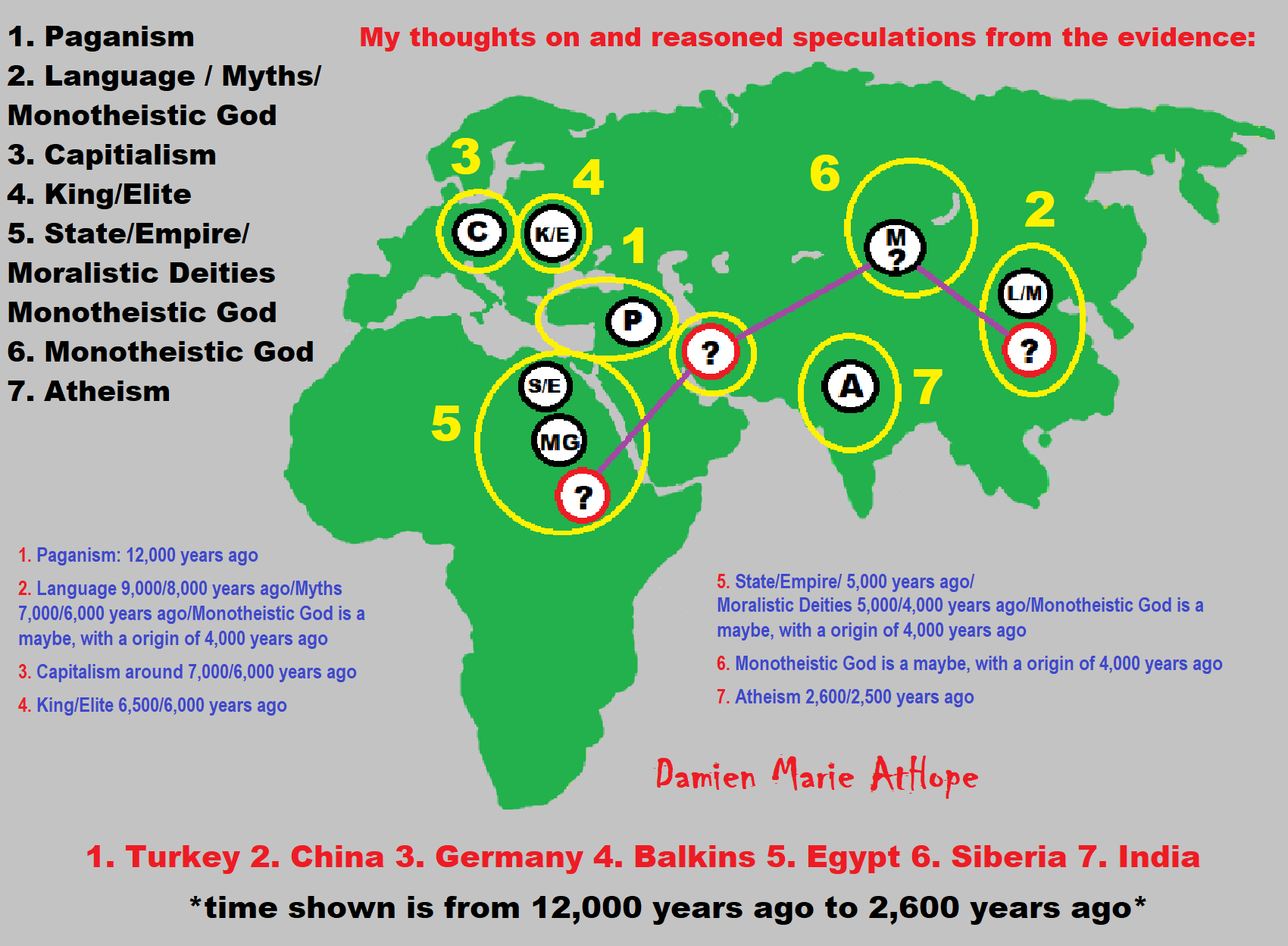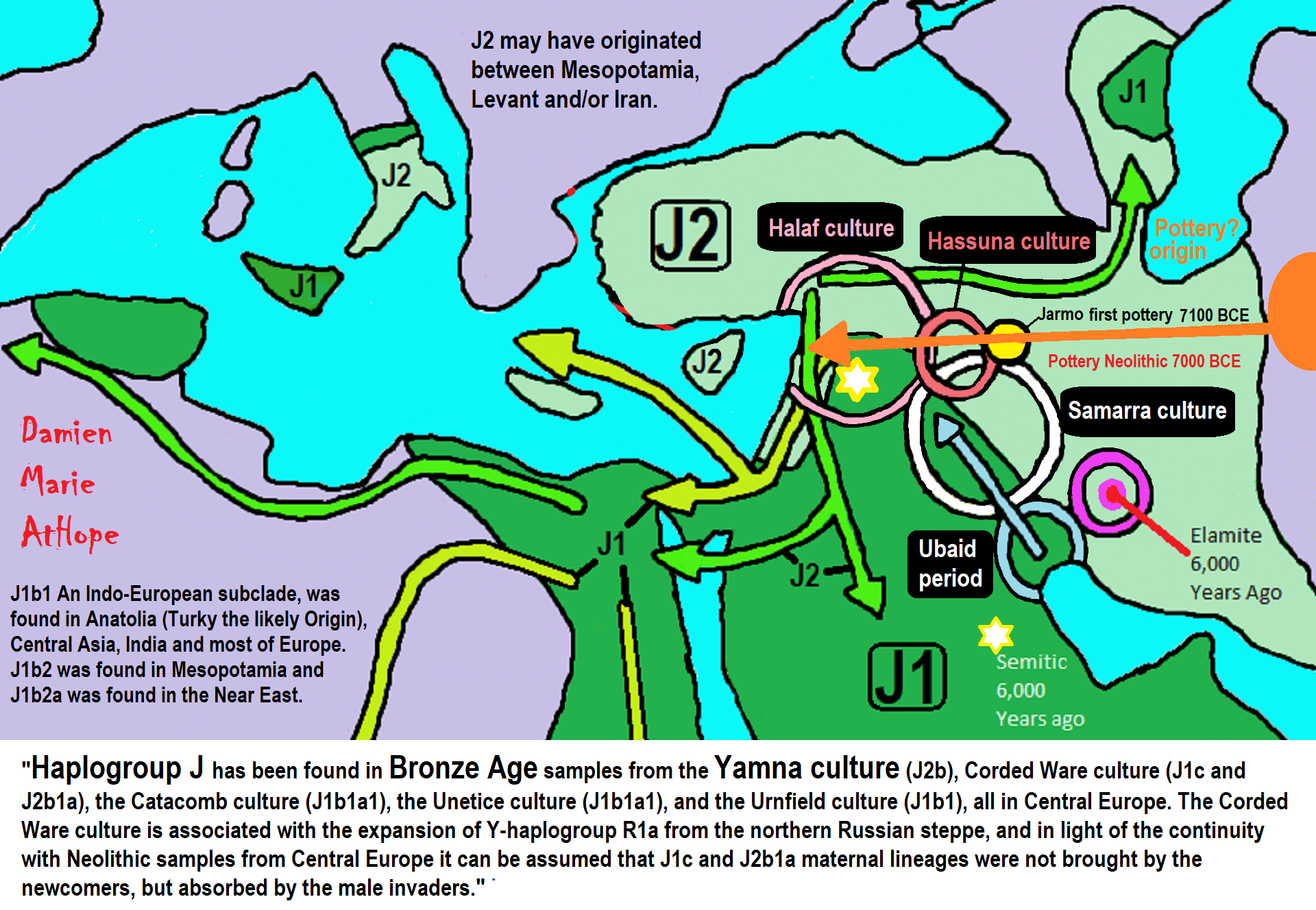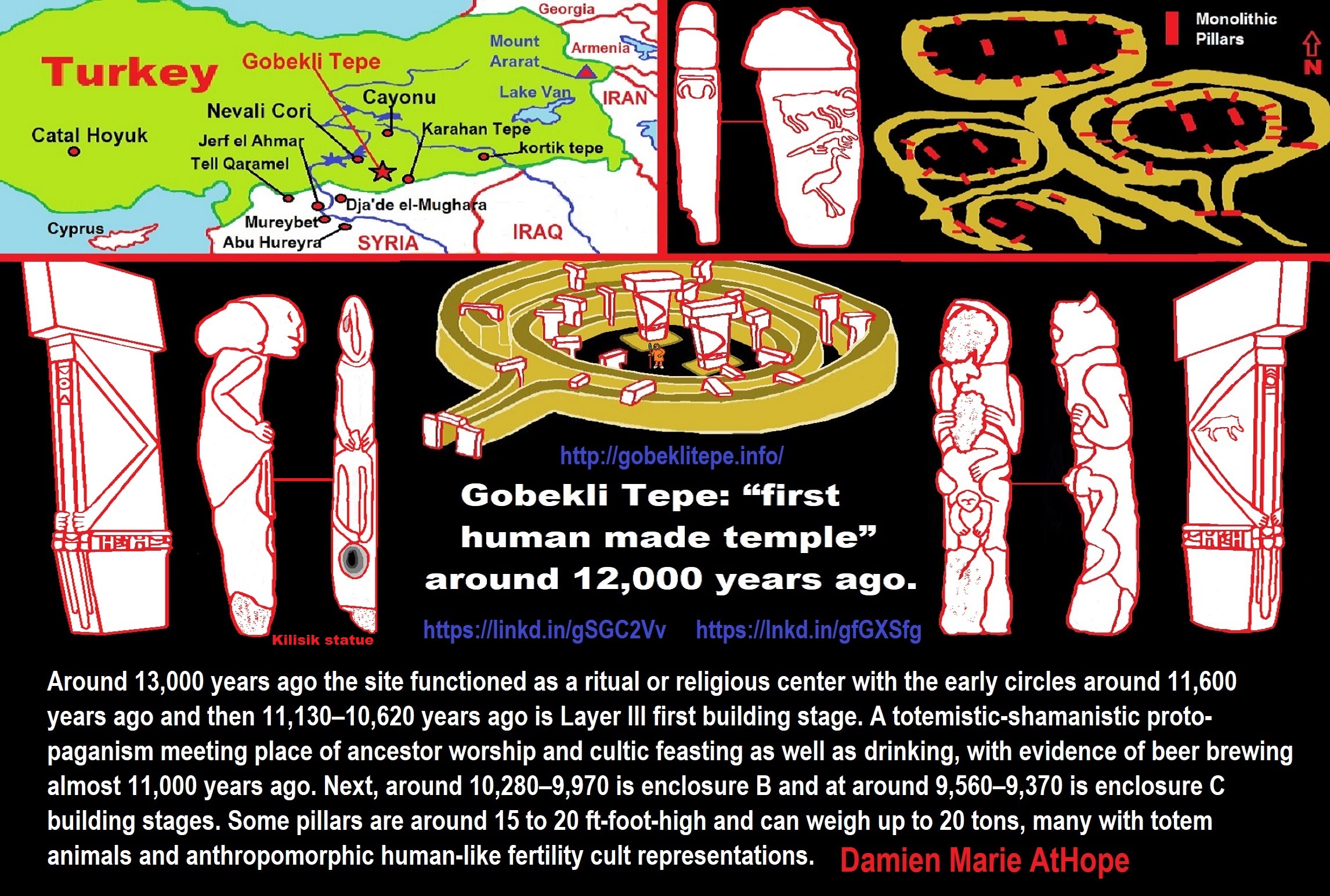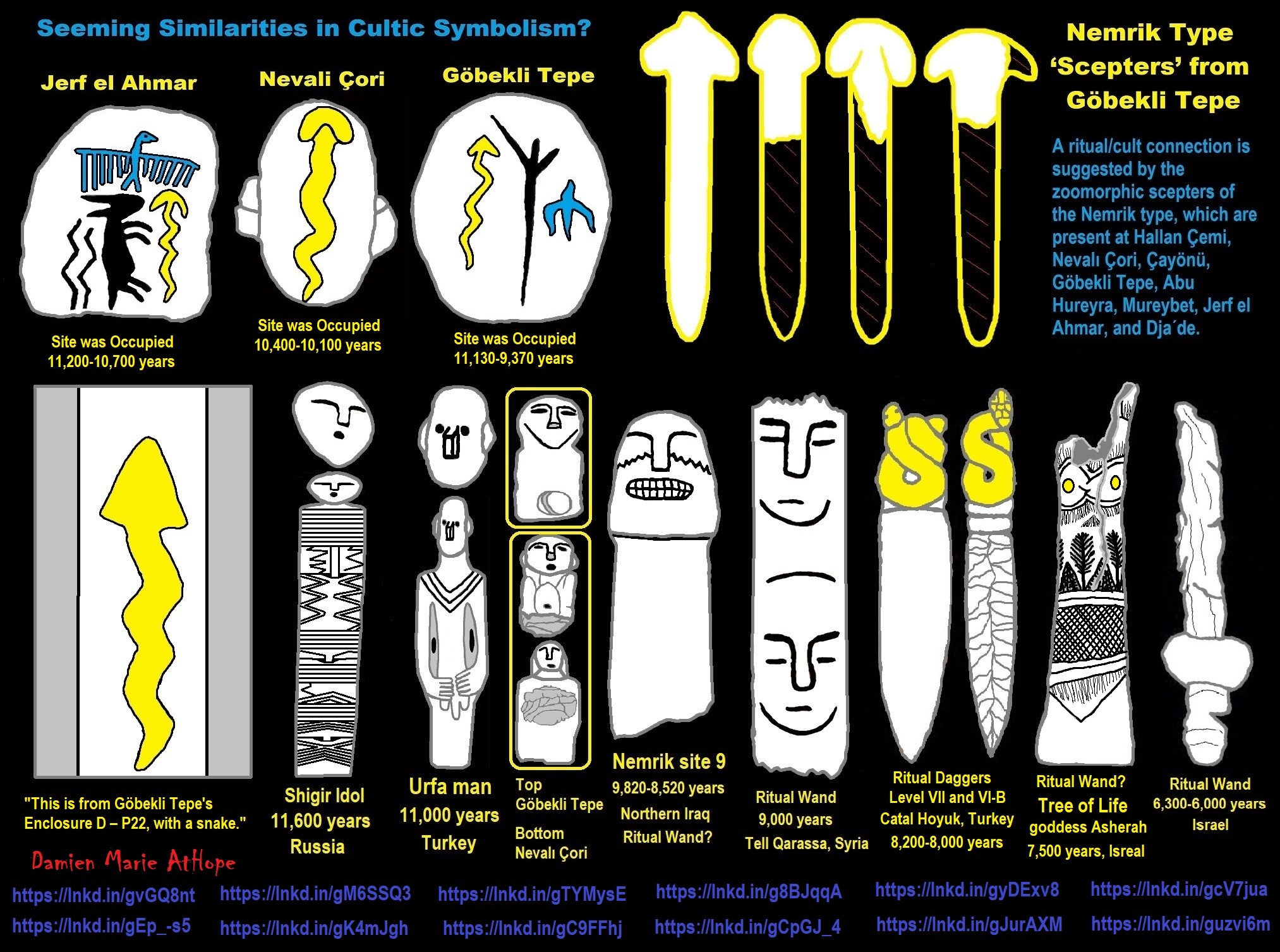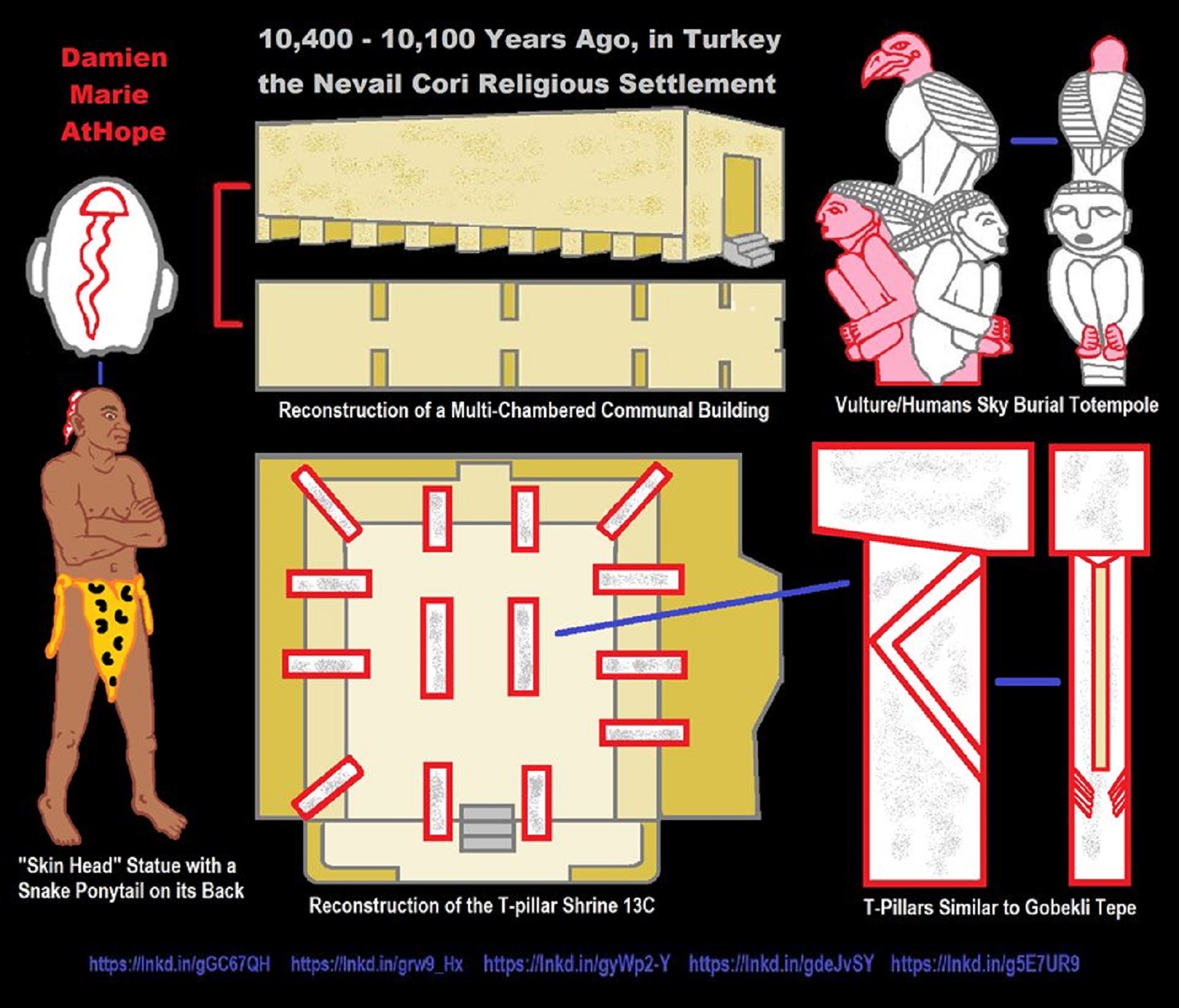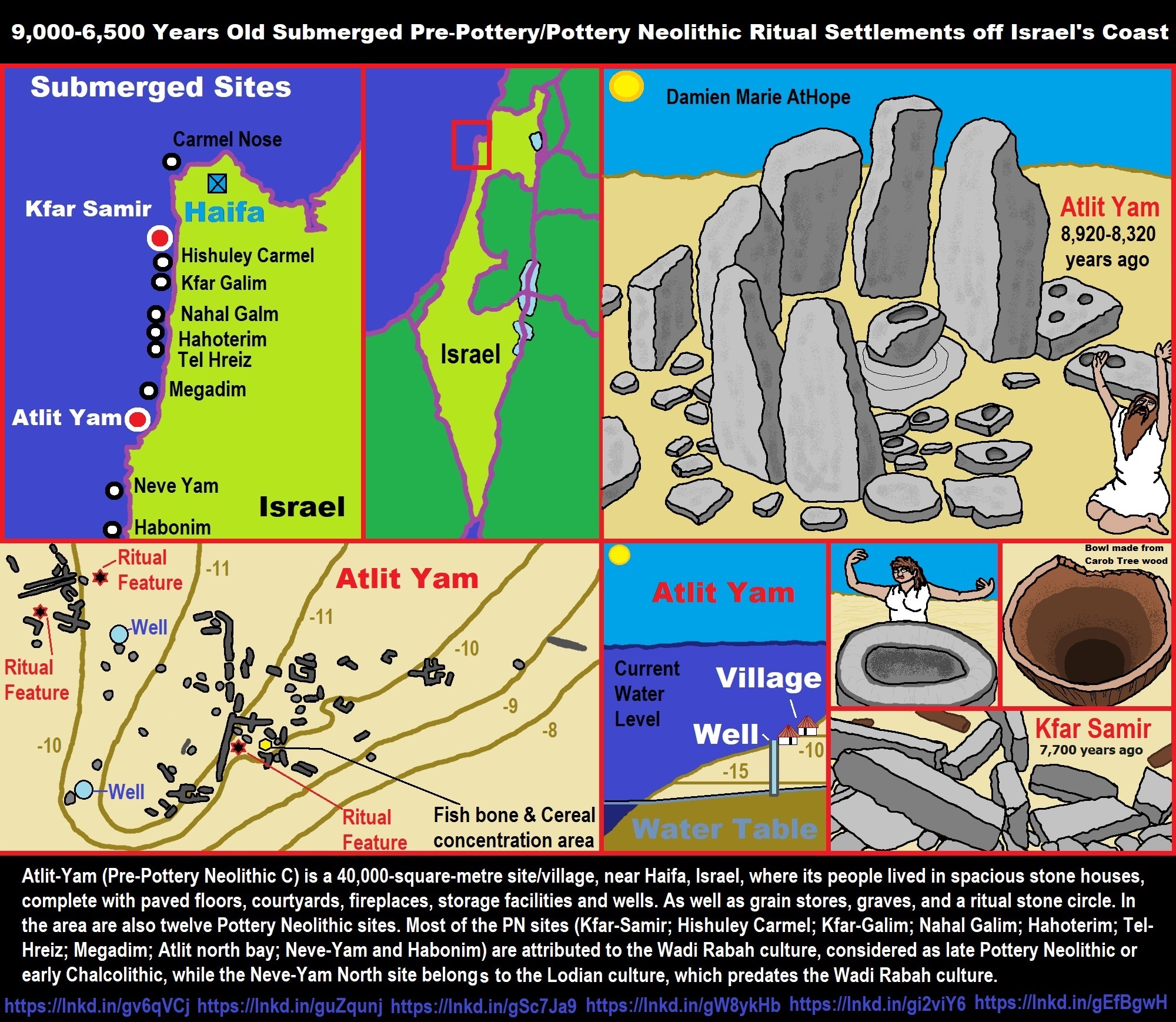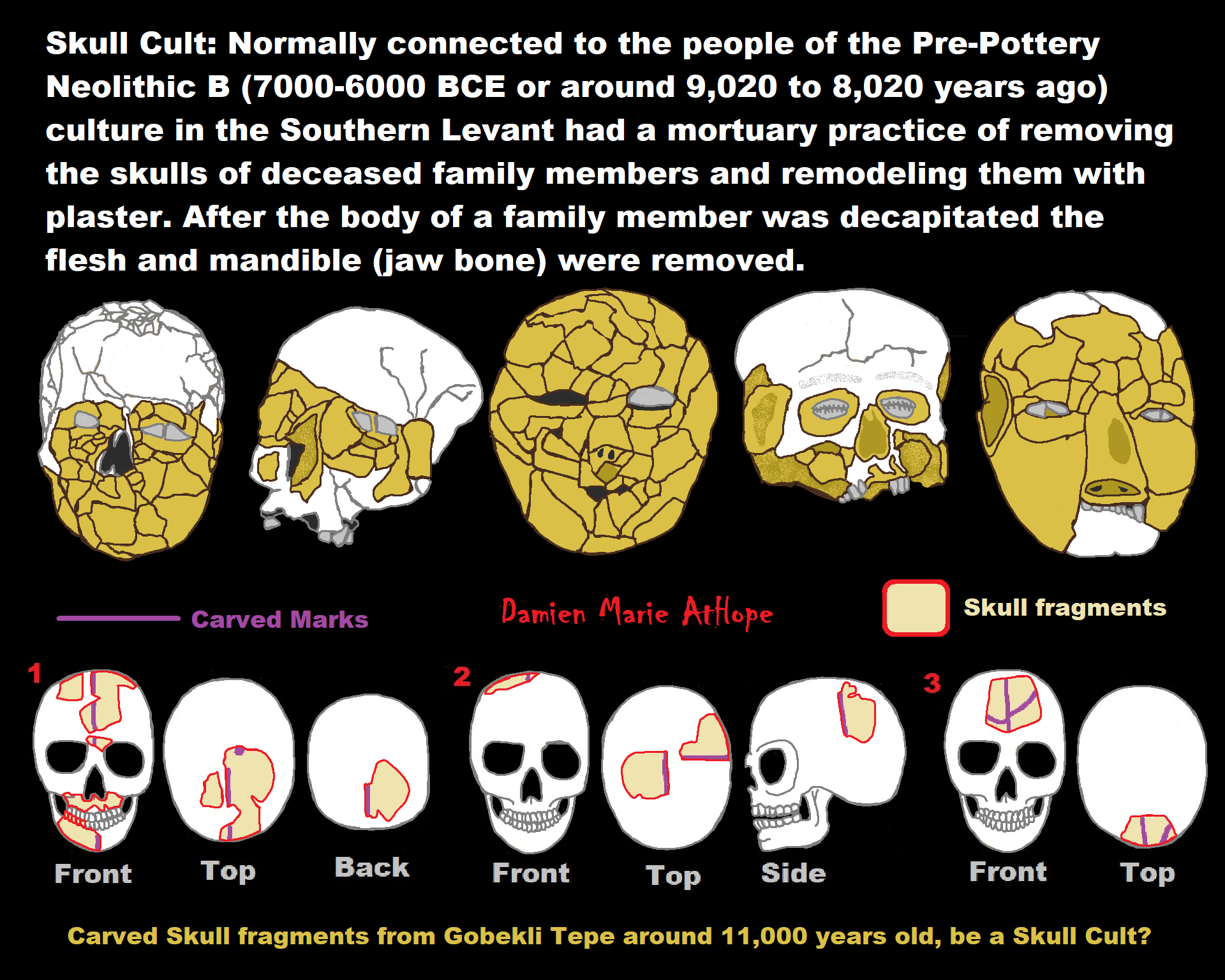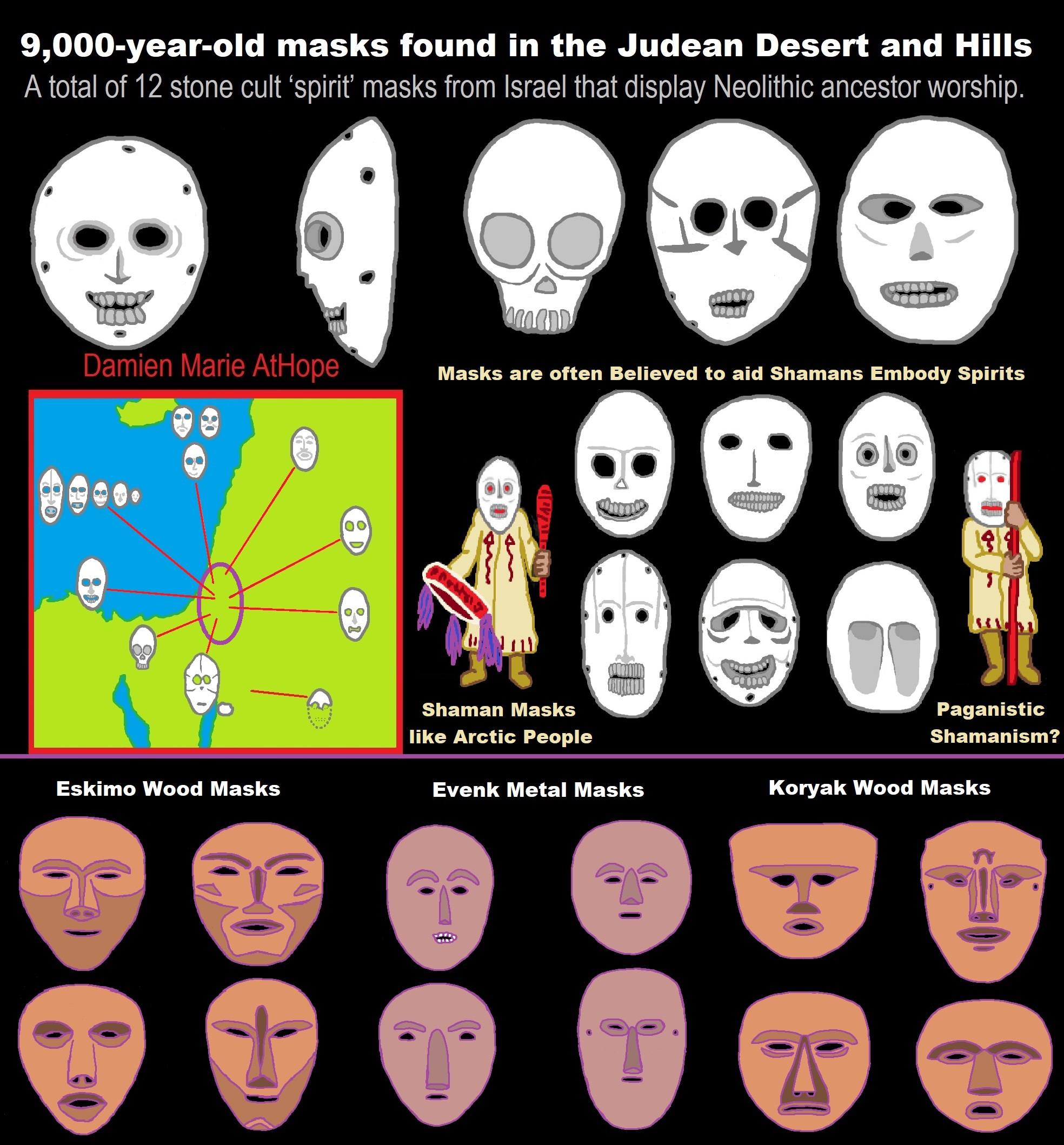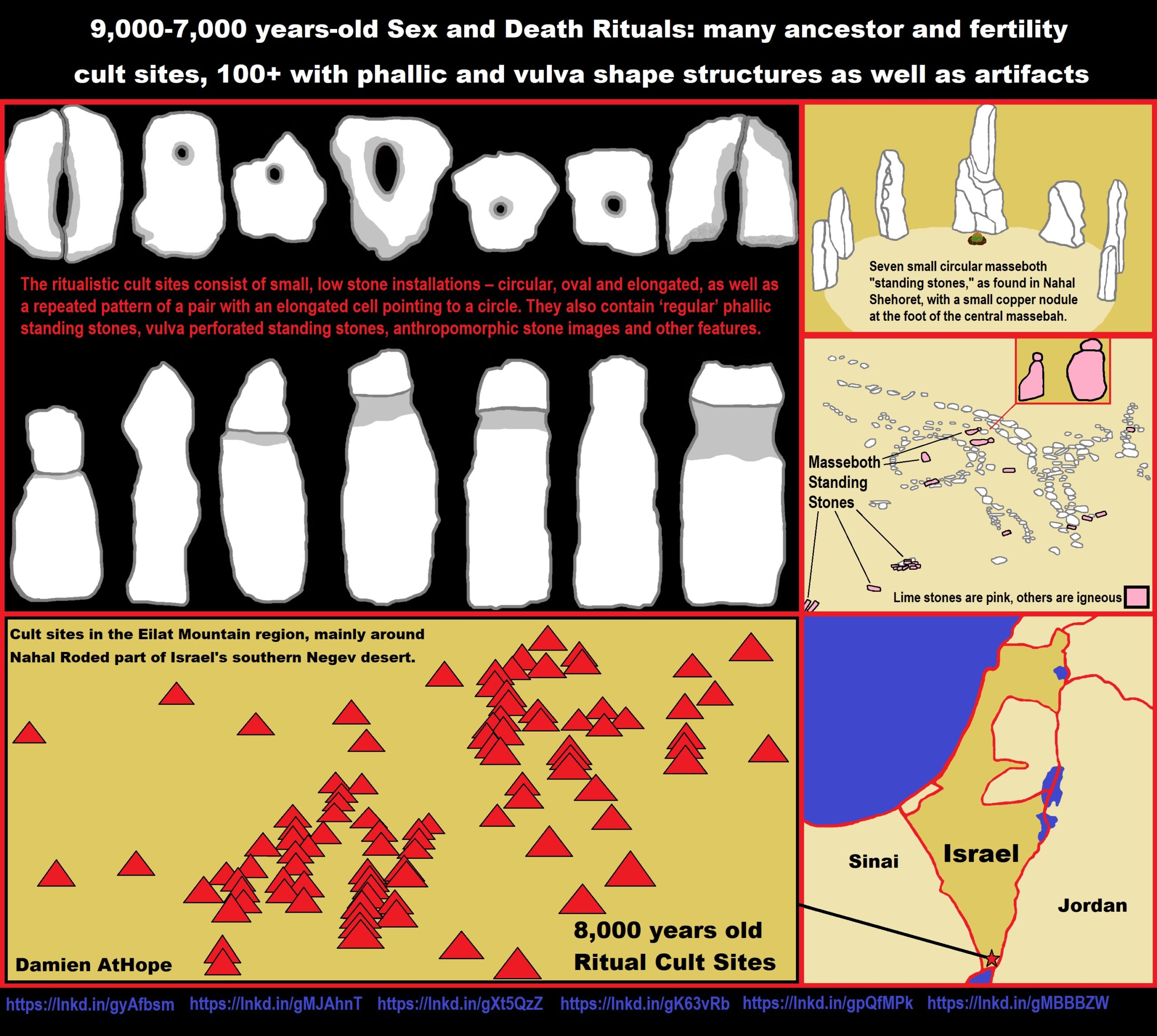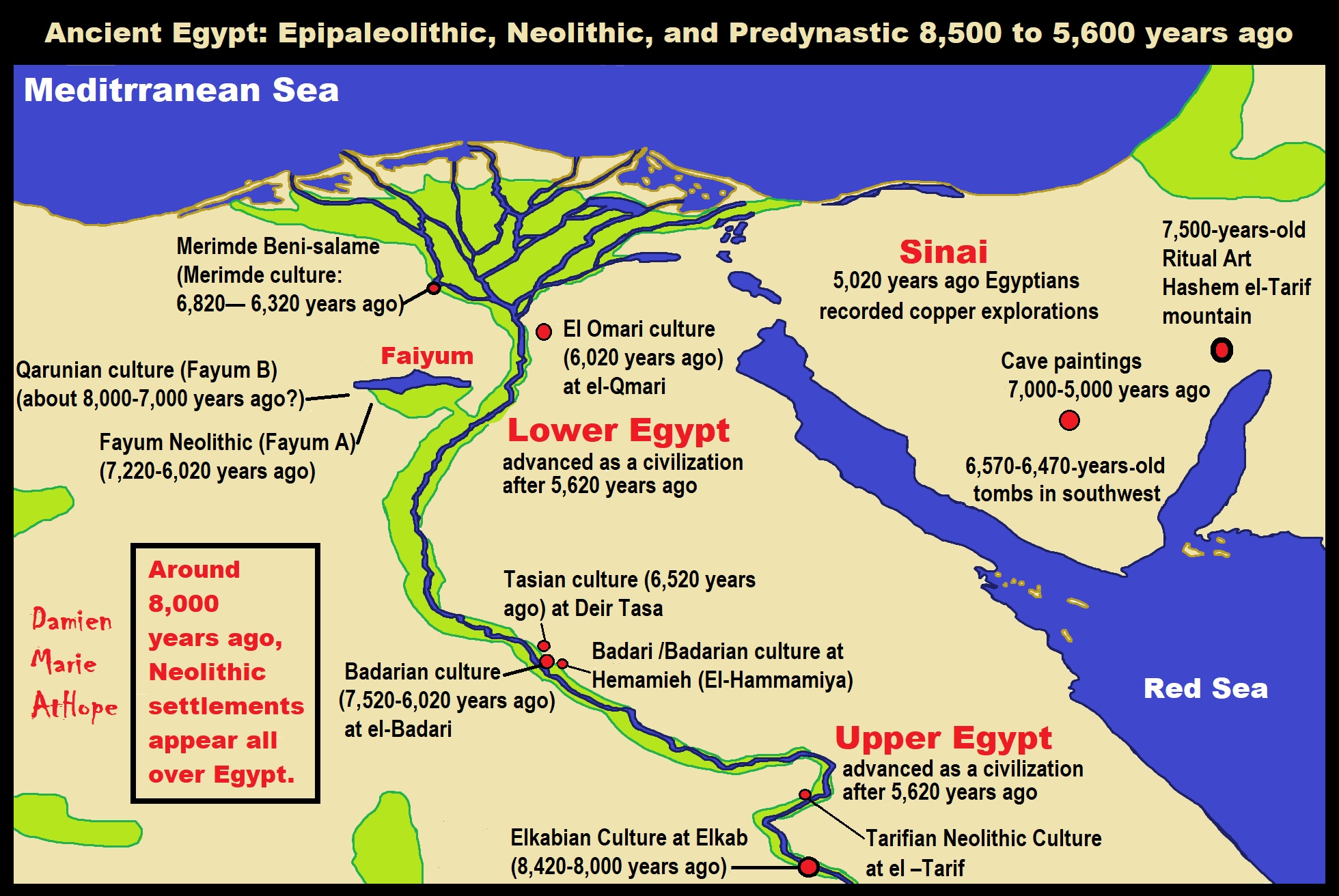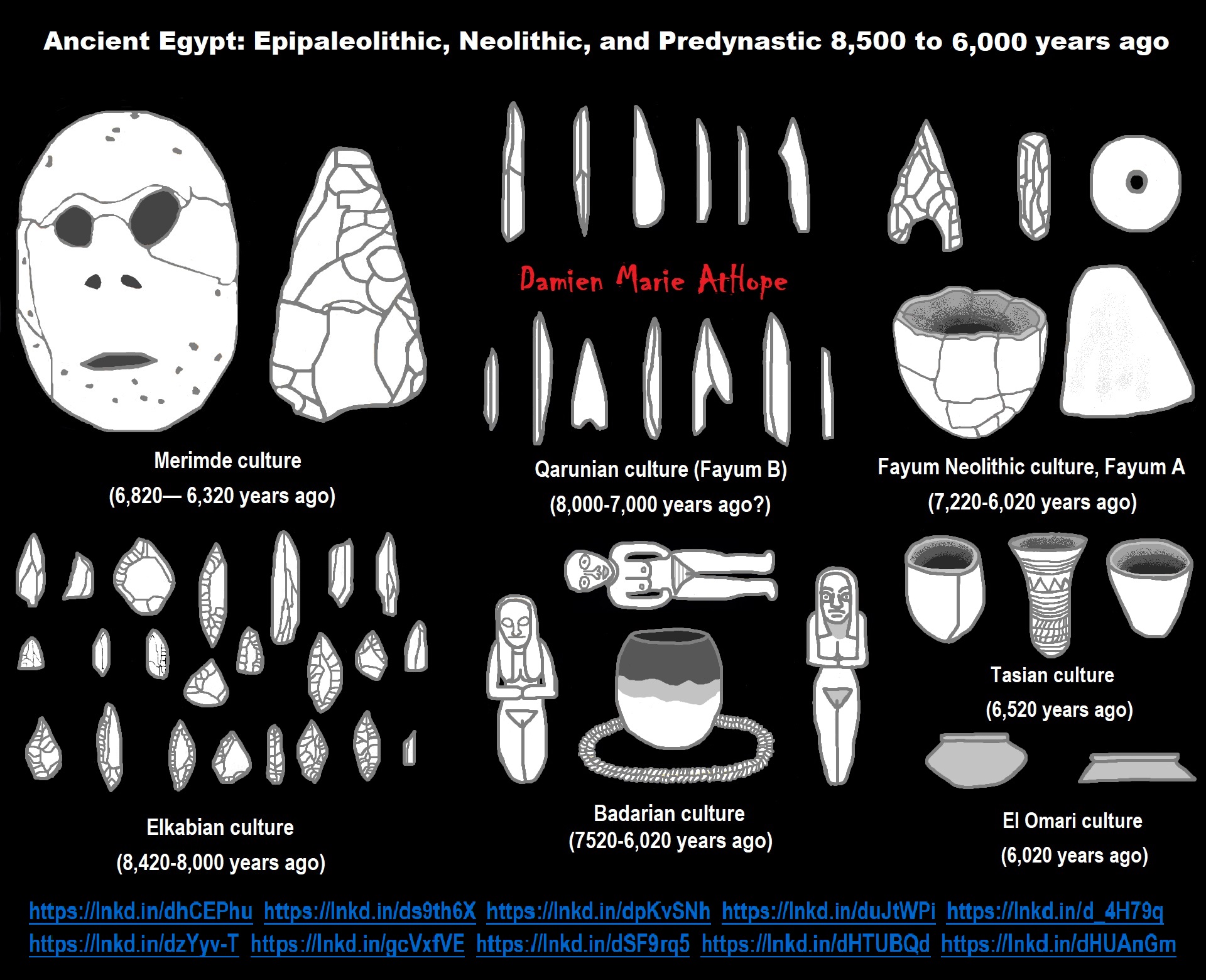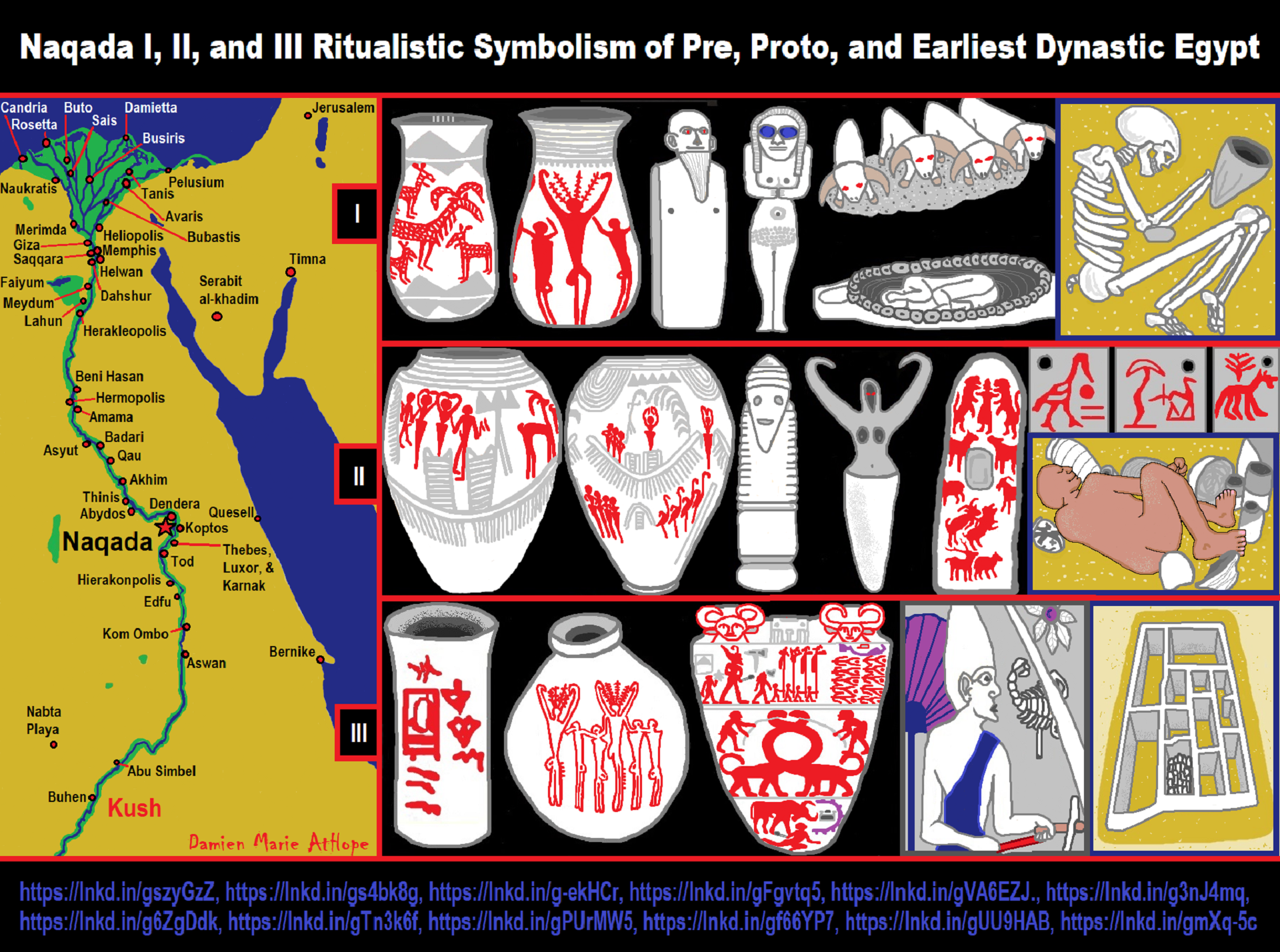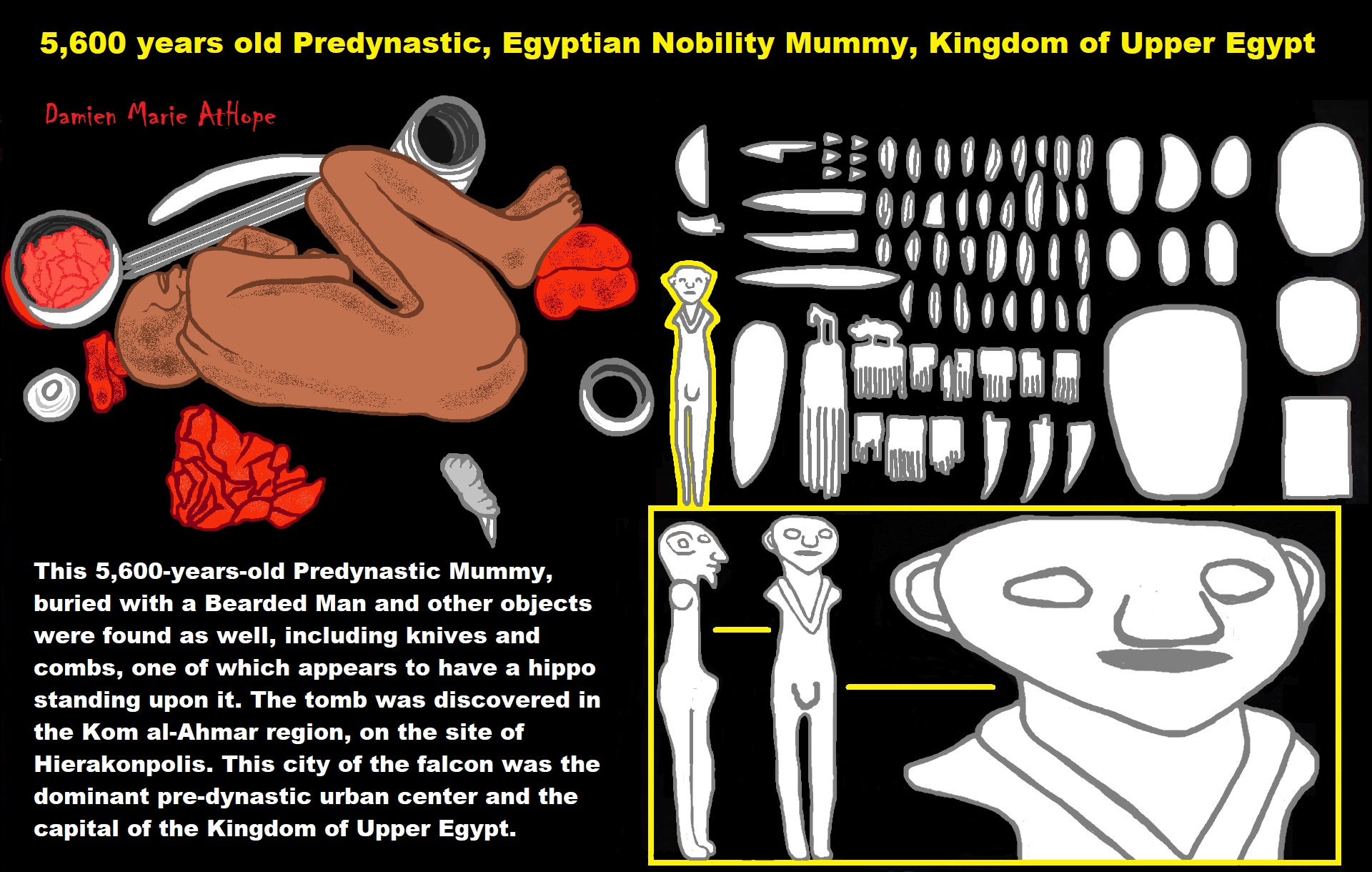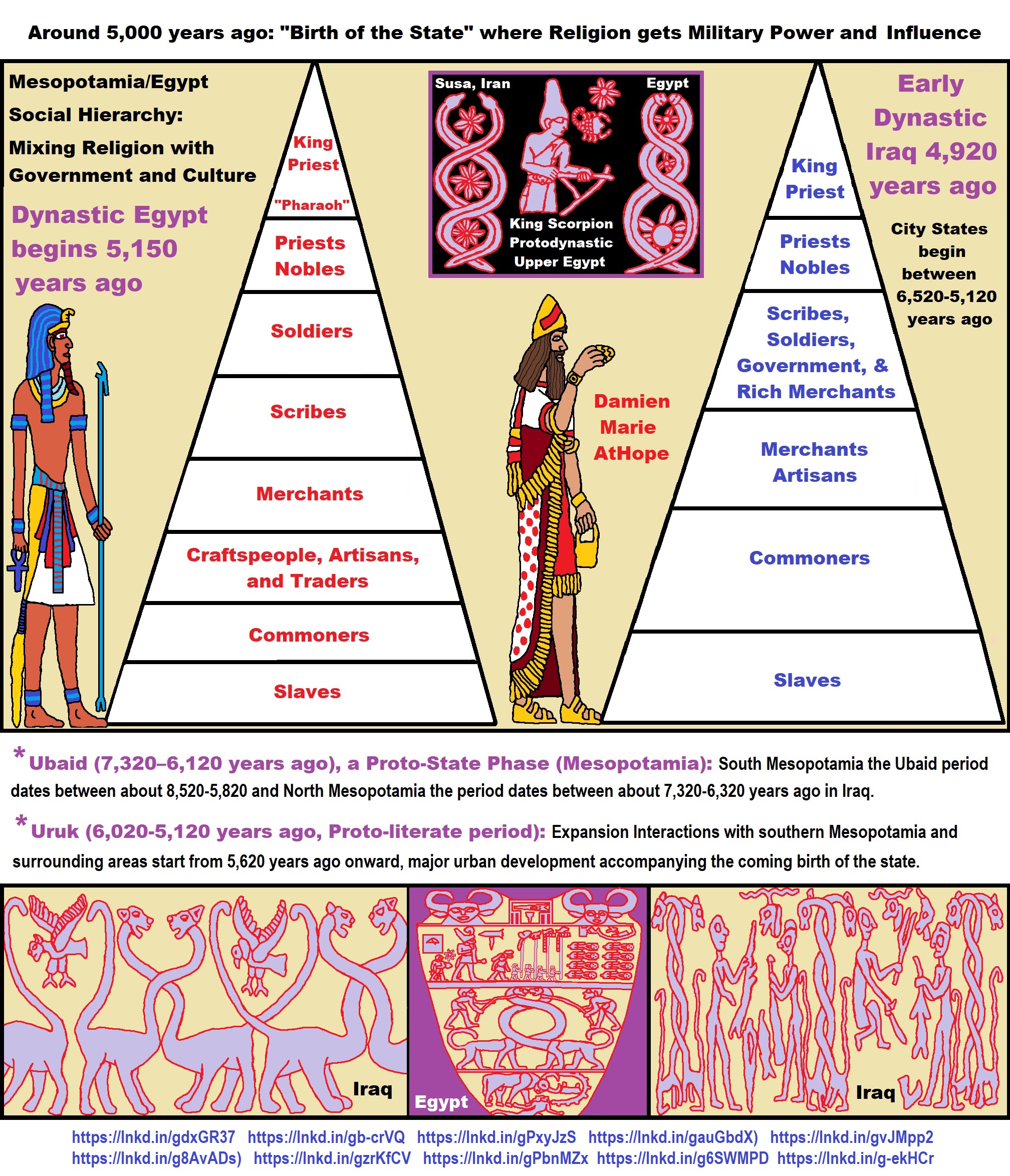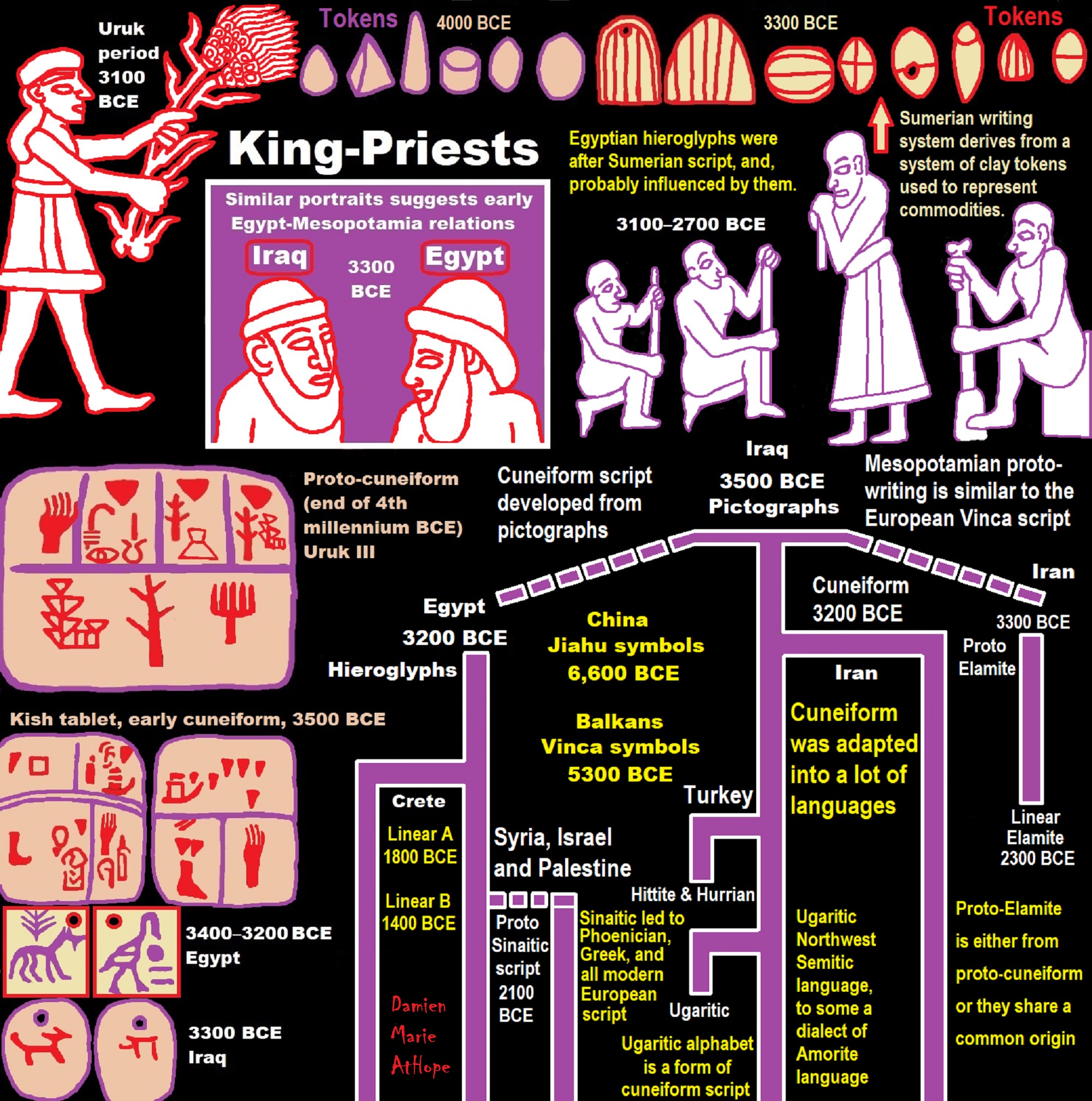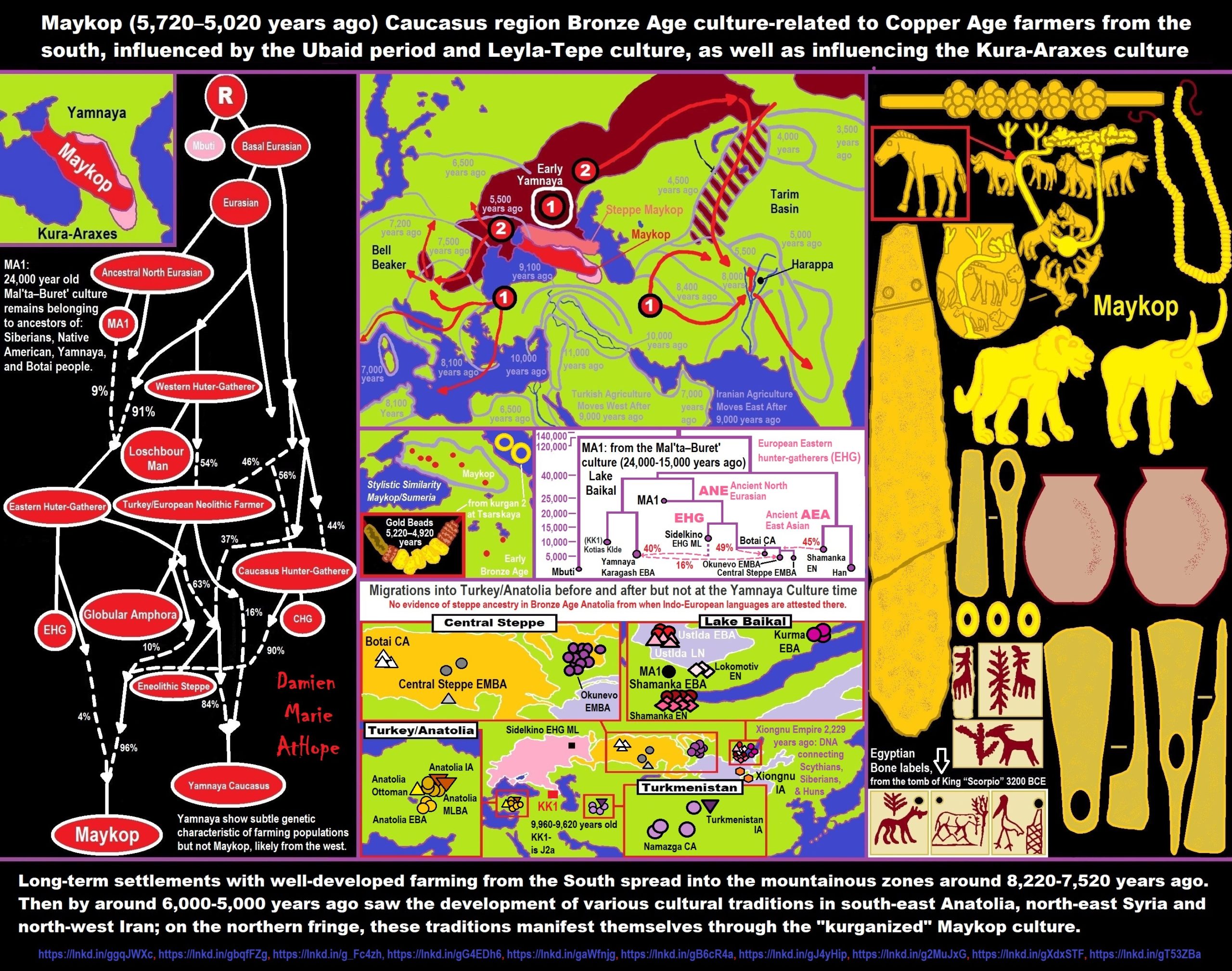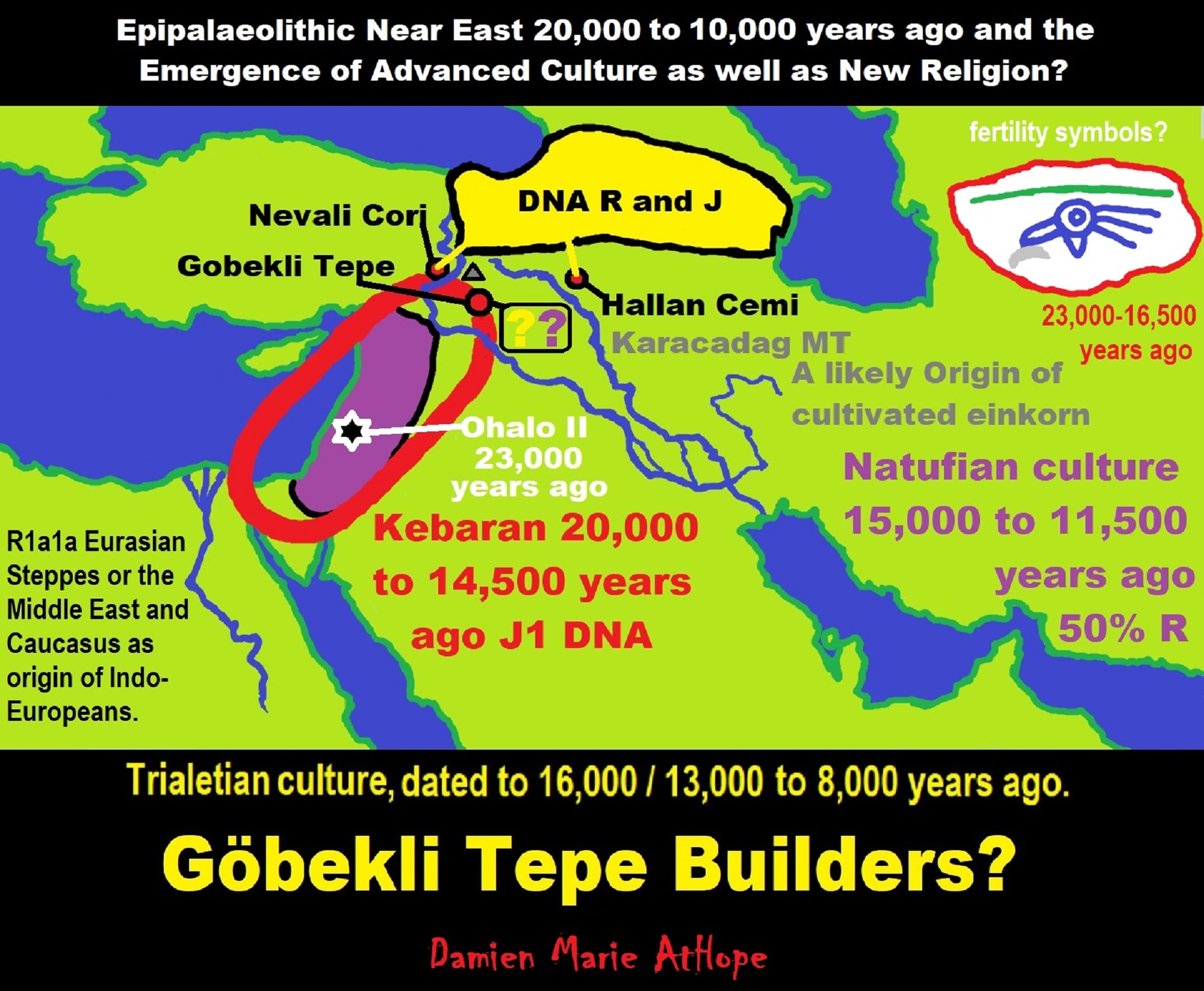
ref, ref, ref, ref, ref, ref, ref
Trialetian culture (16,000–8000 years ago) the Caucasus, Iran, and Turkey, likely involved in Göbekli Tepe. Migration 1?
Haplogroup R possible time of origin about 27,000 years in Central Asia, South Asia, or Siberia:
- Mal’ta–Buret’ culture (24,000-15,000 years ago)
- Afontova Gora culture (21,000-12,000 years ago)
- Trialetian culture (16,000–8000 years ago)
- Samara culture (7,000-6,500 years ago)
- Khvalynsk culture (7,000-6,500 years ago)
- Afanasievo culture (5,300-4,500 years ago)
- Yamna/Yamnaya Culture (5,300-4,500 years ago)
- Andronovo culture (4,000–2,900 years ago) ref
Trialetian sites
Caucasus and Transcaucasia:
- Edzani (Georgia)
- Chokh (Azerbaijan), layers E-C200
- Kotias Klde, layer B” ref
Eastern Anatolia:
- Hallan Çemi (from ca. 8.6-8.5k BC to 7.6-7.5k BCE)
- Nevali Çori shows some Trialetian admixture in a PPNB context” ref
Trialetian influences can also be found in:
- Cafer Höyük
- Boy Tepe” ref
Southeast of the Caspian Sea:
- Hotu (Iran)
- Ali Tepe (Iran) (from cal. 10,500 to 8,870 BCE)
- Belt Cave (Iran), layers 28-11 (the last remains date from ca. 6,000 BCE)
- Dam-Dam-Cheshme II (Turkmenistan), layers7,000-3,000 BCE)” ref
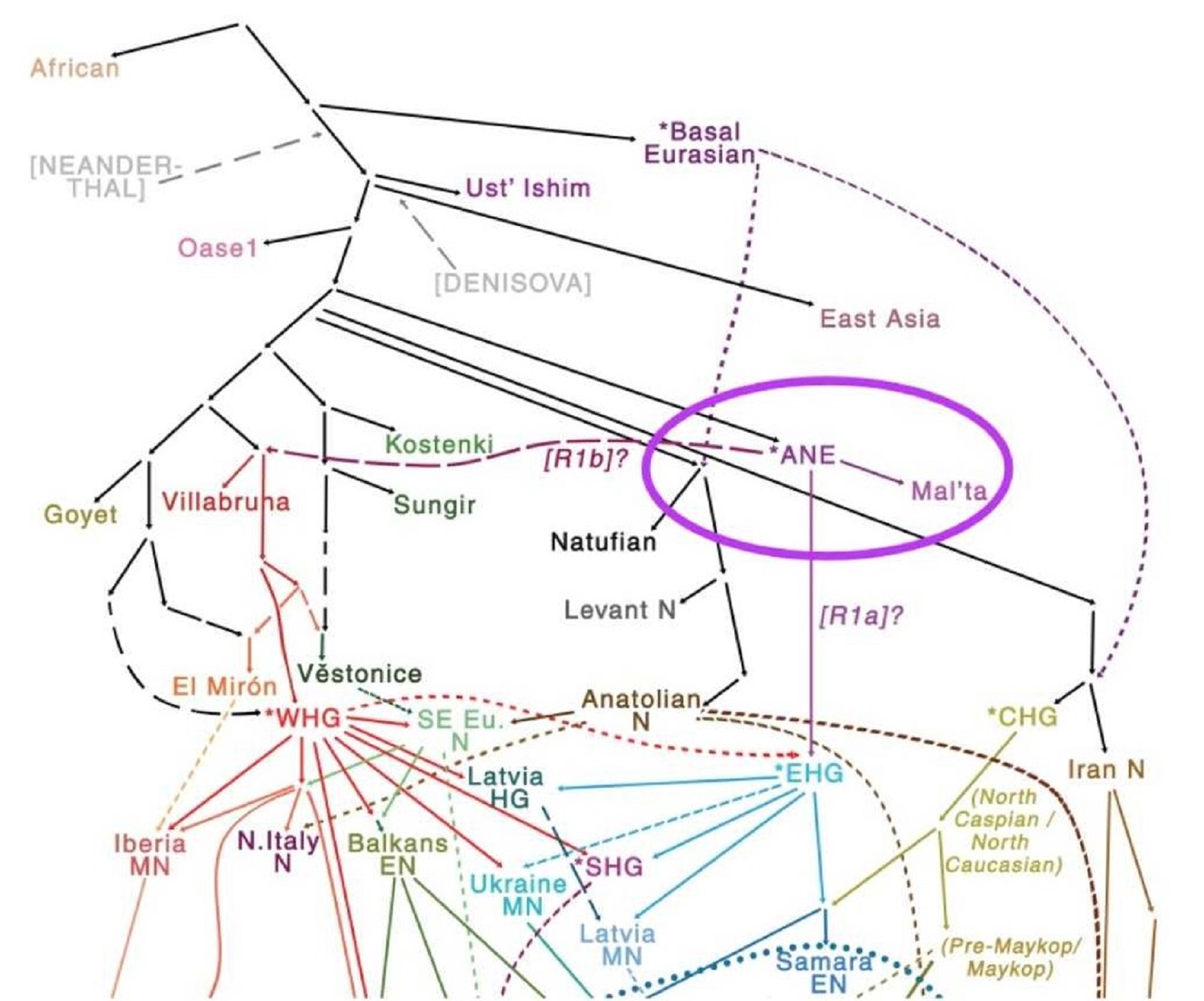

ref, ref, ref, ref, ref, ref, ref, ref, ref, ref, ref, ref, ref, ref, ref, ref, ref, ref, ref
Here are my thoughts/speculations on where I believe is the possible origin of shamanism, which may have begun sometime around 35,000 to 30,000 years ago seen in the emergence of the Gravettian culture, just to outline his thinking, on what thousands of years later led to evolved Asian shamanism, in general, and thus WU shamanism as well. In both Europe-related “shamanism-possible burials” and in Gravettian mitochondrial DNA is a seeming connection to Haplogroup U. And the first believed Shaman proposed burial belonged to Eastern Gravettians/Pavlovian culture at Dolní Věstonice in southern Moravia in the Czech Republic, which is the oldest permanent human settlement that has ever been found. It is at Dolní Věstonice where approximately 27,000-25,000 years ago a seeming female shaman was buried and also there was an ivory totem portrait figure, seemingly of her.
And my thoughts on how cultural/ritual aspects were influenced in the area of Göbekli Tepe. I think it relates to a few different cultures starting in the area before the Neolithic. Two different groups of Siberians first from northwest Siberia with U6 haplogroup 40,000 to 30,000 or so. Then R Haplogroup (mainly haplogroup R1b but also some possible R1a both related to the Ancient North Eurasians). This second group added its “R1b” DNA of around 50% to the two cultures Natufian and Trialetian. To me, it is likely both of these cultures helped create Göbekli Tepe. Then I think the female art or graffiti seen at Göbekli Tepe to me possibly relates to the Epigravettians that made it into Turkey and have similar art in North Italy. I speculate that possibly the Totem pole figurines seen first at Kostenki, next went to Mal’ta in Siberia as seen in their figurines that also seem “Totem-pole-like”, and then with the migrations of R1a it may have inspired the Shigir idol in Russia and the migrations of R1b may have inspired Göbekli Tepe.
“Migration from Siberia behind the formation of Göbeklitepe: Expert states. People who migrated from Siberia formed the Göbeklitepe, and those in Göbeklitepe migrated in five other ways to spread to the world, said experts about the 12,000-year-old Neolithic archaeological site in the southwestern province of Şanlıurfa.“ The upper paleolithic migrations between Siberia and the Near East is a process that has been confirmed by material culture documents,” he said.” ref
“Semih Güneri, a retired professor from Caucasia and Central Asia Archaeology Research Center of Dokuz Eylül University, and his colleague, Professor Ekaterine Lipnina, presented the Siberia-Göbeklitepe hypothesis they have developed in recent years at the congress held in Istanbul between June 11 and 13. There was a migration that started from Siberia 30,000 years ago and spread to all of Asia and then to Eastern and Northern Europe, Güneri said at the international congress.” ref
“The relationship of Göbeklitepe high culture with the carriers of Siberian microblade stone tool technology is no longer a secret,” he said while emphasizing that the most important branch of the migrations extended to the Near East. “The results of the genetic analyzes of Iraq’s Zagros region confirm the traces of the Siberian/North Asian indigenous people, who arrived at Zagros via the Central Asian mountainous corridor and met with the Göbeklitepe culture via Northern Iraq,” he added.” ref
“Emphasizing that the stone tool technology was transported approximately 7,000 kilometers from east to west, he said, “It is not clear whether this technology is transmitted directly to long distances by people speaking the Turkish language at the earliest, or it travels this long-distance through using way stations.” According to the archaeological documents, it is known that the Siberian people had reached the Zagros region, he said. “There seems to be a relationship between Siberian hunter-gatherers and native Zagros hunter-gatherers,” Güneri said, adding that the results of genetic studies show that Siberian people reached as far as the Zagros.” ref
“There were three waves of migration of Turkish tribes from the Southern Siberia to Europe,” said Osman Karatay, a professor from Ege University. He added that most of the groups in the third wave, which took place between 2600-2400 BCE, assimilated and entered the Germanic tribes and that there was a genetic kinship between their tribes and the Turks. The professor also pointed out that there are indications that there is a technology and tool transfer from Siberia to the Göbeklitepe region and that it is not known whether people came, and if any, whether they were Turkish.” ref
“Around 12,000 years ago, there would be no ‘Turks’ as we know it today. However, there may have been tribes that we could call our ‘common ancestors,’” he added. “Talking about 30,000 years ago, it is impossible to identify and classify nations in today’s terms,” said Murat Öztürk, associate professor from İnönü University. He also said that it is not possible to determine who came to where during the migrations that were accepted to have been made thousands of years ago from Siberia. On the other hand, Mehmet Özdoğan, an academic from Istanbul University, has an idea of where “the people of Göbeklitepe migrated to.” ref
“According to Özdoğan, “the people of Göbeklitepe turned into farmers, and they could not stand the pressure of the overwhelming clergy and started to migrate to five ways.” “Migrations take place primarily in groups. One of the five routes extends to the Caucasus, another from Iran to Central Asia, the Mediterranean coast to Spain, Thrace and [the northwestern province of] Kırklareli to Europe and England, and one route is to Istanbul via [Istanbul’s neighboring province of] Sakarya and stops,” Özdoğan said. In a very short time after the migration of farmers in Göbeklitepe, 300 settlements were established only around northern Greece, Bulgaria, and Thrace. “Those who remained in Göbeklitepe pulled the trigger of Mesopotamian civilization in the following periods, and those who migrated to Mesopotamia started irrigated agriculture before the Sumerians,” he said.” ref

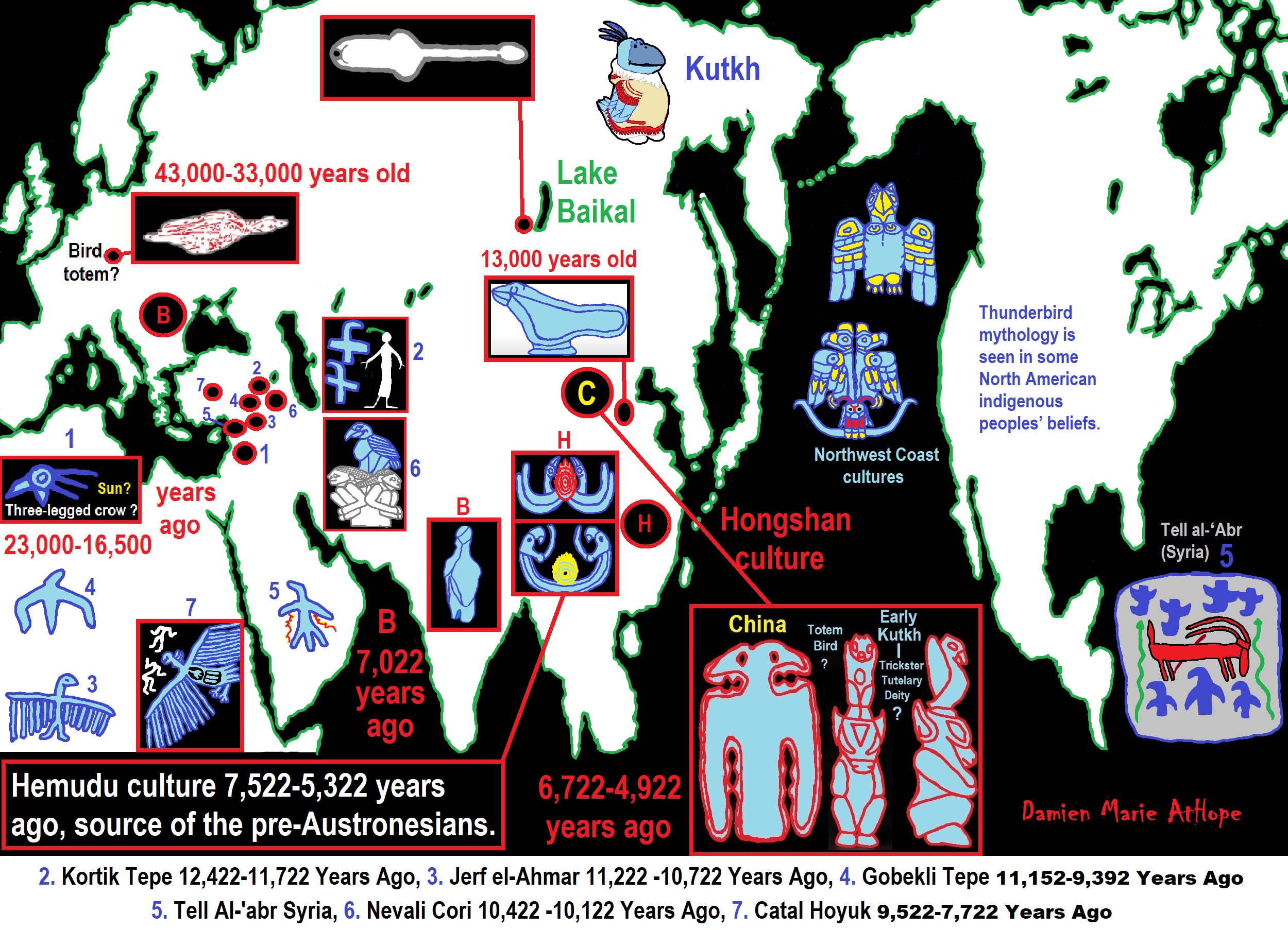
ref, ref, ref, ref, ref, ref, ref, ref, ref, ref, ref, ref, ref, ref
1. Kebaran culture 23,022-16,522 Years Ago, 2. Kortik Tepe 12,422-11,722 Years Ago, 3. Jerf el-Ahmar 11,222 -10,722 Years Ago, 4. Gobekli Tepe 11,152-9,392 Years Ago, 5. Tell Al-‘abrUbaid and Uruk Periods, 6. Nevali Cori 10,422 -10,122 Years Ago, 7. Catal Hoyuk 9,522-7,722 Years Ago
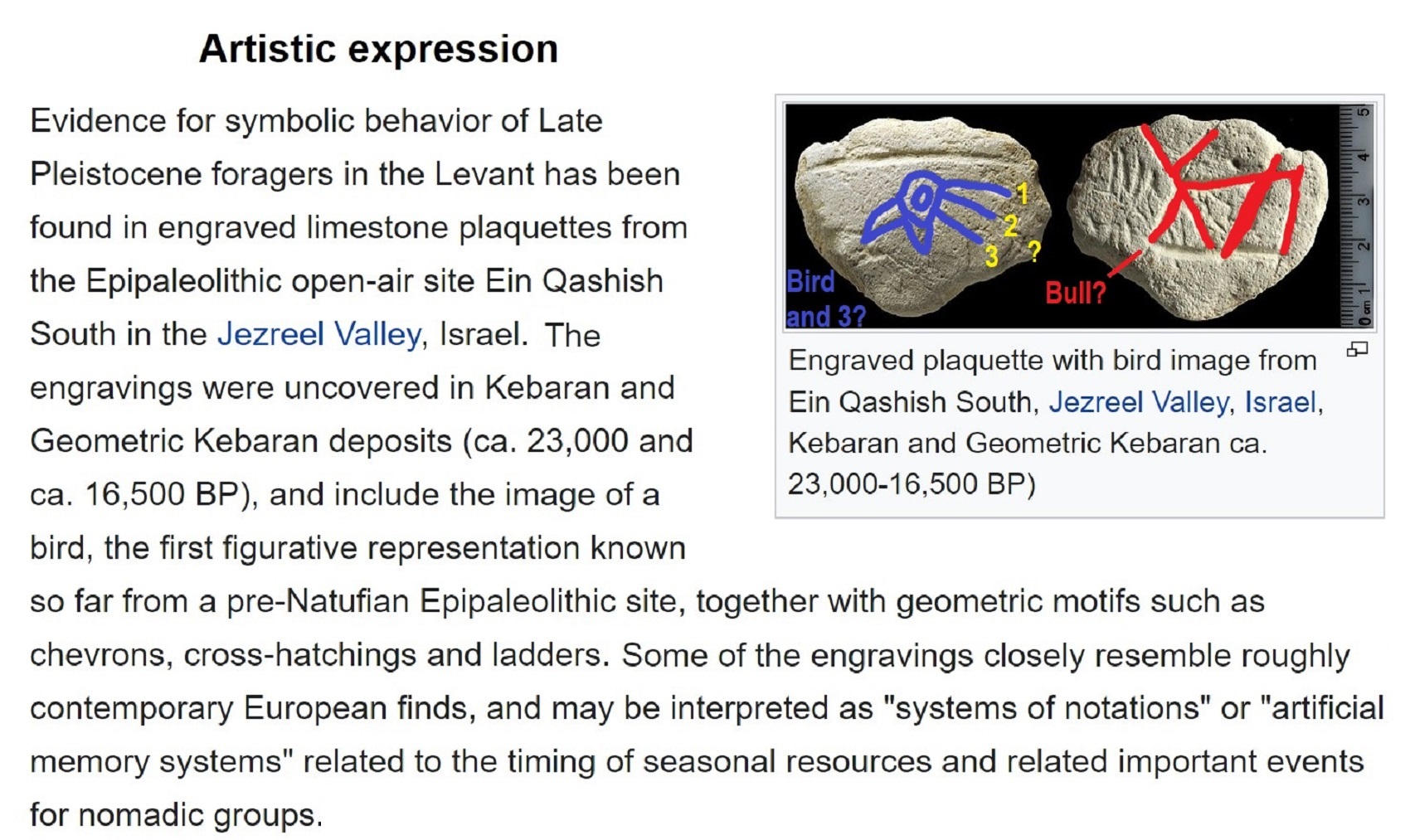
Epipalaeolithic Near East 20,000 to 10,000 years ago
“The period may be subdivided into Early, Middle, and Late Epipalaeolithic: The Early Epipalaeolithic corresponds to the Kebaran culture, c. 20,000 to 14,500 years ago, the Middle Epipalaeolithic is the Geometric Kebaran or late phase of the Kebaran, and the Late Epipalaeolithic to the Natufian, 14,500–11,500 years ago. The Natufian overlaps with the incipient Neolithic Revolution, the Pre-Pottery Neolithic A.” ref
“The Epipalaeolithic Near East designates the Epipalaeolithic (“Final Old Stone Age”, also known as Mesolithic) in the prehistory of the Near East. It is the period after the Upper Palaeolithic and before the Neolithic, between approximately 20,000 and 10,000 years ago. The people of the Epipalaeolithic were nomadic hunter-gatherers who generally lived in small, seasonal camps rather than permanent villages. They made sophisticated stone tools using microliths—small, finely-produced blades that were hafted in wooden implements. These are the primary artifacts by which archaeologists recognize and classify Epipalaeolithic sites.” ref
“The start of the Epipalaeolithic is defined by the appearance of microliths. Although this is an arbitrary boundary, the Epipalaeolithic does differ significantly from the preceding Upper Palaeolithic. Epipalaeolithic sites are more numerous, better preserved, and can be accurately radiocarbon dated. The period coincides with the gradual retreat of glacial climatic conditions between the Last Glacial Maximum and the start of the Holocene, and it is characterized by population growth and economic intensification. The Epipalaeolithic ended with the “Neolithic Revolution” and the onset of domestication, food production, and sedentism, although archaeologists now recognize that these trends began in the Epipalaeolithic.” ref
“The Early Epipalaeolithic, also known as Kebaran, lasted from 20,000 to 12,150 years ago. It followed the Upper Paleolithic Levantine Aurignacian (formerly called Antelian) period throughout the Levant. By the end of the Levantine Aurignacian, gradual changes took place in stone industries. Small stone tools called microliths and retouched bladelets can be found for the first time. The microliths of this culture period differ markedly from the Aurignacian artifacts.” ref
“By 18,000 BP the climate and environment had changed, starting a period of transition. The Levant became more arid and the forest vegetation retreated, to be replaced by steppe. The cool and dry period ended at the beginning of Mesolithic 1. The hunter-gatherers of the Aurignacian would have had to modify their way of living and their pattern of settlement to adapt to the changing conditions. The crystallization of these new patterns resulted in Mesolithic 1. The people developed new types of settlements and new stone industries.” ref
“The inhabitants of a small Mesolithic 1 site in the Levant left little more than their chipped stone tools behind. The industry was of small tools made of bladelets struck off single-platform cores. Besides bladelets, burins and end-scrapers have been found. A few bone tools and some ground stones have also been found. These so-called Mesolithic sites of Asia are far less numerous than those of the Neolithic, and the archeological remains are very poor. The type site is Kebara Cave south of Haifa. The Kebaran was characterized by small, geometric microliths. The people were thought to lack the specialized grinders and pounders found in later Near Eastern cultures.” ref
“The Kebaran is preceded by the Athlitian phase of the Levantine Aurignacian (formerly called Antelian) and followed by the proto-agrarian Natufian culture of the Epipalaeolithic. The appearance of the Kebarian culture, of microlithic type, implies a significant rupture in the cultural continuity of Levantine Upper Paleolithic. The Kebaran culture, with its use of microliths, is associated also with the use of the bow and arrow and the domestication of the dog.” ref
“The Kebaran is also characterised by the earliest collecting and processing of wild cereals, known due to the excavation of grain-grinding tools. This was the first step towards the Neolithic Revolution. The Kebaran people are believed to have migrated seasonally, dispersing to upland environments in the summer, and gathering in caves and rock shelters near lowland lakes in the winter. This diversity of environments may be the reason for the variety of tools found in their toolkits. The Kebaran is generally thought to have been ancestral to the later Natufian culture that occupied much of the same range.” ref
Harvesting of cereals: Neolithic revolution
“The earliest evidence for the use of composite cereal harvesting tools are the glossed flint blades that have been found at the site of Ohalo II, a 23,000-year-old fisher-hunter-gatherers’ camp on the shore of the Sea of Galilee, Northern Israel. The Ohalo site is dated at the junction of the Upper Paleolithic and the Early Epipalaeolithic, and has been attributed to both periods. The wear traces on the tools indicate that these were used for harvesting near-ripe, semi-green wild cereals, shortly before grains ripen enough to disperse naturally.” ref
“The study shows that the tools were not used intensively, and they reflect two harvesting modes: flint knives held by hand and inserts hafted into a handle. The finds reveal the existence of cereal harvesting techniques and tools some 8,000 years before the Natufian, and 12,000 years before the establishment of sedentary farming communities in the Near East during the Neolithic Revolution. Furthermore, the new finds accord well with evidence for the earliest ever cereal cultivation at the site and the use of stone-made grinding implements.” ref
Artistic expression in the Kebaran culture
“Evidence for symbolic behavior of Late Pleistocene foragers in the Levant has been found in engraved limestone plaquettes from the Epipalaeolithic open-air site Ein Qashish South in the Jezreel Valley, Israel. The engravings were uncovered in Kebaran and Geometric Kebaran deposits (ca. 23,000 to 16,500 years ago), and include the image of a bird, the first figurative representation known so far from a pre-Natufian Epipalaeolithic site, together with geometric motifs such as chevrons, cross-hatchings, and ladders.” ref
“Some of the engravings closely resemble roughly contemporary European finds, and may be interpreted as “systems of notations” or “artificial memory systems” related to the timing of seasonal resources and related important events for nomadic groups. Similar-looking signs and patterns are well known from the context of the local Natufian, a final Epipalaeolithic period when sedentary or semi-sedentary foragers started practicing agriculture.” ref
Late Epipalaeolithic
Further information: Khiamian
“The Late Epipalaeolithic is also called the Natufian culture. This period is characterized by the early rise of agriculture, which later emerged more fully in the Neolithic period. Radiocarbon dating places the Natufian culture between 12,500 and 9500 BCE, just before the end of the Pleistocene. This period is characterized by the beginning of agriculture.” ref
“The Natufian culture is commonly split into two subperiods: Early Natufian (12,500–10,800 BCE) (Christopher Delage gives 13,700–11,500 BCE) and Late Natufian (10,800–9500 BCE). The Late Natufian most likely occurred in tandem with the Younger Dryas. The following period is often called the Pre-Pottery Neolithic. Until recently, it was thought that the Arabian Peninsula was too arid and inhospitable for human settlement in the Late Pleistocene. The earliest known sites belonged to the early Neolithic, c. 9000 to 8000 BP, and it was supposed that people were able to recolonize the region then due to the wetter climate of the early Holocene.” ref
“However, in 2014, archaeologists working in the southern Nefud desert discovered an Epipalaeolithic site dating to between 12,000 and 10,000 BP. The site is located in the Jubbah basin, a palaeolake which retained water in the otherwise dry conditions of the Terminal Pleistocene. The stone tools found bore a close resemblance to the Geometric Kebaran, a Levantine industry associated with the Middle Epipalaeolithic. The excavators of the site, therefore, proposed that northern Arabia was colonized by foragers from the Levant around 15,000 years ago. These groups may then have been cut off by the drying climate and retreated to refugia like the Jubbah palaeolake.” ref
“The Epipalaeolithic is best understood when discussing the southern Levant, as the period is well documented due to good preservation at the sites, at least of animal remains. The most prevalent animal food sources in the Levant during this period were: deer, gazelle, and ibex of various species, and smaller animals including birds, lizards, foxes, tortoises, and hares. Less common were aurochs, wild equids, wild boar, wild cattle, and hartebeest.” ref
“At Neve David near Haifa, 15 mammal species were found, and two reptile species. Despite then being very close to the coast, the rather small number of seashells found (7 genera) and the piercing of many, suggests these may have been collected as ornaments rather than food. However, the period seems to be marked by an increase in plant foods and a decrease in meat-eating.” ref
“Over 40 plant species have been found by analyzing one site in the Jordan Valley, and some grains were processed and baked. Stones with evidence of grinding have been found. These were most likely the main food sources throughout the Pre-Pottery Neolithic A, which introduced the widespread agricultural growing of crops.” ref
See also
- Caucasian Epipalaeolithic
- Levantine archaeology
- Levantine Aurignacian
- List of archaeological periods (Levant)
- Mesolithic Europe
Kebaran culture
“The Kebaran culture, also known as the Early Near East Epipalaeolithic, was an archaeological culture in the eastern Mediterranean area (c. 19,000 to 12,000 BP), named after its type site, Kebara Cave south of Haifa. The Kebaran were a highly mobile nomadic population, composed of hunters and gatherers in the Levant and Sinai areas who used microlithic tools.” ref
“The Kebaran is the last Upper Paleolithic phase of the Levant (Syria, Jordan, Lebanon, and Israel). Kebaran stone tool assemblages are characterized by small, geometric microliths, and are thought to have lacked the specialized grinders and pounders found in later Near Eastern cultures. Small stone tools called microliths and retouched bladelets can be found for the first time. The microliths of this culture period differ greatly from the Aurignacian artifacts.” ref
“The Kebaran is preceded by the Athlitian phase of the Upper Paleolithic Levantine Aurignacian (formerly called Antelian) and followed by the proto-agrarian Natufian culture of the Epipalaeolithic. The appearance of the Kebarian culture, of microlithic type, implies a significant rupture in the cultural continuity of Levantine Upper Paleolithic. The Kebaran culture, with its use of microliths, is associated with the use of the bow and arrow and the domestication of the dog.” ref
“The Kebaran is also characterized by the earliest collecting of wild cereals, known due to the uncovering of grain grinding tools. It was the first step towards the Neolithic Revolution. The Kebaran people are believed to have practiced dispersal to upland environments in the summer, and aggregation in caves and rock shelters near lowland lakes in the winter. This diversity of environments may be the reason for the variety of tools found in their kits.” ref
“Situated in the Terminal Pleistocene, the Kebaran is classified as an Epipalaeolithic society. They are generally thought to have been ancestral to the later Natufian culture that occupied much of the same range, who advanced the use of wild grains, building on the Kebaran traits to acquire some symptoms of permanent settlements, agriculture, and hints of civilization.” ref
“Evidence for symbolic behavior of Late Pleistocene foragers in the Levant has been found in engraved limestone plaquettes from the Epipaleolithic open-air site Ein Qashish South in the Jezreel Valley, Israel. The engravings were uncovered in Kebaran and Geometric Kebaran deposits (ca. 23,000 and ca. 16,500 BP), and include the image of a bird, the first figurative representation known so far from a pre-Natufian Epipaleolithic site, together with geometric motifs such as chevrons, cross-hatchings, and ladders.” ref
“Some of the engravings closely resemble roughly contemporary European finds, and may be interpreted as “systems of notations” or “artificial memory systems” related to the timing of seasonal resources and related important events for nomadic groups. Similar looking signs and patterns are well known from the context of the local Natufian, a final Epipaleolithic period when sedentary or semi-sedentary foragers started practicing agriculture.” ref
“The engravings found in Ein Qashish South involve symbolic conceptualization. They suggest that the figurative and non-figurative images comprise a coherent assemblage of symbols that might have been applied in order to store, share and transmit information related to the social activities and the subsistence of mobile bands. They also suggest a level of social complexity in pre-Natufian foragers in the Levant. The apparent similarity in graphics throughout the Late Pleistocene world and the mode of their application support the possibility that symbolic behavior has a common and much earlier origin.” ref
Ohalo II
“Ohalo II is an archaeological site in Israel, near Kinneret, on the southwest shore of the Sea of Galilee. It is one of the best preserved hunter-gatherer archaeological sites of the Last Glacial Maximum, radiocarbon dated to around 23,000 BP (calibrated). It is at the junction of the Upper Paleolithic and the Epipaleolithic, and has been attributed to both periods. The site is significant for two findings which are the world’s oldest: the earliest brushwood dwellings and evidence for the earliest small-scale plant cultivation, some 11,000 years before the onset of agriculture. The numerous fruit and cereal grain remains preserved in anaerobic conditions under silt and water are also exceedingly rare due to their general quick decomposition.” ref
“Ohalo II is the name given to the archaeological site located on the southwest shore of the Sea of Galilee in Israel’s Jordan Rift Valley. The site consists of the remains of six charcoal rings where brushwood dwellings had been during the Upper Paleolithic. The huts are oval in shape and average between 9 and 16 feet long. They were simple in design, were constructed of tree branches and brushwood, and “probably only took a few hours to make.” Hearths were located outside the huts.” ref
“In addition to the huts, the site also contains a grave and an area that was probably used as a refuse dump. The site is littered with a treasure trove of artifacts, including flints, animal bones, and remnants of fruit and cereal grains. Hundreds of species of birds, fish, fruits, vegetables, cereal grains, and large animals have been identified at the site. These finds have greatly expanded knowledge of Upper Paleolithic hunting and gathering practices.” ref
“At the time hunter-gatherers settled down at Ohalo II, the Sea of Galilee was newly formed and may have been attractive to many bands of people. After Ohalo II had been occupied for a relatively short amount of time, probably only a few generations, the village burned to the ground. Whether the burning was intentional or accidental is unknown. But what may have been tragic for its ancient inhabitants turned out to be a boon for archaeologists: at the same time as the village was destroyed, water levels at the Sea of Galilee rose and buried the site.” ref
“Fortunately, …calm, relatively deep water covered the site, and the immediate deposition of fine clay and silt layers began. Together, the water sediments sealed the site and protected the remains in situ for millennia. Since then, the rate of decomposition has been extremely low in the submerged anaerobic conditions and the preservation of organic material has been excellent.” ref
“This submersion (likely in combination with the charring) slowed the growth of bacteria in organic plant remains, preventing their destruction and preserving them through millennia on the lake bottom. It is possible that the rise in sea level that made preservation possible at Ohalo II was either caused by an increase in global temperature at the end of the last glacial period or by an earthquake that changed the course of the water flowing into the Sea of Galilee. The site was discovered in 1989, when an extended drought caused a 9-meter drop in water levels in the Sea of Galilee.” ref
“23,000 years ago, humans in Israel enjoyed a new bounty of food options: Changing climate seems to have expanded, rather than stressed, dietary resources in Sea of Galilee region” ref
“Ohalo II man—unusual findings in the anterior rib cage and shoulder girdle of a 19000-year-old specimen. The analysis of the skeletal remains of Ohalo II man, aged 30–40 years at death and dated to 19 000 years BP, shows advanced and highly unusual ossification of the lower costosternal cartilage; the right humerus is morphologically larger and considerably more robust than the left; degenerative changes were noted unilaterally in the right glenohumeral, acromioclavicular and claviculosternal joints.” ref
“There is a marked asymmetry of the atlas, axis, and occipital condyles. The changes in the costochondral area of the lower anterior rib cage are considered to represent an infectious chronic osteomyelitic process. The marked discrepancy in size between the left and right shoulder girdles and humeri, and the evidence of degenerative disease exclusively on one side only may be the result of a traumatic brachial plexus nerve palsy. The asymmetrical atlas and axis are most probably anatomical variants that do not reflect clinical pathology.” ref
“23,000 years ago, humans in Israel enjoyed a new bounty of food options. Over 20,000 animal remains, including reptiles, birds, and mammals, from well-preserved successive floors of a brush hut at the site. The results show that the people of Ohalo II were successfully hunting prime large game, while at the same time gathering a wide variety of fish, other small animals, and plants.” ref
“According to the authors, this evidence does not indicate a drop in food availability, but rather an abundance of multiple prey sources. They suggest that while some animals were gathered for meat, others might have been hunted for pelts (e.g.: foxes, hares) or shells (e.g.: tortoises). From this study, it seems that fluctuating climate conditions did not create food stress, at least in this region, but instead new dietary opportunities.” ref
“The researchers hope that this work at Ohalo II will serve as a model for similar investigations of human diet changes at other locations and time periods. The authors add: “The choice of a littoral habitat that could be intensively exploited year-round may be an example of niche selection. The availability of multiple food sources within a rich habitat may have driven exploitation of myriad local resources, rather than targeting mainly energetically-rich large prey.” ref
“The site is typical of Kebaran sites, containing the floors and wall bases of six oval brush huts, six open-air hearths, and a human grave. The site was occupied during the Last Glacial Maximum and has an occupation date between 18,000-21,000 RCYBP, or between 22,500 and 23,500 cal BP.” ref
“Plants include an assortment of herbs, low shrubs, flowers, and grasses, including wild barley (Hordeum spontaneum), mallow (Malva parviflora), groundsel (Senecio glaucus), thistle (Silybum marianum(), Melilotus indicus and a slew of others too numerous to mention here. The flowers at Ohalo II represent the earliest known use of flowers by Anatomically Modern Humans. Some may have been used for medicinal purposes. The edible remains are dominated by seeds from small-grained grasses and wild cereals, although nuts, fruits, and legumes are also present.” ref
“Ohalo’s collections include over 100,000 seeds, including the earliest identification of emmer wheats [Triticum dicoccoides or T. turgidum ssp. dicoccoides (körn.) Thell], in the form of several charred seeds. Other plants include wild almond (Amygdalus communis), wild olive (Olea europaea var sylvestris), wild pistachio (Pistacia atlantica), and wild grape (Vitis vinifera spp sylvestris). Three fragments of twisted and plied fibers were discovered at Ohalo; they are the oldest evidence of string-making discovered yet.” ref
Living at Ohalo II
“The floors of the six brush huts were oval in shape, with an area of between 5-12 square meters (54-130 square feet), and the entrance-way from at least two came from the
east. The largest hut was built of tree branches (tamarisk and oak) and covered by grasses. The floors of the huts were shallowly excavated prior to their construction. All of the huts were burned.” ref
“The working surface of a grinding stone found at the site was covered with barley starch grains, indicating that at least some of the plants were processed for food or medicine. Plants in evidence on the stone’s surface include wheat, barley, and oats. But the majority of the plants are believed to represent the brush used for housing. Flint, bone and wooden tools, basalt net sinkers, and hundreds of shell beads made from mollusks brought from the Mediterranean Sea were also identified.” ref
“The single grave at Ohalo II is an adult male, who had a disabled hand and a penetrating wound to his rib cage. A bone tool found near the skull is a piece of gazelle long bone incised with parallel markings. Ohalo II was discovered in 1989 when lake levels dropped. Excavations organized by the Israeli Antiquities Authority have continued at the site when lake levels permit, led by Dani Nadel.” ref
Ohalo II site, Israel; Cultivation and Proto-Weeds in Galilee 23,000 years Ago
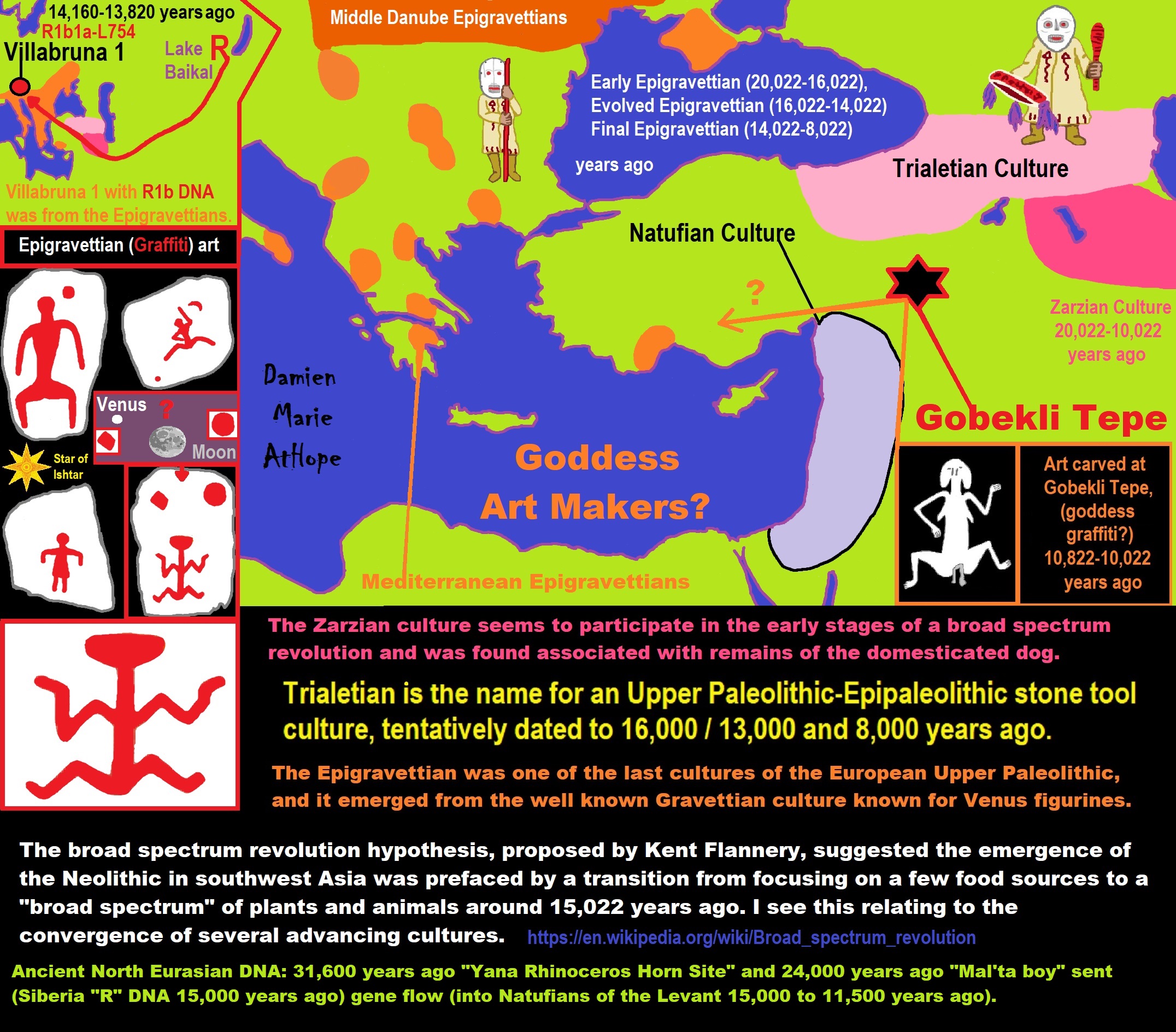
Trialetian Mesolithic
Major sites Trialeti, Shanidar Cave, Huto and Kamarband Caves, Kotias Klde, Chokh
Preceded by the Baradostian culture
Followed by the Shulaveri-Shomu culture
“Trialetian is the name for an Upper Paleolithic–Epipaleolithic stone tool industry from the South Caucasus. It is tentatively dated to the period between 16,000 / 13,000 BP and 8,000 BP. The name of the archaeological culture derives from sites in the district of Trialeti in the south Georgian Khrami river basin. These sites include Barmaksyzkaya and Edzani-Zurtaketi. In Edzani, an Upper Paleolithic site, a significant percentage of the artifacts are made of obsidian.” ref
“The Caucasian–Anatolian area of Trialetian culture was adjacent to the Iraqi–Iranian Zarzian culture to the east and south as well as the Levantine Natufian to the southwest. Alan H. Simmons describes the culture as “very poorly documented”. In contrast, recent excavations in the Valley of Qvirila river, to the north of the Trialetian region, display a Mesolithic culture. The subsistence of these groups were based on hunting Capra caucasica, wild boar, and brown bear.” ref
Trialetian sites
Caucasus and Transcaucasia:
- Edzani (Georgia)
- Chokh (Azerbaijan), layers E-C200
- Kotias Klde, layer B” ref
Eastern Anatolia:
- Hallan Çemi (from ca. 8.6-8.5k BC to 7.6-7.5k BCE)
- Nevali Çori shows some Trialetian admixture in a PPNB context” ref
Trialetian influences can also be found in:
- Cafer Höyük
- Boy Tepe” ref
Southeast of the Caspian Sea:
- Hotu (Iran)
- Ali Tepe (Iran) (from cal. 10,500 to 8,870 BCE)
- Belt Cave (Iran), layers 28-11 (the last remains date from ca. 6k BCE)
- Dam-Dam-Cheshme II (Turkmenistan), layers7-3″ ref
“The belonging of these Caspian Mesolithic sites to the Trialetian has been questioned.” ref
Relation with the Caspian Mesolithic
“Differences have been found between the Trialetian and the Caspian Mesolithic of the southeastern part of the Caspian Sea (represented by sites like Komishan, Hotu, Kamarband, and Ali Tepe), even though the Caspian Mesolithic had previously been attributed to Trialetian by Kozłowski (1994, 1996 and 1999), Kozłowski and Aurenche 2005 and Peregrine and Ember 2002. These differences have been established through a detailed study of the site of Komishan and are driven by the underlying differences at the level of cultural ecology.” ref
“While Trialetian industry developed in steppe riparian and mountain ecozones, as for example in the Khrami river and the mountainous site of Chokh respectively, the Caspian Mesolithic took place in a transitional ecotone between the sea (Caspian Sea), plain and mountains (Alborz mountain range). The Caspian Mesolithic hunter-gatherers were adapted to the exploitation of marine resources and had access to high quality raw material, whereas in the Trialetian sites as Chokh and Trialeti there is imported raw material from distances of 100 km.” ref
Relation with Kmlo-2
“Kmlo-2 is a rock shelter situated on the west slope of the Kasakh River valley, on the Aragats massif, in Armenia. This site seems to present three different phases of occupation (11-10k cal BCE, 9-8k cal BCE, and 6-5k cal BCE). The lithic industry of the three phases show similarities such as the predominance of microliths, small cores and obsidian as raw material.” ref
“The backed an scalene bladelets are the dominant type of microlith; these tools show similarities with those of the Late Upper Paleolithic of Kalavan-1 and the Mesolithic layer B of the Kotias Klde. Cultural affinities of the Kmlo-2 lithic industry with the Epipaleolithic and Aceramic Neolithic sites in Taurus-Zagros mountains have also been noted. Let us quote a few words from Gasparyan about the industry found in Apnagyugh-8 (Kmlo-2) cave that express these similarities: Let us conclude that Apnagyugh-8 industry is closer to the production complexes with traditions of Mesolithic and/or Upper Paleolithic periods.” ref
“But it’s difficult to show any culture or archaeological source in Armenia today, which belongs to these periods, preceding Apnagyugh-8 and could have been its origin or prototype. The only site that emerged before Apnagyugh-8 is Kalavan-1, an Upper Paleolithic site dating to 16th–14th millennia BCE., where microliths of geometrical forms are fully absent. Though Apnagyugh-8 industry shows some similarities with Zarzian and Trialeti cultures, analytic studies for proving this comparison are still in the process.” ref
“Layer III of Kmlo-2 contained the so-called “Kmlo tools”. Kmlo tools are characterized by “continuous and parallel retouch by pressure flaking of one or both lateral edges”. Similar tools have been found, as the associated to the Paluri-Nagutny culture in Georgia), the so-called “Çayönü tools” (Çayönü, Cafer Höyük, Shimshara), found in Neolithic sites from the 8th to 7th millennia BCE in eastern Anatolia and northern Mesopotamia, and some found in the layer A2 of the Kotias Klde cave. It has been suggested that the Kmlo tools are distinctive features of a culture established circa 9-8k cal BCE on the highlands of western Armenia and continued at least until the 6th-5th millennia calBCE. A local development of the Kmlo tools has also been hypothesized.” ref
Trialetian Final phase
“Little is known about the end of the Trialetian. 6k BC has been proposed as the time on which the decline phase took place. From this date are the first evidence of the Jeitunian, an industry that has probably evolved from the Trialetian. Also from this date are the first pieces of evidence of Neolithic materials in the Belt cave.” ref
“In the southwest corner of the Trialetian region, it has been proposed that this culture evolved towards a local version of the PPNB around 7,000 BCE, in sites as Cafer Höyük. Kozłowski suggests that the Trialetian does not seem to have a continuation in the Neolithic of Georgia (as for example in Paluri and Kobuleti). Although in the 5k BCE certain microliths similar to those of the Trialetian reappear in Shulaveris Gora (see Shulaveri-Shomu) and Irmis Gora.” ref
Trialetian Genetics
Haplogroup R possible time of origin about 27,000 years in Central Asia, South Asia, or Siberia:
- Mal’ta–Buret’ culture (24,000-15,000 years ago)
- Afontova Gora culture (21,000-12,000 years ago)
- Trialetian culture (16,000–8000 years ago)
- Samara culture (7,000-6,500 years ago)
- Khvalynsk culture (7,000-6,500 years ago)
- Afanasievo culture (5,300-4,500 years ago)
- Yamna/Yamnaya Culture (5,300-4,500 years ago)
- Andronovo culture (4,000–2,900 years ago) ref
Haplogroup R Possible time of origin about 27,000 years ago in Central Asia, South Asia, or Siberia.
“Haplogroup P1 (P-M45), the immediate ancestor of Haplogroup R, likely emerged in Southeast Asia. The SNP M207, which defines Haplogroup R, is believed to have arisen during the Upper Paleolithic era, about 27,000 years ago. Only one confirmed example of basal R* has been found, in 24,000 year old remains, known as MA1, found at Mal’ta–Buret’ culture near Lake Baikal in Siberia.” ref
“Haplogroup R is defined by the SNP M207. The bulk of Haplogroup R is represented in lineages R1a and R1b. R1a likely originated in the Eurasian Steppes, and is associated with the Kurgan culture and Proto-Indo-European expansion. It is primarily found in Central Asia, South Asia, and the Slavic peoples of Eastern Europe. R1b probably originated in Central Asia. It is the dominant haplogroup of Western Europe and also found sparsely distributed among various peoples of Asia and Africa. Its subclade R1b1b2 (M269) is the haplogroup that is most commonly found among modern European populations, especially those of Western Europe.” ref
- Haplogroup R1 (M173) Found throughout western EurasiaHaplogroup R1a (M17) Found in Central Asia, South Asia, and Central, Northern and Eastern Europe
Haplogroup R1b (M343) Found in Western Europe, West Asia, Central Asia,North Africa, and northern Cameroon - Haplogroup R2 (M124) Found in South Asia, Caucasus, Central Asia, and Eastern Europe ref
“The genome of a Mesolithic hunter-gatherer individual found at the layer A2 of the Kotias Klde rock shelter in Georgia (labeled KK1), dating from 9,700 BP, has been analyzed. This individual forms a genetic cluster with another hunter-gatherer from the Satsurblia Cave, the so-called Caucasian Hunter-Gatherer (CHG) cluster. KK1 belongs to the Y-chromosome haplogruoup J2a (an independent analysis has assigned him J2a1b-Y12379*).” ref
“Although the belonging of the Caspian Mesolithic to the Trialetian has been questioned, it is worth noting that genetic similarities have been found between an Mesolithic hunther-gatherer from the Hotu cave (labeled Iran_HotuIIIb) dating from 9,100-8,600 BCE and the CHG from Kotias Klde. The Iran_HotuIIIb individual belongs to the Y-chromosome haplogroup J (xJ2a1b3, J2b2a1a1) (an independent analysis yields J2a-CTS1085(xCTS11251,PF5073) -probably J2a2-). Then, both KK1 and Iran_HotuIIIb individuals share a paternal ancestor that lived approximately 18.7k years ago. At the autosomal level, it falls in the cluster of the CHG’s and the Iranian Neolithic Farmers.” ref
See also
- Mesolithic
- Epipaleolithic Near East
- Prehistoric Caucasus
- Prehistoric Georgia
- Prehistory of Iran
- Zarzian culture
- Natufian culture
- Caucasian Hunter-Gatherer
Caucasus hunter-gatherer
“Caucasus hunter-gatherer (CHG), also called Satsurblia Cluster is an anatomically modern human genetic lineage, first identified in a 2015 study, based on the population genetics of several modern Western Eurasian (European, Caucasian and Near Eastern) populations.” ref
“The CHG lineage descended from a population that split off the base Western Eurasian lineage very early, around 45,000 years ago, that descended separately to Ust’-Ishim man, Oase1 and European hunter-gatherers; and separated from the “Early Anatolian Farmers” (EAF) lineage later, at 25,000 years ago, during the Last Glacial Maximum. The Caucasus hunter-gatherers managed to survive in isolation through the Last Glacial Maximum as a distinct population.” ref
“At the beginning of the Neolithicum, at c. 8000 BCE, they were probably distributed across western Iran and the Caucasus, and people similar to the northern Caucasus and Iranian plateau hunter-gatherers arrived before 6000 BCE in Pakistan and north-west India. Eastern Hunter-Gatherers from the Pontic-Caspian steppes have received admixture from CHGs, leading to the formation of Western Steppe Herders (WSHs). WSHs formed the Yamnaya culture and expanded massively throughout Europe during the Late Neolithic and Early Bronze Age.” ref
“Jones et al. (2015) analyzed genomes from males from western Georgia, in the Caucasus, from the Late Upper Palaeolithic (13,300 years old) and the Mesolithic (9,700 years old). These two males carried Y-DNA haplogroup: J* and J2a, later refined to J1-FT34521, and J2-Y12379*, and mitochondrial haplogroups of K3 and H13c, respectively. Their genomes showed that a continued mixture of the Caucasians with Middle Eastern populations took place up to 25,000 years ago, when the coldest period in the last Ice Age started.” ref
“CHG ancestry was also found in an Upper Palaeolithic specimen from Satsurblia cave (dated ca. 11000 BCE), and in a Mesolithic one from Kotias Klde cave, in western Georgia (dated ca. 7700 BCE). The Satsurblia individual is closest to modern populations from the South Caucasus.” ref
“Fu et al. (2016), comparing CHG to the 13,700 year-old Bichon man genome (found in Switzerland) detected a split between CHG and “Western European Hunter-Gatherer” (WHG) lineages, about 45,000 years ago, the presumed time of the original peopling of Europe. CHG separated from the “Early Anatolian Farmers” (EAF) lineage later, at 25,000 years ago, during the Last Glacial Maximum.” ref
“Margaryan et al. (2017) analyzing South Caucasian ancient mitochondrial DNA found a rapid increase of the population at the end of the Last Glacial Maximum, about 18,000 years ago. The same study also found continuity in descent in the maternal line for 8,000 years.” ref
“According to Narasimhan et al. (2019) Iranian farmer related people arrived before 6000 BCE in Pakistan and north-west India, before the advent of farming in northern India. They suggest the possibility that this “Iranian farmer–related ancestry […] was [also] characteristic of the northern Caucasus and Iranian plateau hunter-gatherers.” ref
“The proto-Indo-Europeans, i.e. the Yamnaya people and the related cultures, seem to have been a mix from Eastern European Hunter-Gatherers (EHGs); and people related to the near east, either Caucasus hunter-gatherers or Iran Chalcolithic people, with a Caucasian hunter-gatherer component. Each of those two populations contributed about half the Yamnaya DNA.” ref
“According to co-author Andrea Manica of the University of Cambridge: The question of where the Yamnaya come from has been something of a mystery up to now […] we can now answer that, as we’ve found that their genetic make-up is a mix of Eastern European hunter-gatherers and a population from this pocket of Caucasus hunter-gatherers who weathered much of the last Ice Age in apparent isolation.” ref
“According to Jones et al. (2015), Caucasus hunter-gatherers (CHG) “genomes significantly contributed to the Yamnaya steppe herders who migrated into Europe ~3,000 BCE, supporting a formative Caucasus influence on this important Early Bronze Age culture. CHG left their imprint on modern populations from the Caucasus and also central and south Asia possibly marking the arrival of Indo-Aryan languages.” ref
“Lazaridis et al. (2016) proposes a different people, likely from Iran, as the source for the Middle Eastern ancestry of the Yamnaya people, finding that “a population related to the people of the Iran Chalcolithic contributed ~43% of the ancestry of early Bronze Age populations of the steppe“. That study asserts that these Iranian Chalcolithic people were a mixture of “the Neolithic people of western Iran, the Levant, and Caucasus Hunter Gatherers”. Gallego-Llorente et al. (2016) conclude that Iranian populations are not a likelier source of the ‘southern’ component in the Yamnaya than Caucasus hunter-gatherers.” ref
“Wang et al. (2018) analyzed genetic data of the North Caucasus of fossils dated between the 4th and 1st millennia BCE and found a correlation with modern groups of the South Caucasus, concluding that “unlike today – the Caucasus acted as a bridge rather than an insurmountable barrier to human movement”. CHG admixture was also found in South Asia, in a possible marker of the Indo-Aryan migration there.” ref
Ancient Greece and Aegean
“Beyond contributing to the population of mainland Europe through Bronze Age pastoralists of the Yamnaya, CHG also appears to have arrived on its own in the Aegean without eastern European hunter–gatherer ancestry and provided approximately 9–32% of ancestry to the Minoans. The origin of this CHG component might have been Central Anatolia.” ref
Gravettian
“The Gravettian was an archaeological industry of the European Upper Paleolithic that succeeded the Aurignacian circa 33,000 years ago. It is archaeologically the last European culture many consider unified, and had mostly disappeared by c. 22,000 years ago, close to the Last Glacial Maximum, although some elements lasted until c. 17,000 years ago. The Gravettian culture is known for Venus figurines, which were typically carved from either ivory or limestone. Archaeologists usually describe two regional variants: the western Gravettian, known mainly from cave sites in France, Spain, and Britain; and the eastern Gravettian in Central Europe and Russia. The eastern Gravettians, which include the Pavlovian culture, were specialized mammoth hunters, whose remains are usually found not in caves but in open-air sites. In Spain and France, it was succeeded by the Solutrean, and developed into or continued as the Epigravettian in Italy, the Balkans, Ukraine, and Russia.” ref
“In a genetic study published in Nature in May 2016, the remains of fourteen Gravettians were examined. The eight samples of Y-DNA analyzed were determined to be three samples of haplogroup CT, one sample of I, one sample of IJK, one sample of BT, one sample of C1a2, and one sample of F. Of the fourteen samples of mtDNA, there were thirteen samples of U and one sample of M. The majority of the sample of U belonged to the U5 and U2. In a genetic study published in Nature in November 2020, the remains of one adult male and two twin boys from a Gravettian site were examined. The Y-DNA analysis revealed that all 3 individuals belonged to haplogroup I. The 3 individuals had the same mtDNA, U5.” ref
Haplogroup U5
“The age of U5 is estimated at between 25,000 and 35,000 years old, roughly corresponding to the Gravettian culture. Approximately 11% of Europeans (10% of European-Americans) have some variant of haplogroup U5. Moreover, U5 was the predominant mtDNA of mesolithic Western Hunter Gatherers (WHG). Furthermore, U5 has been found in human remains dating from the Mesolithic in England, Germany, Lithuania, Poland, Portugal, Russia, Sweden, France, and Spain. Neolithic skeletons (~7,000 years old) that were excavated from the Avellaner cave in Catalonia, northeastern Spain included a specimen carrying haplogroup U5.” ref
“Haplogroup U5 and its subclades U5a and U5b today form the highest population concentrations in the far north, among Sami, Finns, and Estonians. However, it is spread widely at lower levels throughout Europe. This distribution, and the age of the haplogroup, indicate individuals belonging to this clade were part of the initial expansion tracking the retreat of ice sheets from Europe around 10,000 years ago. The modern Basques and Cantabrians possess almost exclusively U5b lineages (U5b1f, U5b1c1, U5b2). Additionally, haplogroup U5 is found in small frequencies and at much lower diversity in the Near East and parts of northern Africa (areas with sizable U6 concentrations), suggesting back-migration of people from Europe toward the south.” ref
Ripari Villabruna “Villabruna 1 (Italy)”
“Ripari Villabruna is a small rock shelter in northern Italy with mesolithic Epigravettian burial remains. It contains several Cro-Magnon burials, with bodies and grave goods dated to 14,000 years ago. The site has added greatly to the understanding of the neolithic development of medical and religious practises in early human communities. Villabruna 1: grave that contained the skeletal remains around 14,160 to 13,820 years. The burial took place during the first stages of the human settlement in the rock shelters. The corpse was placed into a narrow, shallow pit of 30 to 40 cm (12 to 16 in) depth, the head turned to the left with arms stretched touching the body. Six grave attachments were placed to the body’s left. The typical equipment of a hunter-gatherer included a fire stone knife, a fire stone core, another stone as hammer, a blade of fire stone, a bone tip, a pellet of ochre, and Propolis (a resinous matter, produced by bees). Limestone platelets decorated with ochre drawings had been placed on top of the tomb. Moreover, Villabruna 1 is significant in terms of the history of population genetics: the remains were found to carry Y-DNA haplogroup R1b1a-L754* (xL389,V88). This is the oldest documented example of haplogroup R1b found anywhere.” ref
Epigravettian
“The Epigravettian (Greek: epi “above, on top of”, and Gravettian) was one of the last archaeological industries and cultures of the European Upper Paleolithic. It emerged after the Last Glacial Maximum around ~21,000 years ago and is considered to be a cultural derivative of the Gravettian culture. Initially named Tardigravettian (Late Gravettian) in reference to several lithic industries found in Italy, it was later renamed in order to better emphasize its independent character. Three subphases, the Early Epigravettian (20,000 to 16,000 years ago), the Evolved Epigravettian (16,000 to 14,000 years ago), and the Final Epigravettian (14,000 to 8,000 years ago), have been established. Several Epigravettian cultural centers developed contemporaneously after 22,000 years ago in Europe. These range across southern, central, and most of eastern Europe, including southwestern France, Italy, the Balkans, the Caucasus, Ukraine, and Western Russia to the banks of the Volga River.” ref
“Its lithic complex was first documented at numerous sites in Italy. Great geographical and local variability of the facies is present, however, all sites are characterized by the predominance of microliths, such as backed blades, backed points, and bladelets with a retouched end. The Epigravettian is the last stage of the Upper Paleolithic succeeded by Mesolithic cultures after 10,000 years ago. In a genetic study published in Nature in May 2016, the remains an Epigravettian male from Ripari Villabruna in Italy were examined. He carried the paternal haplogroup R1b1 and the maternal haplogroup U5b. An Epigravettian from the Satsurblia Cave in Georgia examined in a previous study has been found to be carrying the paternal haplogroup J2 and the maternal haplogroup K3.” ref

Basal U6* back-migration Eurasia around 45,000 years ago, reaching North Africa by around 30,000 years ago.
“Haplogroup U descends from the haplogroup R mtDNA are estimated to have arisen between 43,000 and 50,000 years ago. Ancient DNA classified as belonging to the U* mtDNA haplogroup from human remains in Western Siberia, dated to around 45,000 years ago the Aurignacian archaeological culture. The Peştera Muierii 1 individual from Romania dated to around 35,000 years ago possibly the Aurignacian archaeological culture has been identified as the basal haplogroup U6* not previously found in any ancient or present-day humans. And the DNA of a 35,000-year-old individual from Europe supports a Palaeolithic back-migration to Africa.” ref, ref
“The mitogenome basal haplogroup U6* in the nucleotide mutations in the 35,000-year-old Peştera Muierii 1 (PM1) Homo sapiens remains from the Pestera Muierii cave (Romania). It is a 35,000-year-old Homo sapiens. This corresponds to the most ancient population from which all descendants belonging to this haplogroup (U6a, U6b, U6c…) derived. The findings confirm that U6 mitochondrial lineage has a Eurasian origin, supporting the hypothesis of an early back-migration from Eurasia to North Africa, starting approximately from 45.000, in the Early Upper Paleolithic.” ref
Pre-Neolithic U6 Expansion
“The oldest and largest subclade, U6a, would have appeared around the LGM. U6a lineages are thought to have spread in several waves across North Africa, probably starting around 20,000 years ago, following the northern coastline of Africa. Several U6a branches (U6a1, U6a3, U6a6, U6a6b, U6a7, and U6a7b) appear to have expanded within the Maghreb from 20,000 years ago, with some spreading to the Iberian Peninsula (U6a1, U6a1b).” ref
“DNA of seven 15,000-year-old modern humans from Taforalt Cave in northeastern Morocco and six out of seven of them belonged to haplogroup U6a (clades U6a1b, U6a6b, U6a7, and U6a7b) – the last one belonging to M1b. The six males belonged to Y-DNA haplogroup E1b1b (M78). U6b, U6c, and U6d emerged later, some time between 13,000 and 10,000 years ago, from the end of the Last Glacial period.” ref
U6 Neolithic Expansion
“U6a and U6b lineages underwent the most spectacular expansion since the Neolithic period, spreading from the Maghreb to West Africa (U6a3c, U6a3f, U6a5, U6b) and the Canary Islands (U6b1a), and crossing the Sahara all the way to the Sudan to Arabia (U6a3d). This expansion might have been carried by the arrival of domesticated cattle from the Middle East by men belonging to Y-haplogroup R1b-V88 as U6b is typically found in herding populations in which both R1b-V88 and U6b are present, including the Berbers of the Maghreb, the Fulani people of the Sahel and the Hausa people of Sudan.” ref
“R1b-V88 cattle herders are believed to have started advancing into northern Africa during the Neolithic Subpluvial (c. 7250 BCE to 3250 BCE), when the Sahara was considerably wetter and greener than today, and would have reached the Maghreb by 4,500 BCE. Consequently, the expansion of R1b-V88 with the assimilated Maghreban lineages of that period (mostly H1, H3, U6, and HV0/V) would have taken place from c. 6,000 years ago, and may have continued until fairly recently in some regions.” ref
“Haplogroup U has been found among Iberomaurusian specimens dating from the Epipaleolithic at the Taforalt and Afalou prehistoric sites. Among the Taforalt individuals, around 13% of the observed haplotypes belonged to various U subclades, including U4a2b (1/24; 4%), U4c1 (1/24; 4%), and U6d3 (1/24; 4%). A further 41% of the analyzed haplotypes could be assigned to either haplogroup U or haplogroup H. Among the Afalou individuals, 44% of the analyzed haplotypes could be assigned to either haplogroup U or haplogroup H (3/9; 33%). Haplogroup U has also been observed among ancient Egyptian mummies excavated at the Abusir el-Meleq archaeological site in Middle Egypt, dated to the 1st millennium BC.” ref, ref
- A ~ 35,000-year-old individual from northwest Europe represents an early branch of this founder population which was then displaced across a broad region, before reappearing in southwest Europe during the Ice Age ~19,000 years ago. During the major warming period after ~14,000 years ago, a new genetic component related to present-day Near Easterners appears in Europe. ref
- The “Vestonice Cluster” is composed of 14 pre-Ice Age individuals from 34,000-26,000 years ago, who are all associated with the archaeologically defined Gravettian culture. ref
- The “El Mirón Cluster” is composed of 6 Late Glacial individuals from 19,000-14,000 years ago, who are all associated with the Magdalenian culture. ref
“Although the Vestonice Cluster individuals are assigned to the Gravettian cultural in Europe there is no genetic connection between them and the Mal’ta1 individual in Siberia despite the fact that Venus figurines are associated with both thus not likely just a coincidence thus religious/cultural transfer.” ref
“GoyetQ116-1 derives from a different deep branch of the European founder population than the Vestonice Cluster which became predominant in many places in Europe between 34,000 and 26,000 years ago including at Goyet Cave. GoyetQ116-1 is chronologically associated with the Aurignacian cultural complex. Thus, the subsequent spread of the Vestonice Cluster, which is associated with the Gravettian cultural complex, shows that the spread of the latter culture was mediated at least in part by population movements. Fourth, the population represented by GoyetQ116-1 did not disappear, as its descendants became widespread again after ~19,000 years ago in the El Mirón Cluster when we detect them in Iberia.” ref
“The El Mirón Cluster is associated with the Magdalenian culture and may represent a post-ice age expansion from southwestern European refugia. Fifth, beginning with the Villabruna Cluster at least ~14,000 years ago, all European individuals analyzed show an affinity to the Near East. This correlates in time to the Bølling-Allerød interstadial, the first significant warming period after the Ice Age. Archaeologically, it correlates with cultural transitions within the Epigravettian in Southern Europe and the Magdalenian-to-Azilian transition in Western Europe.” ref
“Thus, the appearance of the Villabruna Cluster may reflect migrations or population shifts within Europe at the end of the Ice Age, an observation that is also consistent with the evidence of turnover of mitochondrial DNA sequences at this time. One scenario that could explain these patterns is a population expansion from southeastern European or west Asian refugia after the Ice Age, drawing together the genetic ancestry of Europe and the Near East. Sixth, within the Villabruna Cluster, some, but not all, individuals have an affinity to East Asians.” ref
Evolution: A Palaeolithic back migration to Africa
“The DNA from the Peştera Muierii 1 remains from Romania dated to 35,000 years ago, which sheds new light on the Early Upper Paleolithic (EUP) migrations in Eurasia and North Africa. One of the last Homo sapiens populations dispersal out of Africa carrying L3 mitochondrial lineage (green color). The Peştera Muierii 1 remains lineage could be an offshoot to South-East Europe of the Early Upper Paleolithic migration that leads U6 from Western Asia to Africa during which it diversified until the emergence of the present-day U6 African lineages.” ref
Ancient DNA Analysis of Anatolian Goat Remains
“All of the ancient sequences belonged to haplogroup A, which is the most widely distributed and frequently encountered haplogroup in modern goats. The results also pointed out that Anatolian ancient goats might have contributed to the genetic structure of modern goats in the Near East, the Mediterranean Region, and South-Southeastern Asia.” ref
“Site of Einkorn Wheat Domestication and the emergence of agriculture in the Near East from a wild group from the Karacadag˘ mountains (southeast Turkey) is the likely progenitor of cultivated einkorn varieties. Evidence from archeological excavations of early agricultural settlements nearby supports the conclusion that domestication of einkorn wheat began near the Karacadag˘ mountains.” ref
The domestication of water: The Neolithic well at Sha’ar Hagolan
“Although there is evidence of water supply structures during the early Neolithic in southwest Asia (i.e., during the period when agriculture was gradually adopted around 12,000-6000 years ago, this is primarily in the form of wells, such as at Sha’ar Hagolan, located in the State of Israel, whose placement has been attributed to “accidents of local geography” or otherwise attributed to “ritual uses” due to the evidence of the intentional deposition of human bodies within the well. Nonetheless, the first relatively uncontroversial period of the sustained creation of dams begins during the around 6,000 years ago in southwest Asia, close to the eastern Mediterranean littoral.” ref
“Magdalenian expansion before any climatic improvement led to inventing weapons, a conquering mythology, long-distance relays, flexibility in control over all kinds of environments, ritual delegation by shamanism, the “descent” of the mythical decoration of rock walls in favor of mobile ritual art like sacred woman figures and pendants or portable altars can be seen a “proof” by their simple spread on a map indicating waves of Magdalenian expansion appears to be around 14,000 years ago at Maszycka and corresponds to the core that would lead to the plains civilizations (Hamburgian and Creswellian) that a too rapid look tends to confuse with the phantom of a “Northern Magdalenian”, while these are actually entirely new civilizations, certainly with Magdalenian souvenirs, but recomposed a thousand other ways.” ref
“We should thus view the expansion of the Magdalenian civilization as a series of successive waves rather than by a single population movement, as the dates (14,000-12,000 years ago), the arts and techniques demonstrate with eloquence. From the Middle Magdalenian, the whole of the hilly regions of Europe appears to have been colonized (Maszycka, Nebra, and Oelknitz at 14,000 years ago). Although, other waves contribute to the Late Magdalenian (13,000-12,000 years ago): Chaleux, Gönnersdorf, Monruz.” ref
“However, up to then, each could be attached to the original evolution in the Périgord, as if this metropolis created concepts regularly transmitted and transposed to pioneer, peripheral and distant frontiers. Art is particularly explicit at this stage: entirely naturalistic, it diversifies its themes while remaining within the animal register. Only feminine schemas suggest human contours, but conversely, rigorously codified to the limits of abstraction and reduced to a conventional sign. There are two forms of contemporaneous plastic language, sometimes in the same ensembles (e.g., Gönnersdorf), once again demonstrating the rigor of the codes, and thus the collective thought during the Magdalenian, regardless of the context.” ref
“Such huge migrations and confronting unceasing challenges, this pioneering population as well as their technology and mythology began to crumble and became diluted across these immense expanses, where new generations could create their own myths. The widespread adoption of the bow, light armatures, with truncated point and shouldered base, this hunter-gatherer world reflects an entirely different relationship between man and nature, totally indentured.” ref
“Paganism of the Neolithic is not far off and the Female human image is present in what remains of symbolic and simplified stylized art, as a definitive sign of the appropriation of nature, well before and independent of Neolithic domestication the clanging hunter-gatherer world has shifted to that of predators in which nature becomes a resource to exploit rather than an integral part of human life, now life proceeds by ritualized and controlled exchanges.” ref
“This key difference shatters the old paradigm and is to me, part of the emergence of pre-paganism. Domestication logically soon follows this new emerging paradigm shift, but one may assume that such a phase may have been a need to involve natural world control dynamics over the environmental resources that anchor a religiousness and the pre-goddess connections and other pre-neolithic revolution evidences.” ref
“At the same time, the importance gained for human figures in art shows the same change because they indicate the presence of “pre-goddess deities”, that is to say, likely superior forces connected to a clan or metaphorical great grandmother spirit pendants and other, such as seen in the Venus figurines of Gönnersdorf. and a male clan leader/ancestor hunting cult with Magdalenian connections to the Phallus Phenomena (A Bull Horn) and the Shamanism Phenomena and a Possible Clan Leader/Special “MALE” Ancestor hunting cult connections with a phallus, the ideological change is one of the most dramatic because humanity shifts from Simplistic mythology (illustrated stories in simple art and basic rituals) to pre-organized religion (creating a place for the emerging gods).” ref
“All human appearances prior to the Bölling were dissimulated (in animal forms), deformed (such as masks) or highly schematic (sexual signs). While the representations had meaning (and this is evident in the sacred art). It seems this new control and developing ritualization are shown both in the relationship to prey and to human images. Still, up to the present, the human figure would be the iconographic foundation and animal separated as favorable (domesticated herds) and unfavorable (wild and dangerous).” ref
“Although now found primarily in western, northern and north-eastern Africa, haplogroup U6 descends from the western Eurasian haplogroup U, and therefore represents a back migration to Africa. Secher et al. (2014) estimated that U6 arose very approximately 35,000 years ago (±11 ky), during the Early Upper Paleolithic, and prior to the Last Glacial Maximum (LGM).” ref
Moreover, he oldest and largest subclade, U6a, would have appeared around the “LGM. U6a lineages are thought to have spread in several waves across North Africa, probably starting around 20,000 years ago, following the northern coastline of Africa. Several U6a branches (U6a1, U6a3, U6a6, U6a6b, U6a7, and U6a7b) appear to have expanded within the Maghreb from 20,000 years ago, with some spreading to the Iberian Peninsula (U6a1, U6a1b).” ref
“Marieke van de Loosdrecht et al. (2018) tested the DNA of seven 15,000-year-old modern humans from Taforalt Cave in northeastern Morocco, and six out of seven of them belonged to haplogroup U6a (clades U6a1b, U6a6b, U6a7 and U6a7b) – the last one belonging to M1b. The six males belonged to Y-DNA haplogroup E1b1b (M78). U6b, U6cand U6d emerged later, some time between 13,000 and 10,000 years ago, from the end of the Last Glacial period.” ref
U6a and U6b Neolithic expansion
“U6a and U6b lineages underwent the most spectacular expansion since the Neolithic period, spreading from the Maghreb to West Africa (U6a3c, U6a3f, U6a5, U6b) and the Canary Islands (U6b1a), and crossing the Sahara all the way to the Sudan to Arabia (U6a3d). This expansion might have been carried by the arrival of domesticated cattle from the Middle East by men belonging to Y-haplogroup R1b-V88 as U6b is typically found in herding populations in which both R1b-V88 and U6b are present, including the Berbers of the Maghreb, the Fulani people of the Sahel and the Hausa people of Sudan.” ref
“R1b-V88 cattle herders are believed to have started advancing into northern Africa during the Neolithic Subpluvial (c. 7250 BCE to 3250 BCE), when the Sahara was considerably wetter and greener than today, and would have reached the Maghreb by 4,500 BCE. Consequently, the expansion of R1b-V88 with the assimilated Maghreban lineages of that period (mostly H1, H3, U6 and HV0/V) would have taken place from c. 6,000 years ago, and may have continued until fairly recently in some regions.” ref
“The Khormusan industry in Egypt began between 42,000-32,000 years ago. Khormusans developed tools not only from stone but also from animal bones and hematite. They also developed small arrow heads resembling those of Native Americans. The end of the Khormusan industry came around 18,000 years ago with the appearance of other cultures in the region, including the Gemaian. The Halfan and Kubbaniyan, two closely related industries, flourished along the Upper Nile Valley.” ref
“Halfan sites are found in the far north of Sudan, whereas Kubbaniyan sites are found in Upper Egypt. For the Halfan, only four radiocarbon dates have been produced. Schild and Wendorf (2014) discard the earliest and latest as erratic and conclude that the Halfan existed c. 22.5-22.0 ka cal BP. People survived on a diet of large herd animals and the Khormusan tradition of fishing. Greater concentrations of artifacts indicate that they were not bound to seasonal wandering, but settled for longer periods. The Halfan culture was derived in turn from the Khormusan. The primary material remains of this culture are stone tools, flakes, and a multitude of rock paintings.” ref
Analysed from Genetic data of humans who lived 45,000 to 7,000 years ago shows all Europeans come from a single founding population. This population the Aurignacians occupied northwest Europe 35,000 years ago before being displaced when another group of early humans arrived 33,000 years ago the Gravettians. Then original group then re-expanded across the continent 19,000 years ago now known as the Magdalenians who connect to Ibero-Maurusians. ref
- Proto-Aurignacian (47,000 to 43,000 years before present ; eastern Europe): F
- Aurignacian Culture (43,000 to 28,000 ybp ; all ice-free Europe): CT, C1a, C1b, I
- Gravettian Culture (31,000 to 24,000 ybp ; all ice-free Europe): BT, CT, F, C1a2
- Epiravettian Culture (22,000 to 8,000 ybp ; Italy): R1b1a
- Magdalenian Culture 17,000 to 12,000 ybp ; Western Europe): IJK, I
- Epipaleolithic France (13,000 to 10,000 ybp): I
- Azilian Culture (12,000 to 9,000 ybp ; Western Europe): I2 ref
The Aurignacians (at least 43,000 – 28,000 years ago): A 35,000-year-old male from Goyet, Belgium, belonged to a distinctive branch of the Ice Age population. DNA was extracted from the upper arm bone of the hunter, who was associated with the Aurignacian archaeological culture. ref
The Gravettians: This ancestral group displaced the Aurignacians to dominate much of Europe from 34,000 to 26,000 years ago. Though they carried distinct genetic signatures, the Gravettians and Aurignacians were descended from the same ancient founder population. ref
The Magdalenians: The Aurignacian genetic signature disappeared from much of Europe when the Gravettians arrived. But it resurfaced 15,000 years later in the “Red Lady of El Mirón Cave” from northern Spain. This tall, robust woman was a member of the Magdalenian archaeological culture, which expanded north as the ice sheets melted. ref
The Villabruna cluster: From about 14,000 years ago, the gene pools of Europe and the Middle East draw closer together – perhaps reflecting an expansion of people from the south-east. This genetic cluster is named after a male hunter from Villabruna, Italy, who had dark skin and blue eyes. ref
“The genetic data shows that, beginning 37,000 years ago, all Europeans come from a single founding population that persisted through the Ice Age. The founding population has deep branches in different parts of Europe, one of which is represented by a specimen from Belgium. In fact, present-day Europeans can trace their ancestry back to this group of humans who lived in northwest Europe 35,000 years ago. However, this founding population, which was part of the Aurignacian culture, became displaced when another group of early humans, members of a different culture known as the Gravettian, arrived on the scene in many parts of Europe 33,000 years ago. Then, around 19,000 years ago, a population related to the Aurignacian culture called the Magdalenians re-expanded across Europe. Then yet another intriguing migration occurred some 14,000 years ago, when the study shows the European population became more closely related to people from the Middle East, Turkey and the Caucuses. Then yet again a transition occur around 8,500 years ago, when Turkish farmers brought agriculture to Europe.” ref, ref

Ust’-Ishim man 45,000-year-old remains of a male hunter-gatherer, one of the earlymodern humans to inhabit western Siberia.
(I presume a totemist or connected to the firsts totemic peoples by around 50,000 years ago then by 30,000 years ago are shamanistic-totemists)
Totemism (Europe: 50,000 years ago)
Shamanism (beginning around 30,000 years ago)
Ust’-Ishim man has been classified as belonging to Y-DNA haplogroup K2a*, belonged to mitochondrial DNA haplogroup R*. Before 2016 they had been classified as U*. Both of these haplogroups and descendant subclades are now found among populations throughout Eurasia, Oceania and The Americas. When compared to other ancient remains, Ust’-Ishim man is more closely related, in terms of autosomal DNA to Tianyuan man, found near Beijing and dating from 42,000 to 39,000 years ago; Mal’ta boy (or MA-1), a child who lived 24,000 years ago along the Bolshaya Belaya River near today’s Irkutsk in Siberia, or; La Braña man – a hunter-gatherer who lived in La Braña (modern Spain) about 8,000 years ago. ref
Mitochondrial haplogroups A, B and G originated about 50,000 years ago, and bearers subsequently colonized Siberia, Korea, and Japan, by about 35,000 years ago. Several phenotypical traits associated with Mongoloids with a single mutation of the EDAR gene, dated to c. 35,000 years ago. A Paleolithic site on the Yana River, Siberia, at 71°N, lies well above the Arctic Circle and dates to 27,000 radiocarbon years before present, during glacial times. This site shows that people adapted to this harsh, high-altitude, Late Pleistocene environment much earlier than previously thought. ref
Around 38,000 years old engraving of an aurochs with seeming totemism expression from southwestern France. The piece involves a complicated image of an aurochs with and surrounded by a row of dots on a stone slab. From the Aurignacian culture, a modern human tool making and artistic culture of Upper Paleolithic Europe. A massive diversification and specialization tools during the time of the Aurignacian culture (between 43,000 and 38,000 years ago) facilitated its distinctive artwork. ref
In particular, the invention of an engraving tool known as the burin made remarkable rock engravings possible. Although anatomically modern humans first appeared around 100,000 years ago, the Aurignacian culture is widely considered to represent the first modern humans to settle in Europe. ref

Ancient North Eurasian
“In archaeogenetics, the term Ancient North Eurasian (often abbreviated as ANE) is the name given to an ancestral West Eurasian component that represents descent from the people similar to the Mal’ta–Buret’ culture and populations closely related to them, such as from Afontova Gora and the Yana Rhinoceros Horn Site. Significant ANE ancestry are found in some modern populations, including Europeans and Native Americans.” ref
“The earliest known individual with a genetic mutation associated with blonde hair in modern Europeans is an Ancient North Eurasian female dated to around 16000 BCE from the Afontova Gora 3 site in Siberia. It has been suggested that their mythology may have included a narrative, found in both Indo-European and some Native American fables, in which a dog guards the path to the afterlife.” ref
“The ANE lineage is defined by association with the MA-1, or “Mal’ta boy“, the remains of an individual who lived during the Last Glacial Maximum, 24,000 years ago in central Siberia. Ancient North Eurasians are described as a lineage “which is deeply related to Paleolithic/Mesolithic hunter-gatherers in Europe,” meaning that they diverged from Paleolithic Europeans a long time ago.” ref
“The ANE population has also been described as having been “basal to modern-day Europeans” but not especially related to East Asians, and is suggested to have perhaps originated in Europe or Western Asia or the Eurasian Steppe of Central Asia. However, some samples associated with Ancient North Eurasians also carried ancestry from an ancient East Asian population, such as Tianyuan Man.” ref
“Sikora et al. (2019) found that the Yana RHS sample (31,600 BP) in Northern Siberia “can be modeled as early West Eurasian with an approximately 22% contribution from early East Asians”. Populations genetically similar to MA-1 were an important genetic contributor to Native Americans, Europeans, Central Asians, South Asians, and some East Asian groups, in order of significance. Lazaridis et al. (2016:10) note “a cline of ANE ancestry across the east-west extent of Eurasia.” The ancient Bronze-age-steppe Yamnaya and Afanasevo cultures were found to have a noteworthy ANE component at ~50%.” ref
“According to Moreno-Mayar et al. 2018 between 14% and 38% of Native American ancestry may originate from gene flow from the Mal’ta–Buret’ people (ANE). This difference is caused by the penetration of posterior Siberian migrations into the Americas, with the lowest percentages of ANE ancestry found in Eskimos and Alaskan Natives, as these groups are the result of migrations into the Americas roughly 5,000 years ago. Estimates for ANE ancestry among first wave Native Americans show higher percentages, such as 42% for those belonging to the Andean region in South America.” ref
“The other gene flow in Native Americans (the remainder of their ancestry) was of East Asian origin. Gene sequencing of another south-central Siberian people (Afontova Gora-2) dating to approximately 17,000 years ago, revealed similar autosomal genetic signatures to that of Mal’ta boy-1, suggesting that the region was continuously occupied by humans throughout the Last Glacial Maximum. Genomic studies also indicate that the ANE component was introduced to Western Europe by people related to the Yamnaya culture, long after the Paleolithic. It is reported in modern-day Europeans (7%–25%), but not of Europeans before the Bronze Age.” ref
“Additional ANE ancestry is found in European populations through paleolithic interactions with Eastern Hunter-Gatherers, which resulted in populations such as Scandinavian Hunter-Gatherers. The Ancient North Eurasians (ANE) split from the ancestors of European peoples somewhere in the Middle East or South-central Asia, and used a northern dispersal route through Central Asia into Northern Asia and Siberia. Genetic analyses show that all ANE samples (Afontova Gora 3, Mal’ta 1, and Yana-RHS) show evidence for minor gene flow from an East Asian-related group (simplified by the Amis, Han, or Tianyuan). In contrast, no evidence for ANE-related geneflow into East Asians (Amis, Han, Tianyuan), except the Ainu, was found.” ref
“Genetic data suggests that the ANE formed during the Terminal Upper-Paleolithic (36+-1,5ka) period from a deeply European-related population, which was once widespread in Northern Eurasia, and from an early East Asian-related group, which migrated northwards into Central Asia and Siberia, merging with this deeply European-related population. These population dynamics and constant northwards geneflow of East Asian-related ancestry would later gave rise to the “Ancestral Native Americans” and Paleosiberians, which replaced the ANE as the dominant population of Siberia.” ref


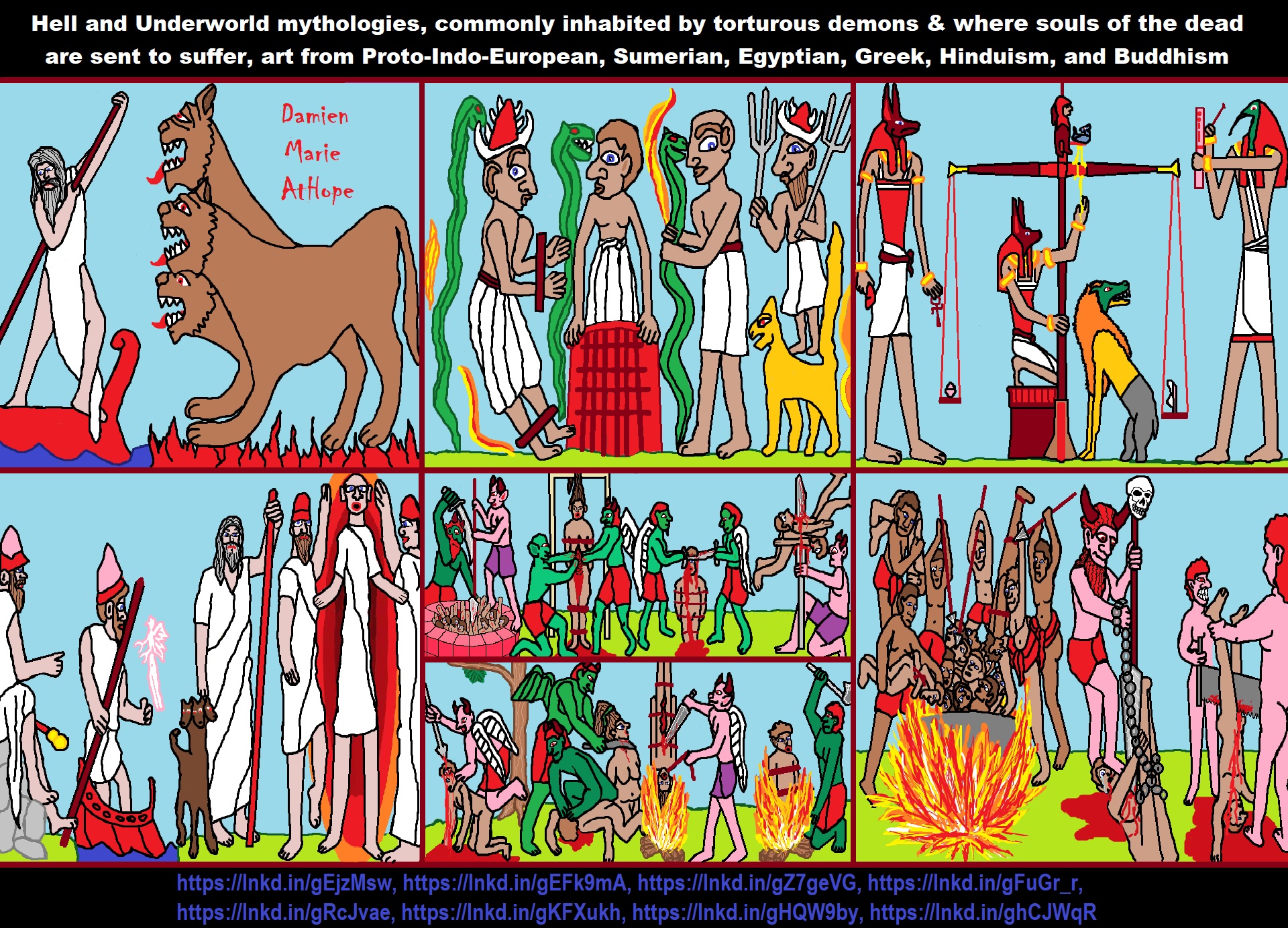
ref, ref, ref, ref, ref, ref, ref, ref, ref, ref, ref
Sumerian religion/ Mesopotamian mythology
‘Ancient North Eurasian’ Beliefs and Comparative mythology
“Since the term ‘Ancient North Eurasian’ refers to a genetic bridge of connected mating networks, scholars of comparative mythology have argued that they probably shared myths and beliefs that could be reconstructed via the comparison of stories attested within cultures that were not in contact for millennia and stretched from the Pontic–Caspian steppe to the American continent.” ref
“For instance, the mytheme of the dog guarding the Otherworld possibly stems from an older Ancient North Eurasian belief, as suggested by similar motifs found in Indo-European, Native American, and Siberian mythology. In Siouan, Algonquian, Iroquoian, and in Central and South American beliefs, a fierce guard dog was located in the Milky Way, perceived as the path of souls in the afterlife, and getting past it was a test. The Siberian Chukchi and Tungus believed in a guardian-of-the-afterlife dog and a spirit dog that would absorb the dead man’s soul and act as a guide in the afterlife. In Indo-European myths, the figure of the dog is embodied by Cerberus, Sarvarā, and Garmr. Anthony and Brown note that it might be one of the oldest mythemes recoverable through comparative mythology.” ref
“A second canid-related series of beliefs, myths, and rituals connected dogs with healing rather than death. For instance, Ancient Near Eastern and Turkic–Kipchaq myths are prone to associate dogs with healing and generally categorized dogs as impure. A similar myth-pattern is assumed for the Eneolithic site of Botai in Kazakhstan, dated to 3500 BC, which might represent the dog as an absorber of illness and guardian of the household against disease and evil. In Mesopotamia, the goddess Nintinugga, associated with healing, was accompanied or symbolized by dogs. Similar absorbent-puppy healing and sacrifice rituals were practiced in Greece and Italy, among the Hittites, again possibly influenced by Near Eastern traditions.” ref
Groups partially derived from the Ancient North Eurasians
“Eastern Hunter-Gatherer (EHG) is a lineage derived predominantly (75%) from ANE. It is represented by two individuals from Karelia, one of Y-haplogroup R1a-M417, dated c. 8.4 kya, the other of Y-haplogroup J, dated c. 7.2 kya; and one individual from Samara, of Y-haplogroup R1b-P297, dated c. 7.6 kya. This lineage is closely related to the ANE sample from Afontova Gora, dated c. 18 kya.” ref
“After the end of the Last Glacial Maximum, the Western Hunter-Gatherers (WHG) and EHG lineages merged in Eastern Europe, accounting for early presence of ANE-derived ancestry in Mesolithic Europe. Evidence suggests that as Ancient North Eurasians migrated West from Eastern Siberia, they absorbed Western Hunter-Gatherers and other West Eurasian populations as well.” ref
“Caucasian Hunter-Gatherer (CHG) is represented by the Satsurblia individual dated ~13 kya (from the Satsurblia cave in Georgia), and carried 36% ANE-derived admixture. While the rest of their ancestry is derived from the Dzudzuana cave individual dated ~26 kya, which lacked ANE-admixture, Dzudzuana affinity in the Caucasus decreased with the arrival of ANE at ~13 kya Satsurblia.” ref
“Scandinavian Hunter-Gatherer (SHG) is represented by several individuals buried at Motala, Sweden ca. 6000 BC. They were descended from Western Hunter-Gatherers who initially settled Scandinavia from the south, and later populations of EHG who entered Scandinavia from the north through the coast of Norway.” ref
“Iran Neolithic (Iran_N) individuals dated ~8.5 kya carried 50% ANE-derived admixture and 50% Dzudzuana-related admixture, marking them as different from other Near-Eastern and Anatolian Neolithics who didn’t have ANE admixture. Iran Neolithics were later replaced by Iran Chalcolithics, who were a mixture of Iran Neolithic and Near Eastern Levant Neolithic.” ref
“Ancient Beringian/Ancestral Native American are specific archaeogenetic lineages, based on the genome of an infant found at the Upward Sun River site (dubbed USR1), dated to 11,500 years ago. The AB lineage diverged from the Ancestral Native American (ANA) lineage about 20,000 years ago.” ref
“West Siberian Hunter-Gatherer (WSHG) are a specific archaeogenetic lineage, first reported in a genetic study published in Science in September 2019. WSGs were found to be of about 30% EHG ancestry, 50% ANE ancestry, and 20% to 38% East Asian ancestry.” ref
“Western Steppe Herders (WSH) is the name given to a distinct ancestral component that represents descent closely related to the Yamnaya culture of the Pontic–Caspian steppe. This ancestry is often referred to as Yamnaya ancestry or Steppe ancestry.” ref
“Late Upper Paeolithic Lake Baikal – Ust’Kyakhta-3 (UKY) 14,050-13,770 BP were mixture of 30% ANE ancestry and 70% East Asian ancestry.]Lake Baikal Holocene – Baikal Eneolithic (Baikal_EN) and Baikal Early Bronze Age (Baikal_EBA) derived 6.4% to 20.1% ancestry from ANE, while rest of their ancestry was derived from East Asians. Fofonovo_EN near by Lake Baikal were mixture of 12-17% ANE ancestry and 83-87% East Asian ancestry.” ref
“Hokkaido Jōmon people specifically refers to the Jōmon period population of Hokkaido in northernmost Japan. Though the Jōmon people themselves descended mainly from East Asian lineages, one study found an affinity between Hokkaido Jōmon with the Northern Eurasian Yana sample (an ANE-related group, related to Mal’ta), and suggest as an explanation the possibility of minor Yana gene flow into the Hokkaido Jōmon population (as well as other possibilities). A more recent study by Cooke et al. 2021, confirmed ANE-related geneflow among the Jōmon people, partially ancestral to the Ainu people. ANE ancestry among Jōmon people is estimated at 21%, however, there is a North to South cline within the Japanese archipelago, with the highest amount of ANE ancestry in Hokkaido and Tohoku.” ref
Evolution of blond hair
“Single nucleotide polymorphisms of the KITLG gene are associated with blonde hair color in various human populations. One of these polymorphisms is associated with blond hair. The earliest known individual with this allele is a female south-central Siberian ANE individual from Afontova Gora 3 site, which is dated to 16130-15749 BCE. It is thus argued that at least some ANE individuals were blonde haired.” ref
“Geneticist David Reich said that the KITLG gene for blond hair probably entered continental Europe in a population migration wave from the Eurasian steppe, by a population carrying substantial Ancient North Eurasian ancestry. Hanel and Carlberg (2020) likewise report that populations bearing Ancient North Eurasian ancestry were responsible for contributing gene alleles lightening European hair color.” ref

“In 2021, a review of the current evidence infers from the timings provided by DNA studies that the dog was domesticated in Siberia 23,000 years ago by ancient North Siberians. The dog later dispersed from Siberia with the migration of peoples eastwards into the Americas and westwards across Eurasia. The ancient North Siberians were once a people whose ancestors archaeological remains have been found at the Paleolithic Yana RHS (Rhinoceros Horn Site) on the Yana River delta in arctic northern Siberia that is dated 31,600 YBP, and at the Mal’ta site near Lake Baikal in southern Siberia just north of Mongolia that is dated 24,000 YBP. Ancient dog remains dating to this time and place have yet to be discovered to support this hypothesis.“ ref
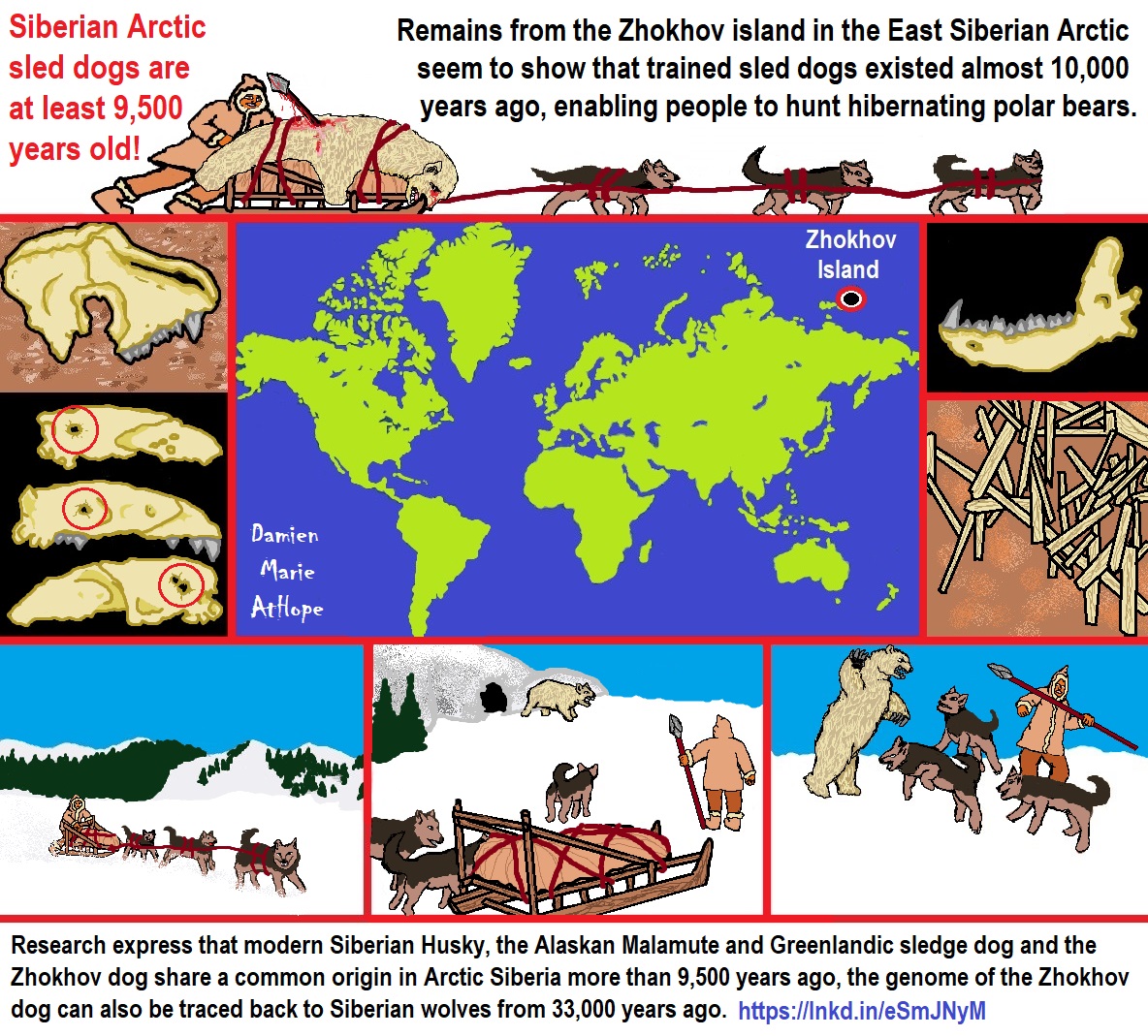
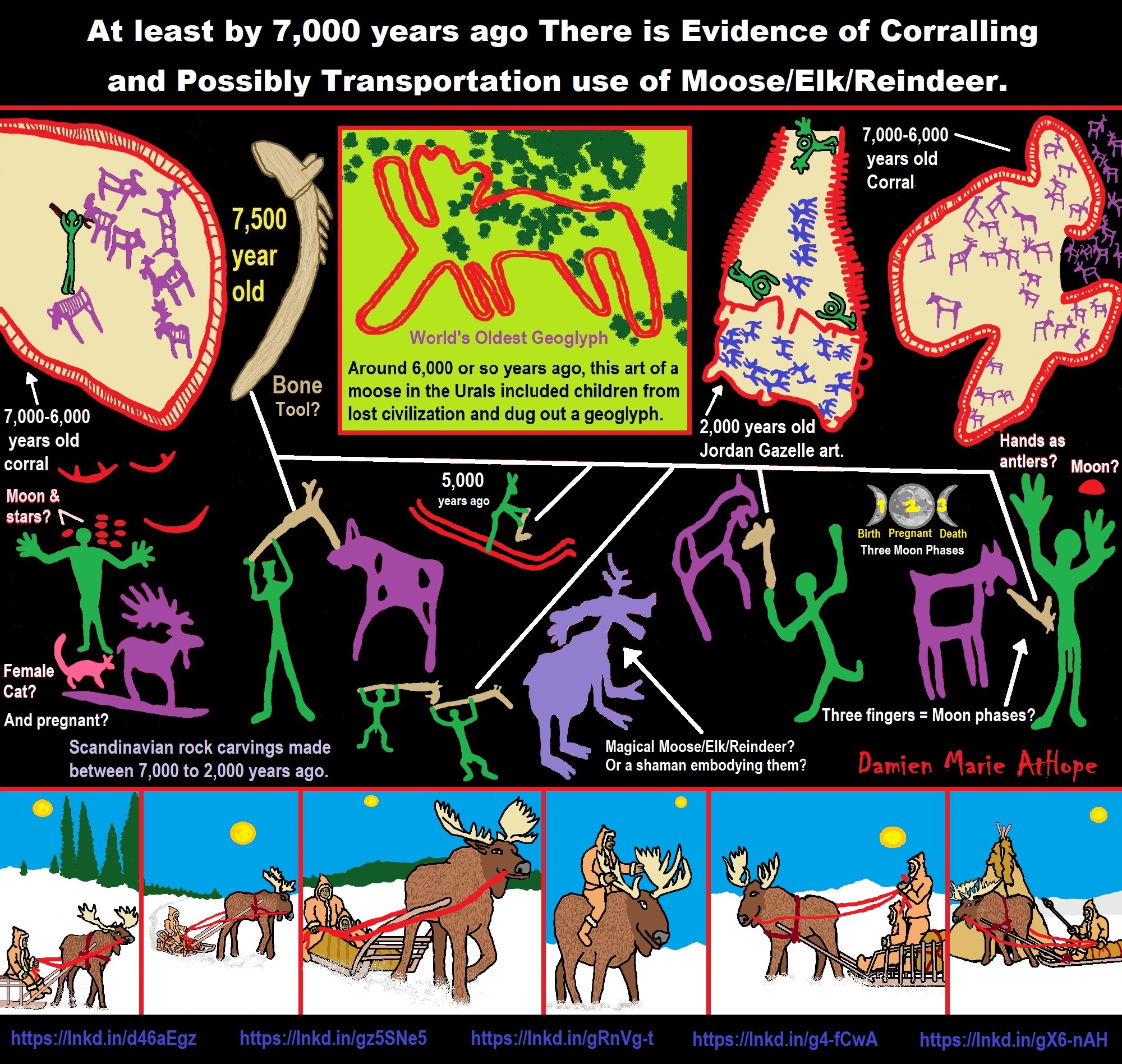
ref, ref, ref, ref, ref, ref, ref, ref, ref, ref, ref, ref, ref, ref
Origin of the domestic dog?
“The origin of the domestic dog includes the dog’s genetic divergence from the wolf, its domestication, and the emergence of the first dogs. Genetic studies show that all ancient and modern dogs share a common ancestry and descended from an ancient, now-extinct wolf population – or closely related wolf populations – which was distinct from the modern wolf lineage. The dog’s similarity to the extant grey wolf is the result of substantial dog-into-wolf gene flow, with the modern grey wolf being the dog’s nearest living relative. An extinct Late Pleistocene wolf may have been the ancestor of the dog.” ref
“The dog is a member of the wolf-like canids. The genetic divergence between the dog’s ancestor and modern wolves occurred between 20,000 and 40,000 years ago, just before or during the Last Glacial Maximum (20,000–27,000 years ago). This timespan represents the upper time-limit for the commencement of domestication because it is the time of divergence but not the time of domestication, which occurred later.” ref
“One of the most important transitions in human history was the domestication of animals, which began with the long-term association between wolves and hunter–gatherers more than 15,000 years ago. The dog was the first species and the only large carnivore to have been domesticated. The archaeological record and genetic analysis show the remains of the Bonn-Oberkassel dog buried beside humans 14,200 years ago to be the first undisputed dog, with disputed remains occurring 36,000 years ago.” ref
“The domestication of the dog predates agriculture, and it was not until 11,000 years ago in the Holocene era that people living in the Near East entered into relationships with wild populations of aurochs, boar, sheep, and goats. Where the domestication of the dog took place remains debated; however, literature reviews of the evidence find that the dog was domesticated in Eurasia, with the most plausible proposals being Central Asia, East Asia, and Western Europe.” ref
“By the close of the most recent Ice Age 11,700 years ago, five ancestral lineages had diversified from each other and were represented through ancient dog samples found in the Levant (7,000 years before present YBP), Karelia (10,900 YBP), Lake Baikal (7,000 YBP), ancient America (4,000 YBP), and in the New Guinea singing dog (present day).” ref
“In 2021, a literature review of the current evidence infers that the dog was domesticated in Siberia 23,000 years ago by ancient North Siberians, then later dispersed eastwards into the Americas and westwards across Eurasia. Ancient dog remains dating to this time and place have yet to be discovered to support this hypothesis.” ref
Time of genetic divergence
“The date estimated for the divergence of a domestic lineage from a wild one does not necessarily indicate the start of the domestication process but it does provide an upper boundary. The divergence of the lineage that led to the domestic horse from the lineage that led to the modern Przewalski’s horse is estimated to have occurred around 45,000 YBP but the archaeological record indicates 5,500 YBP.” ref
“The variance can be due to modern wild populations not being the direct ancestor of the domestic ones, or to a divergence caused by changes in the climate, topography, or other environmental influences. Recent studies indicate that a genetic divergence occurred between the dog’s and modern wolves 20,000–40,000 YBP; however, this is the upper time-limit for domestication because it represents the time of divergence and not the time of domestication.” ref
“In 2013, the mitochondrial DNA (mDNA) sequencing of ancient wolves together with whole genome sequencing of modern dogs and wolves indicated a divergence time of 19,000–32,000 YBP. In 2014, another study indicated 11,000–16,000 YBP based on the modern wolf’s mutation rate. The first draft genome sequence of a Pleistocene wolf was published in 2015.” ref
“This wolf from the Taymyr Peninsula belonged to a population that had diverged from the ancestors of both modern wolves and dogs. Radiocarbon dating indicates its age to be 35,000 YBP, and this age could then be used to calibrate the wolf’s mutation rate, indicating that the genetic divergence between the dog’s ancestor and modern wolves occurred before the Last Glacial Maximum, between 27,000 and 40,000 YBP. When the Pleistocene wolf’s mutation rate was applied to the timing of the earlier 2014 study which had originally used the modern wolf’s mutation rate, that study gave the same result of 27,000–40,000 YBP.” ref
“In 2017, a study compared the nuclear genome (from the cell nucleus) of three ancient dog specimens and found evidence of a single dog-wolf divergence occurring between 36,900 and 41,500 YBP. Prior to genetic divergence, the population of wolves ancestral to the dog outnumbered all other wolf populations, and after divergence, the dog population underwent a population reduction to be much lower.” ref
“In 2020, a genomic study of Eurasian wolves found that they and the dog share a common ancestor which is dated to 36,000 YBP. This finding supports the theory that all modern wolves descend from a single population which expanded after the Last Glacial Maximum and replaced other wolf populations that were adapted to different climatic conditions, and the finding of dog-like fossils dated over 30,000 YBP.” ref
Place of genetic divergence Based on modern DNA
“Genetic studies have found that the modern dogs from Southeast Asia and South China show greater genetic diversity than those dogs from other regions, suggesting that this was the place of their origin. A similar study found greater genetic diversity in African village dogs than in breed dogs. An East Asian origin has been questioned because dog fossils have been found in Europe dating around 15,000 YBP but only 12,000 YBP in far eastern Russia.” ref
“The reply is that archaeological studies in East Asia lag behind those in Europe, and that the environmental conditions in southern East Asia do not favor the preservation of fossils. Although primitive forms of the dog may have existed in Europe in the past, the genetic evidence indicates that these were later replaced by dogs that have migrated from southern East Asia.” ref
“In 2017, a literature review found that this East Asian study sampled only east Asian indigenous dogs and compared their patterns of genetic diversity to those of breed dogs from other geographic regions. As it is known that the genetic bottlenecks associated with the formation of breeds strongly reduce genetic diversity, this was not an appropriate comparison.” ref]
“One DNA study concluded that dogs originated in Central Asia because dogs from there exhibit the lowest levels of linkage disequilibrium. In 2017, a literature review found that because it is known that the genetic bottlenecks associated with the formation of breeds raise linkage disequilibrium, the comparison of purebred with village dogs was not appropriate.” ref
“Another DNA study indicated that dogs originated in the Middle East due to the sharing of DNA between dogs and Middle Eastern grey wolves. In 2011, a study found this indication to be incorrect because there had been hybridization between dogs and Middle Eastern grey wolves. In 2012, a study indicated that dogs derived from wolves originating in the Middle East and Europe and this was consistent with the archaeological record. In 2014, a genomic study found that no modern wolf from any region was any more genetically closer to the dog than any other, implying that the dog’s ancestor was extinct.” ref
Based on ancient DNA
“In 2018, a literature review found that most genetic studies conducted over the last two decades were based on modern dog breeds and extant wolf populations, with their findings dependent on a number of assumptions. These studies assumed that the extant wolf was the ancestor of the dog, did not consider genetic admixture between wolves and dogs, nor the impact of incomplete lineage sorting. These pre-genomic studies have suggested an origin of dogs in Southeast Asia, East Asia, Central Asia, the Middle East, or Europe. More recently, the field of Paleogenomics applies the latest molecular technologies to fossil remains that still contain useful ancient DNA.” ref
Arctic Siberia
“In 2015, a study recovered mDNA from ancient canid specimens that were discovered on Zhokhov Island and the Yana river, arctic Siberia. These specimens included the mandible of a 360,000–400,000 YBP Canis c.f. variabilis (where c.f. is a Latin term meaning uncertain). Phylogenetic analyses of these canids revealed nine mDNA haplotypes not detected before. The Canis c.f. variabilis specimen clustered with other wolf samples from across Russia and Asia.” ref
“The mDNA haplotypes of one 8,750 YBP specimen and some 28,000 YBP specimens matched with those of geographically widely-spread modern dogs. One 47,000 YBP canid from Duvanny Yar (which was once a part of western Beringia) was distinct from wolves but was only a few mutations away from those haplotypes found in modern dogs. The authors concluded that the structure of the modern dog gene pool was contributed to from ancient Siberian wolves and possibly from Canis c.f. variabilis.” ref
Southern Siberia
“In 2013, a study looked at the well-preserved skull and left mandible of a dog-like canid that was excavated from Razboinichya Cave in the Altai Mountains of southern Siberia. It was dated to 33,300 YBP, which predates the oldest evidence from Western Europe and the Near East The mDNA analysis found it to be more closely related to dogs than wolves.” ref
“Later in 2013, another study found that the canid could not be classified as a dog nor wolf because it fell between both. In 2017, evolutionary biologists reviewed all of the evidence available on dog divergence and supported the specimens from the Altai mountains as being those of dogs from a lineage that is now extinct, and that was derived from a population of small wolves that is also now extinct.” ref
“One of the most important transitions in human history was the domestication of animals, which began with the long-term association between wolves and hunter–gatherers more than 15,000 years ago. Dogs were the first domesticated species, the only animal known to have entered into a domestic relationship with humans during the Pleistocene, and the only large carnivore to have been domesticated.” ref
“It was not until 11,000 YBP that people living in the Near East entered into relationships with wild populations of aurochs, boar, sheep, and goats. A domestication process then began to develop. The earlier association of dogs with humans may have allowed dogs to have a profound influence on the course of early human history and the development of civilization.” ref
“The questions of when and where dogs were first domesticated have taxed geneticists and archaeologists for decades. The dog was domesticated from grey wolves in Eurasia. Genetic studies suggest a domestication process commencing over 25,000 YBP, in one or several wolf populations in either Europe, the high Arctic, or eastern Asia.” ref
“There is clear evidence that dogs were derived from grey wolves during the initial phases of domestication. The wolf population(s) that were involved are likely to be extinct. Despite numerous genetic studies of both modern dogs and ancient dog remains, there is no firm consensus regarding either the timing or location(s) of domestication, the number of wolf populations that were involved, or the long-term effects domestication has had on the dog’s genome.” ref
“Around 10,000 YBP agriculture was developed resulting in a sedentary lifestyle, along with phenotype divergence of the dog from its wolf ancestors, including variance in size. Two population bottlenecks have occurred to the dog lineage, one due to the initial domestication and one due to the formation of dog breeds.” ref
Europe
“Phylogenetic analysis showed that modern dog mDNA haplotypes resolve into four monophyletic clades designated by researchers as clades A-D. In 2013, a study sequenced the complete and partial mitochondrial genomes of 18 fossil canids from the Old and New Worlds whose dates range from 1,000 to 36,000 YBP, and compared these with the complete mitochondrial genome sequences from modern wolves and dogs. Clade A included 64% of the modern dogs sampled, and these are a sister group to a clade containing three fossil pre-Columbian New World dogs dated between 1,000 and 8,500 YBP.” ref
This finding supports the hypothesis that pre-Columbian New World dogs share ancestry with modern dogs and that they likely arrived with the first humans to the New World. Together, clade A and the pre-Columbian fossil dogs were the sister group to a 14,500 YBP wolf found in the Kessleroch cave near Thayngen in the canton of Schaffhausen, Switzerland, with a most recent common ancestor estimated to 32,100 YBP.” ref
“Clade B included 22% of the dog sequences which related to modern wolves from Sweden and the Ukraine, with a common recent ancestor estimated to 9,200 YBP. However, this relationship might represent mitochondrial genome introgression from wolves because dogs were domesticated by this time.” ref
“Clade C included 12% of the dogs sampled and these were sister to two ancient dogs from the Bonn-Oberkassel cave (14,700 YBP) and the Kartstein cave (12,500 YBP) near Mechernich in Germany, with a common recent ancestor estimated to 16,000–24,000 YBP. Clade D contained sequences from 2 Scandinavian breeds – the Jamthund and Norwegian Elkhound – and is the sister group to another 14,500 YBP wolf sequence also from the Kesserloch cave, with a common recent ancestor estimated to 18,300 YBP.” ref
“Its branch is phylogenetically rooted in the same sequence as the “Altai dog” (not a direct ancestor). The data from this study indicated a European origin for dogs that was estimated at 18,800–32,100 YBP based on the genetic relationship of 78% of the sampled dogs with ancient canid specimens found in Europe. The data supports the hypothesis that dog domestication preceded the emergence of agriculture and was initiated close to the Last Glacial Maximum when hunter-gatherers preyed on megafauna.” ref
“The study found that three ancient Belgium canids (the 36,000 YBP “Goyet dog” cataloged as Canis species, along with two specimens dated 30,000 YBP and 26,000 YBP cataloged as Canis lupus) formed an ancient clade that was the most divergent group. The study found that the skulls of the “Goyet dog” and the “Altai dog” had some dog-like characteristics and proposed that this may have represented an aborted domestication episode. If so, there may have been originally more than one ancient domestication event for dogs as there was for domestic pigs.” ref
“One review considered why the domestication of the wolf occurred so late and at such high latitudes, when humans were living alongside wolves in the Middle East for the past 75,000 years. The proposal is that domestication was a cultural innovation caused through a long and stressful event, which was climate change. Domestication may have happened during one of the five cold Heinrich events that occurred after the arrival of humans in West Europe 37,000, 29,000, 23,000, 16,500, and 12,000 YBP. The theory is that the extreme cold during one of these events caused humans to either shift their location, adapt through a breakdown in their culture and change of their beliefs, or adopt innovative approaches. The adoption of the large wolf/dog was an adaptation to this hostile environment.” ref
“A criticism of the European proposal is that dogs in East Asia show more genetic diversity. However, dramatic differences in genetic diversity can be influenced both by an ancient and recent history of inbreeding. A counter-comment is that the modern European breeds only emerged in the 19th century, and that throughout history global dog populations experienced numerous episodes of diversification and homogenization, with each round further reducing the power of genetic data derived from modern breeds to help infer their early history.” ref
“In 2019, study of wolf samples from northern Italy using very short lengths of mDNA found that two specimens found in the Cava Filo archaeological site near San Lazzaro di Savena, Bologna fell within the domestic dog clade A haplogroup, with one being radio-carbon dated 24,700 YBP and the other stratigraphy dated to 20,000 YBP.” ref
“The 24,700 YBP specimen matched the haplotype of ancient Bulgarian dogs, 2 historical sled dogs from the North American arctic, and 97 modern dogs. The 20,000 YBP specimen matched the haplotype of ancient Iberian and ancient Bulgarian dogs, Roman dogs from Iberia, and 2 historical sled dogs from the North American arctic. Four dog specimens found in the Bronze Age town of Via Ordiere, Solarolo, Italy dated to 3,600–3,280 years ago shared haplotypes with Late Pleistocene wolves and modern dogs.” ref
“In 2020, dog remains were found in two caves, Paglicci Cave and Grotta Romanelli in Apulia, southern Italy. These were dated 14,000 YBP and are the oldest dog remains found in the Mediterranean Basin. One specimen was retrieved from a layer where the sediment was dated 20,000 YBP, indicating the possibility of an earlier timing. The specimens were genetically related to the 14,000 YBP Bonn-Oberkassel dog from Germany and other early dogs from western and central Europe which all fall within the domestic dog mDNA haplogroup C, indicating that these were all derived from a common ancestor. Using genetic timing, this clade’s most recent common ancestor dates to 28,500 YBP.” ref
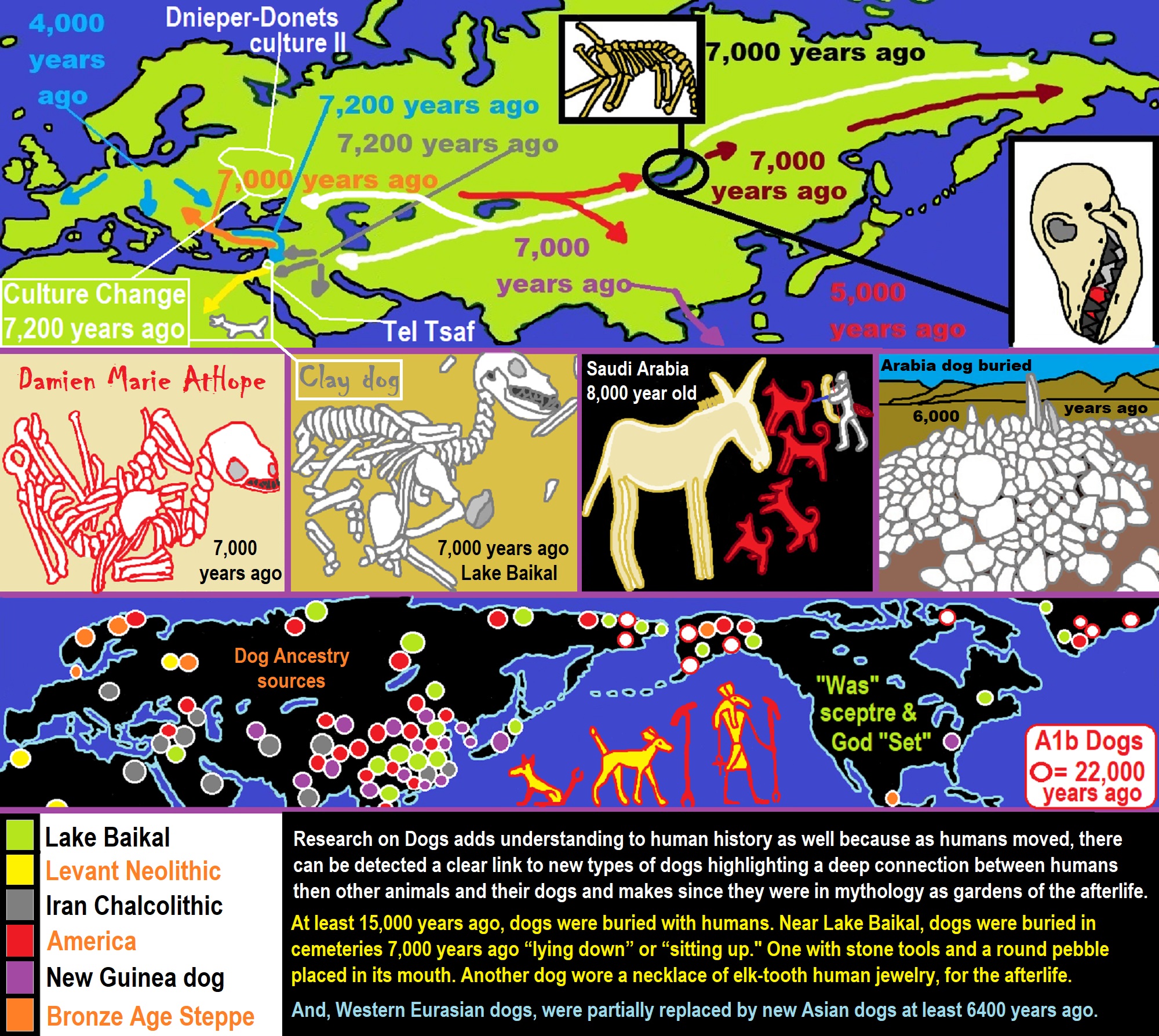

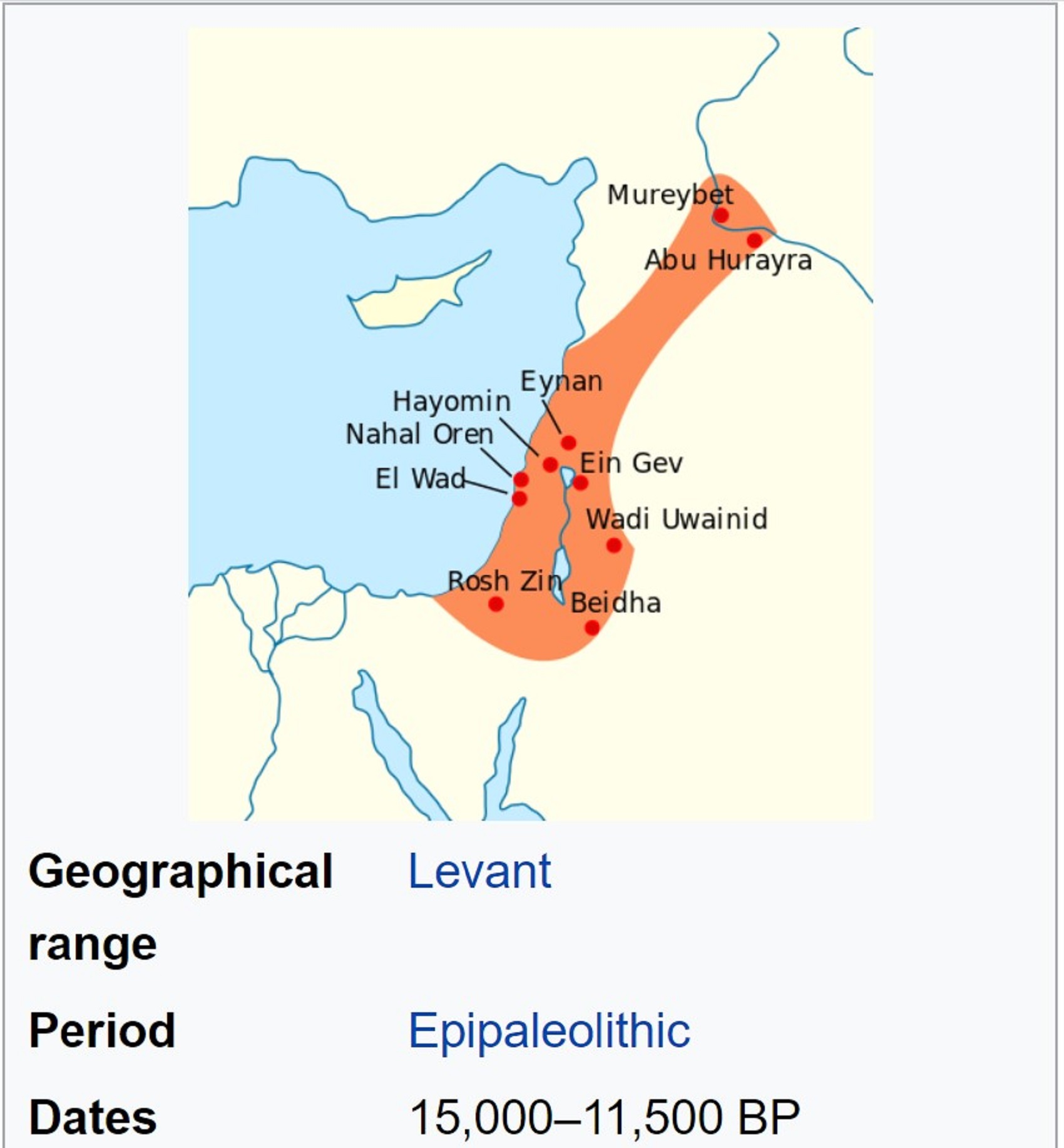
“The Natufian culture is a Late Epipaleolithic archaeological culture of the Levant, dating to around 15,000 to 11,500 years ago. The culture was unusual in that it supported a sedentary or semi-sedentary population even before the introduction of agriculture. The Natufian communities may be the ancestors of the builders of the first Neolithic settlements of the region, which may have been the earliest in the world.” ref
“Some evidence suggests deliberate cultivation of cereals, specifically rye, by the Natufian culture, at Tell Abu Hureyra, the site of earliest evidence of agriculture in the world. The world’s oldest evidence of bread-making has been found at Shubayqa 1, a 14,500-year-old site in Jordan’s northeastern desert. In addition, the oldest known evidence of beer, dating to approximately 13,000 BP, was found at the Raqefet Cave in Mount Carmel near Haifa in Israel.” ref
“Generally, though, Natufians exploited wild cereals and hunted animals, including gazelles. Archaeogenetics have revealed derivation of later (Neolithic to Bronze Age) Levantines primarily from Natufians, besides substantial admixture from Chalcholithic Anatolians. Dorothy Garrod coined the term Natufian based on her excavations at Shuqba cave (Wadi an-Natuf) near the town of Shuqba in the western Judean Mountains.” ref
“The Natufian developed in the same region as the earlier Kebaran industry. It is generally seen as a successor, which evolved out of elements within that preceding culture. There were also other industries in the region, such as the Mushabian culture of the Negev and Sinai, which are sometimes distinguished from the Kebaran or believed to have been involved in the evolution of the Natufian.” ref
“More generally there has been discussion of the similarities of these cultures with those found in coastal North Africa. Graeme Barker notes there are: “similarities in the respective archaeological records of the Natufian culture of the Levant and of contemporary foragers in coastal North Africa across the late Pleistocene and early Holocene boundary”. According to Isabelle De Groote and Louise Humphrey Natufians practiced the Iberomaurusian and Capsian custom of sometimes extracting their maxillary central incisors (upper front teeth).” ref
“Ofer Bar-Yosef has argued that there are signs of influences coming from North Africa to the Levant, citing the microburin technique and “microlithic forms such as arched backed bladelets and La Mouillah points.” But recent research has shown that the presence of arched backed bladelets, La Mouillah points, and the use of the microburin technique was already apparent in the Nebekian industry of the Eastern Levant.” ref
“And Maher et al. state that, “Many technological nuances that have often been always highlighted as significant during the Natufian were already present during the Early and Middle EP [Epipalaeolithic] and do not, in most cases, represent a radical departure in knowledge, tradition, or behavior.” ref
“Authors such as Christopher Ehret have built upon the little evidence available to develop scenarios of intensive usage of plants having built up first in North Africa, as a precursor to the development of true farming in the Fertile Crescent, but such suggestions are considered highly speculative until more North African archaeological evidence can be gathered. In fact, Weiss et al. have shown that the earliest known intensive usage of plants was in the Levant 23,000 years ago at the Ohalo II site.” ref
“Anthropologist C. Loring Brace (1993) cross-analysed the craniometric traits of Natufian specimens with those of various ancient and modern groups from the Near East, Africa and Europe. The Late Pleistocene Epipalaeolithic Natufian sample was described as problematic due to its small size (consisting of only three males and one female), as well as the lack of a comparative sample from the Natufians’ putative descendants in the Neolithic Near Brace observed that the Natufian fossils lay between those of the Niger-Congo-speaking populations and the other samples, which he suggested may point to a Sub-Saharan influence in their constitution.” ref
“Subsequent ancient DNA analysis of Natufian skeletal remains by Lazaridis et al. (2016) found that the specimens instead were a mix of 50% Basal Eurasian ancestral component (see genetics) and 50% Western Eurasian Unknown Hunter Gatherer (UHG) population related to European Western Hunter-Gatherers.” ref
“According to Bar-Yosef and Belfer-Cohen, “It seems that certain preadaptive traits, developed already by the Kebaran and Geometric Kebaran populations within the Mediterranean park forest, played an important role in the emergence of the new socioeconomic system known as the Natufian culture.” ref
“Settlements occur in the woodland belt where oak and Pistacia species dominated. The underbrush of this open woodland was grass with high frequencies of grain. The high mountains of Lebanon and the Anti-Lebanon, the steppe areas of the Negev desert in Israel and Sinai, and the Syro-Arabian desert in the east were much less favoured for Natufian settlement, presumably due to both their lower carrying capacity and the company of other groups of foragers who exploited this region.” ref
“The habitations of the Natufian were semi-subterranean, often with a dry-stone foundation. The superstructure was probably made of brushwood. No traces of mudbrick have been found, which became common in the following Pre-Pottery Neolithic A (PPNA). The round houses have a diameter between three and six meters, and they contain a central round or subrectangular fireplace. In Ain Mallaha traces of postholes have been identified. Villages can cover over 1,000 square meters.” ref
“Smaller settlements have been interpreted by some researchers as camps. Traces of rebuilding in almost all excavated settlements seem to point to a frequent relocation, indicating a temporary abandonment of the settlement. Settlements have been estimated to house 100–150 people, but there are three categories: small, medium, and large, ranging from 15 sq. m to 1,000 sq. m. There are no definite indications of storage facilities.” ref
“The Natufian had a microlithic industry centered on short blades and bladelets. The microburin technique was used. Geometric microliths include lunates, trapezes, and triangles. There are backed blades as well. A special type of retouch (Helwan retouch) is characteristic for the early Natufian. In the late Natufian, the Harif-point, a typical arrowhead made from a regular blade, became common in the Negev. Some scholars use it to define a separate culture, the Harifian.” ref
“Sickle blades also appear for the first time in the Natufian lithic industry. The characteristic sickle-gloss shows that they were used to cut the silica-rich stems of cereals, indirectly suggesting the existence of incipient agriculture. Shaft straighteners made of ground stone indicate the practice of archery. There are heavy ground-stone bowl mortars as well.” ref
“The Ain Sakhri lovers, a carved stone object held at the British Museum, is the oldest known depiction of a couple having sex. It was found in the Ain Sakhri cave in the Judean desert. Natufian grave goods are typically made of shell, teeth (of red deer), bones, and stone. There are pendants, bracelets, necklaces, earrings, and belt-ornaments as well.” ref
“In 2008, the 12,400–12,000 cal BC grave of an apparently significant Natufian female was discovered in a ceremonial pit in the Hilazon Tachtit cave in northern Israel. Media reports referred to this person as a shaman. The burial contained the remains of at least three aurochs and 86 tortoises, all of which are thought to have been brought to the site during a funeral feast. The body was surrounded by tortoise shells, the pelvis of a leopard, forearm of a wild boar, wingtip of a golden eagle, and skull of a stone marten.” ref
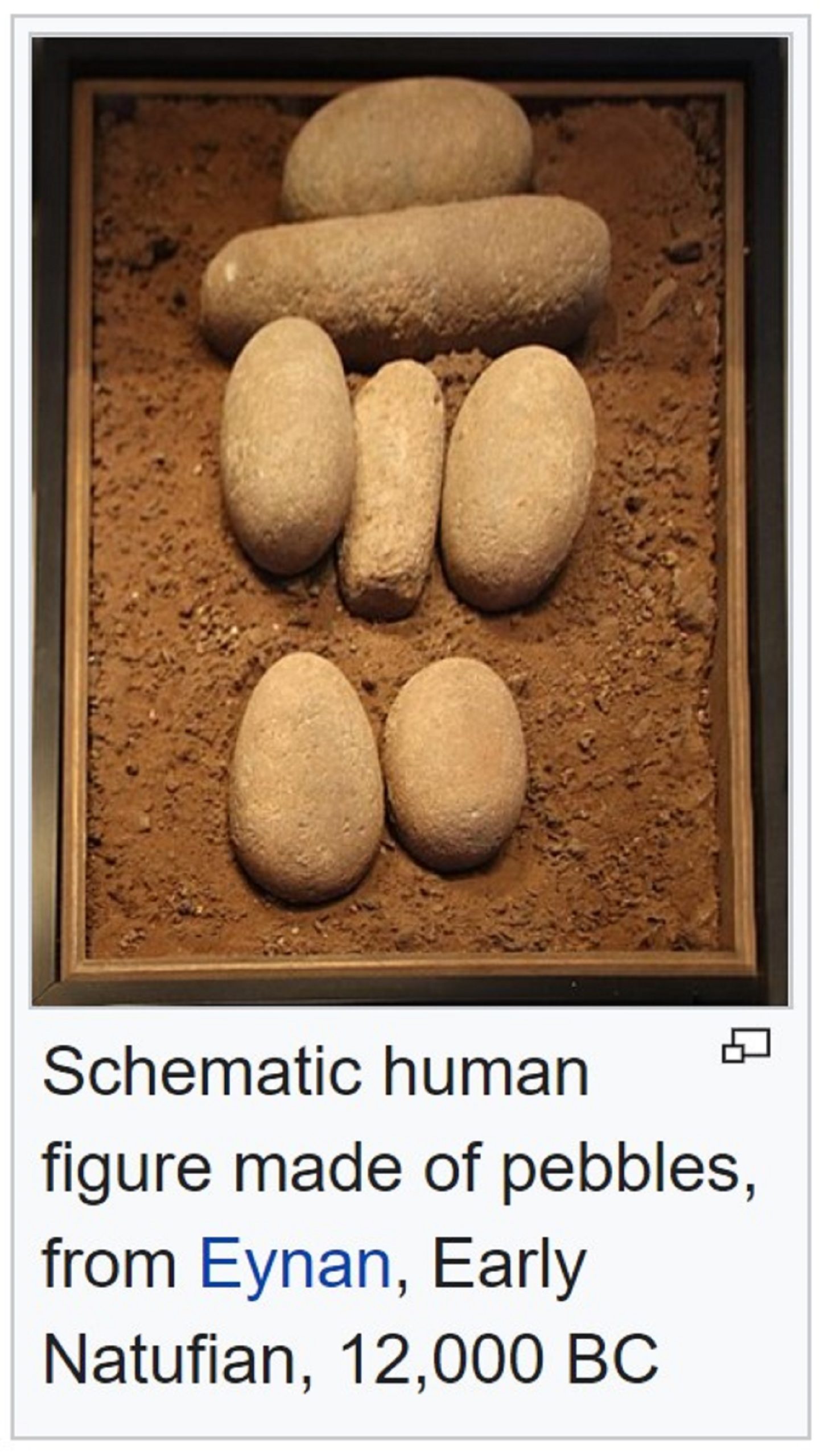
Natufians: an Ancient People at the Origins of Agriculture and Sedentary Life
13,000 – 11,700 Years Ago – (Israel/Levant), found evidence of the likely origin of the Natufians, who were different nomadic hunter-gatherer bands coming together or at least outgroup sharing of ideas at first then more ingroup cohesion at some point. The Natufians, possibly formed as early as 13,500 years ago and seemed to engage in at least some long distance exchange, seen at Ain Mallaha in Northern Israel that had obsidian from Turkey and shellfish from the Nile valley. As far as funerary practices there have been several notable burials and grave goods, such as four burial sites with Natufian cave pit graves contained 29 skeletons with flowers and elsewhere Natufian graves have held shells, teeth, bones, and stone. There are also pendants, bracelets, necklaces, earrings, and belt-ornaments as well all showing some ritual or religious burial rite. One amazing burial sites was found in a small cave in the lower Galilee consisting of a 12,000 year old adult Natufian female who must have been special as her grave was somewhat unique, was found in a burial ground for at least 28 people. Her grave apparently demonstrates her significance in the Natufian culture and may have been a kind of religious or other type leader or possibly a shaman. The grave contained the remains of at least at least three aurochs and 70 tortoises shells, the pelvis of a leopard, forearm of a wild boar, wingtip of a golden eagle, and skull of a stone marten. A proto formation of ancestral hunter-gatherers from several linages in and outside of Israel going back 25,000 years ago, merge into early Natufian cultures. Yet, 13,500 years ago, Natufians, show greater similarity to the ancestral hunter-gatherers genetically. This ancestral hunter-gatherer likely are the Kebarian culture 20,000 – 14,500 years ago which connects to early the Natufian cultures. The Kebarans appeared to have moved out of Nubia (Nile River area of Egypt and Sudan) and up as far as Syria. All the North African populations from Algeria to Israel show varying levels of sub-Saharan ancestry at this point, but the population do not seem to reach as far as Turkey yet. The Kebaran phase is followed by the Antelian culture spreading as far as southern Turkey. What is interesting about Turkey is its genetic heritage Haplogroup J1 (Y-DNA) that starts 15,400 years ago, and demonstrates a multifaceted prehistory of 52 distinct diversity components; 94% of which are shared with both European and Near Eastern populations. Early Natufian cultures stayed somewhat genetically devise until the late Natufian culture around 11,000 years ago, when Natufians appears more homogenous as a genetically solidified culture with increasingly closed ‘gene pools’. Then by 9,800 years ago, the remainder of the Natufian population dispersed to other areas and became or mixed into other cultures and only a small proportion contributed to the later Levantine genetic morphology. Natufians were strongly genetically differentiated caring around 50% of the Basal Eurasian and slightly distinct from the northern Turkey populations with higher Western Hunter Gatherer that contributed to the peopling of Europe. Natufians were different from Neolithic Iranian farmers in the Zagros Mountains, caring up to 62% of the Basal Eurasians and Ancient North Eurasians. A special characteristic of the Basal Eurasians genetics is they had very little Neanderthal DNA and DNA that was separate from other non-African lineages. This special characteristic of very little Neanderthal DNA is interesting as Basal Eurasian ancestry seems to find its home in the Near East. The Near East is roughly the modern Middle East a place thought to have the most mating between Neanderthals and modern humans are presumed to have occurred. Basal Eurasian ancestry mating between Natufians and other Neolithic Levantines, Anatolian/Turkey and Iranian farmers explains the reduced Neanderthal admixture in West Eurasians. The main hub of the Natufians was the Levant, from the Taurus Mountains of Turkey in the North, to the Mediterranean Sea in the west, as well as the north Arabian Desert and finally the Mesopotamia to the east. Natufians, inner mating with other localized population of the Neolithic Levantines, Anatolian/Turkey and Iranian farmers are thought to have decreased genetic variability among later populations in the Middle East. Another, interesting point is that the Neolithic Levantines DNA is similar to Western Neolithic Anatolians and Early European Farmers. If this Natufian’s result is truly legitimate and the other samples and numerous future Natufian samples prove to be just like him in this respect; it seems like something from outside the Levant brought the derived allele to the region as Caucasus Hunter-Gatherers carried it, Neolithic Iranians seemingly carried it and Western Neolithic Anatolians did as well. For Neolithic and not Epipaleolithic Levantines to carry it could mean an outside population brought it in perhaps from somewhere more north or east.
References 1, 2, 3, 4, 5, 6, 7, 8, 9, 10, 11, 12, 13
12,000-year-old Gobekli Tepe: the first temple
At around 13,000 years ago, the site functioned as a ritual or religious center, with the early circles being added around 11,600 years ago. Then, between 11,130–10,620 years ago, the first building stage for Layer III was completed. At this point, it was a totemistic-shamanistic proto-paganism meeting place of ancestor worship and cultic feasting as well as drinking, with evidence of beer brewing starting at almost 11,000 years ago. Next, around 10,280–9,970 years ago, enclosure B is constructed, followed by enclosure C at around 9,560–9,370. Some pillars are around 15 to 20 ft-foot-high and can weigh up to 20 tons, many with totem animals and anthropomorphic human-like fertility cult representations.
Natufian culture “Evidence for immigration”
“The appearance of complex art: At the same time as the appearance of the Natufian culture there is a noticeable rise in the number of artistic objects in the Levant. These include bone and stone animal carvings, colored stone beads, some of the stones coming from over 100km/63 miles away, and complex abstract carvings that may represent code.” ref
“As well as these there are many burials, often beneath the houses. These burials often contain peculiar objects to accompany the dead. Many burials include beads but one recently discovered included bits of dead wild animals. As mentioned above, materials such as stone from Arabia, obsidian from Anatolia/Turkey, and shell from the Nile valley show contacts with people over several hundred kilometers away. But other evidence, such as stone blade shaping techniques derived from north Africa and some evidence for north African genes in the population suggests that people may also have come in from some distance. Additionally, there is tenuous evidence for the import of a type of fig from north Africa.” ref
“The early Levantine Natufian people shared craniometric affinity with North Africans and in some respects with Sub-Saharan Africans. However, according to Lazaridis et al., Natufians did not share a greater amount of alleles with Sub-Saharan Africans than other ancient Eurasians, and the Basal Eurasian ancestry in Natufians is consistent with originating from the same population as Neolithic Iranians and Mesolithic Iranians.” ref
“Mesolithic Iranians (66±13%), Neolithic Iranians (48±6%), and Epipaleolithic Natufians (44±8% or 63%) share Basal-Eurasian ancestry. Another estimate given for Holocene-era Near Easterners (e.g., Mesolithic Caucasian Hunter Gatherers, Mesolithic Iranians, Neolithic Iranians, Natufians) is that they possess up to 50% Basal Eurasian ancestry. Additionally, while the Taforalt individuals were considered likely direct descendants of Basal Eurasians, they were shown to not be genetically closer to Basal Eurasians than Holocene-era Iranians.” ref
“The early spread of ancestry from Basal Eurasians spanned from Georgia, dated to 26,000 years ago, to Morocco, dated to 15,000 years ago. Amid the Holocene, the spread of ancestry from Basal Eurasians expanded more broadly into the regions of South Asia and West Eurasia.” ref
Long-distance exchange
“At Ain Mallaha (in Northern Israel), Anatolian obsidian and shellfish from the Nile valley have been found. The source of malachite beads is still unknown. Epipaleolithic Natufians carried parthenocarpic figs from Africa to the southeastern corner of the Fertile Crescent, c. 10,000 BCE or 12,022 years ago.” ref
“There was a rich bone industry, including harpoons and fish hooks. Stone and bone were worked into pendants and other ornaments. There are a few human figurines made of limestone (El-Wad, Ain Mallaha, Ain Sakhri), but the favorite subject of representative art seems to have been animals. Ostrich-shell containers have been found in the Negev.” ref
“In 2018, the world’s oldest brewery was found, with the residue of 13,000-year-old beer, in a prehistoric cave near Haifa in Israel when researchers were looking for clues into what plant foods the Natufian people were eating. This is 8,000 years earlier than experts previously thought beer was invented.” ref
“A study published in 2019 shows an advanced knowledge of lime plaster production at a Natufian cemetery in Nahal Ein Gev II site in the Upper Jordan Valley dated to 12 thousand (calibrated) years before present [k cal BP]. Production of plaster of this quality was previously thought to have been achieved some 2,000 years later.” ref
“The Natufian people lived by hunting and gathering. The preservation of plant remains is poor because of the soil conditions, but wild cereals, legumes, almonds, acorns, and pistachios may have been collected. Animal bones show that gazelle (Gazella gazella and Gazella subgutturosa) were the main prey. Additionally deer, aurochs and wild boar were hunted in the steppe zone, as well as onagers and caprids (ibex).” ref
‘Water fowl and freshwater fish formed part of the diet in the Jordan River valley. Animal bones from Salibiya I (12,300 – 10,800 cal BP) have been interpreted as evidence for communal hunts with nets, however, the radiocarbon dates are far too old compared to the cultural remains of this settlement, indicating contamination of the samples.” ref
Development of agriculture
“A pita-like bread has been found from 12,500 BCE attributed to Natufians. This bread is made of wild cereal seeds and papyrus cousin tubers, ground into flour. According to one theory, it was a sudden change in climate, the Younger Dryas event (c. 10,800 to 9500 BCE), which inspired the development of agriculture. The Younger Dryas was a 1,000-year-long interruption in the higher temperatures prevailing since the Last Glacial Maximum, which produced a sudden drought in the Levant.” ref
“This would have endangered the wild cereals, which could no longer compete with dryland scrub, but upon which the population had become dependent to sustain a relatively large sedentary population. By artificially clearing scrub and planting seeds obtained from elsewhere, they began to practice agriculture. However, this theory of the origin of agriculture is controversial in the scientific community.” ref
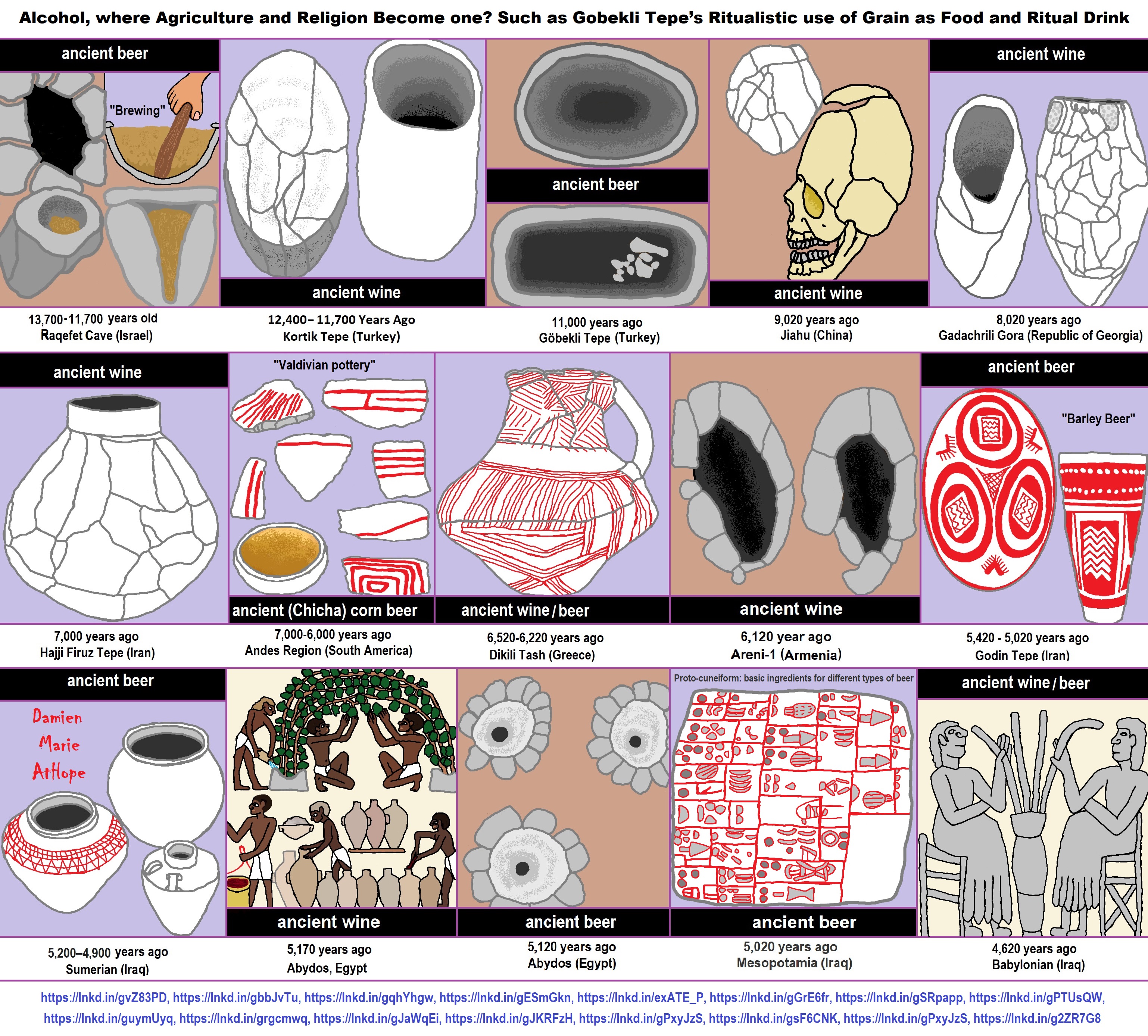
ref, ref, ref, ref, ref, ref, ref, ref, ref, ref, ref, ref, ref, ref, ref
Raqefet Cave
13,000-year-old stone mortars offers the earliest known physical evidence of an extensive ancient beer-brewing operation.
“The find comes on the heels of a July report that archaeologists working in northeastern Jordan discovered the charred remains of bread baked by Natufians some 11,600 to 14,600 years ago. According to the Stanford scientists, the ancient beer residue comes from 11,700 to 13,700 years old. Through laboratory analysis, other archaeological evidence found in the cave, and the wear of the stones, the team discovered that the ancient Natufians used species from seven plant families, “including wheat or barley, oat, legumes and bast fibers (including flax),” according to the article. “They packed plant-foods, including malted wheat/barley, in fiber-made containers and stored them in boulder mortars. They used bedrock mortars for pounding and cooking plant-foods, including brewing wheat/barley-based beer likely served in ritual feasts ca. 13,000 years ago,” the scientists write. “It has long been speculated that the thirst for beer may have been the stimulus behind cereal domestication, which led to a major social-technological change in human history; but this hypothesis has been highly controversial,” the Stanford authors say. “We report here of the earliest archaeological evidence for cereal-based beer brewing by a semi-sedentary, foraging people.” ref
“Beer making was an integral part of rituals and feasting, a social regulatory mechanism in hierarchical societies,” said Stanford’s Wang. The Raqefet Cave discovery of the first man-made alcohol production, the cave also provides one of the earliest pieces of evidence of the use of flower beds on gravesites, discovered under human skeletons. “The Natufian remains in Raqefet Cave never stop surprising us,” co-author Prof. Dani Nadel, of the University of Haifa’s Zinman Institute of Archaeology, said in a press release. “We exposed a Natufian burial area with about 30 individuals, a wealth of small finds such as flint tools, animal bones and ground stone implements, and about 100 stone mortars and cupmarks. Some of the skeletons are well-preserved and provided direct dates and even human DNA, and we have evidence for flower burials and wakes by the graves.” ref
“And now, with the production of beer, the Raqefet Cave remains provide a very vivid and colorful picture of Natufian lifeways, their technological capabilities, and inventions,” he said. Stanford’s Liu posited that the beer production was of a religious nature because its production was found near a graveyard. “This discovery indicates that making alcohol was not necessarily a result of agricultural surplus production, but it was developed for ritual purposes and spiritual needs, at least to some extent, prior to agriculture,” she said. “Alcohol making and food storage were among the major technological innovations that eventually led to the development of civilizations in the world, and archaeological science is a powerful means to help reveal their origins and decode their contents,” said Liu. “We are excited to have the opportunity to present our findings, which shed new light on a deeper history of human society.” ref
The very first farmer may have lived in a barren mountain landscape in Turkey over 10,000 years ago.
“When and where did humankind first start cultivating the soil? The experts haven’t formed a single chorus on that issue, but a very good candidate for the site is found near the Mountain Karacadağ in Anatolia − in southeastern Turkey. This is where the first humanly modified grain was developed − einkorn [literally: single grain] wheat.” ref
“The grain is now being more closely linked to one of archaeology’s major puzzles – the mysterious and ancient site Göbekli Tepe with its limestone megaliths decorated with bas-reliefs of animals. Nobody has been able to satisfactorily interpret their full significance. And Göbkeli Tepe is in southeast Turkey, about 30 km from Karacadağ.” ref
“Evidence indicates that einkorn is our first cereal. It’s a kind of wheat which is much older than spelt, the grain so many health-conscious people now swear by. Einkorn was essential for humanity for several millennia but is now only commercially grown a few places in the world.” ref
” The cultivated or domesticated variety of einkorn stems from a wild einkorn that still grows in mountain areas of the Middle East. We say a species of grain has been domesticated when it has undergone changes due to human influence. Domestication is a key term that unites archaeologists and geneticists who are striving to find the origin of agriculture. Just as the dog evolved from the wolf, and pigs evolved from boars, our cereals have been significantly altered by human cultivation.” ref
“The lab results from geneticists are confirmed by archaeologists, who have found the oldest specimens of domesticated einkorn and emmer wheat from this very area, dated at 10,200 – 10,500 years ago. These can be traces of the earliest cultivation of cereals in the world.” ref
“A settlement site at Abu Hureyra in Syria previously gained plenty of attention because of a discovery of a domesticated rye, dated at 12,000 to 13,000 years old. But the archaeological evidence for this site is rather skimpy – just three grains of rye – and in any case, there is no proof that a tradition of rye cultivation occurred here.” ref
“Göbekli Tepe was discovered. Its multi-tonne T-shaped pillars and megaliths decorated with mystical animal figures including, lions, hyenas and spiders are still being excavated from the sands. The oldest finds there are estimated to be 11,000 years old, from the time just prior to the Neolithic Revolution – the start of agriculture.” ref
“This baffles the researchers, who cannot explain exactly what kind of place this was. But it’s believed that it was a large religious temple complex in use for hundreds of years, before it for reasons unknown were deliberately buried.” ref
“However, new discoveries, which haven’t been published yet, link the cultivation of einkorn at Karacadağ more closely to the puzzling place. Maybe there is a common denominator between why the stone pillars were built and why the cultivation of einkorn commenced. Perhaps the answer is beer.” ref
Come on over for some beer?
“Erecting the Göbekli Tepe megaliths demanded an enormous amount of work. But what do you do if you want to get several hundred people to work together for weeks and months at a time, cutting, carving, dragging and lifting tonnes of rock?” ref
“But of course, you offer them beer! Beer would probably have been a prestigious and rare commodity, both nutritious and healthy. In one of the archaeological layers at Göbekli Tepe, from a period designated as PPNB, tubs have been found that could have been used for making malt and brewing beer.” ref
“Tubs have been found that could have held 150 litres of water. These probably weren’t used for storing grain,” says Heun. Beer can only be made from grain and to be ensured access to such cereal it’s a good idea to plant a field of it. This could have been a motivation for growing cereals instead of finding them in the wild.” ref
“These new findings correspond in time to domesticated grain species. But no discoveries of cultivated grain have been made in the oldest and best-known parts of Göbekli Tepe. So hunter-gatherers are still thought to have first built and used the site.” ref
“Whatever their initial impulse, the first farmers in the Middle East developed a package of plant species and domesticated animals that had an enormous impact and formed the basis of agriculture in Mesopotamia, Egypt, and the Indus Valley in Pakistan.” ref
“The gift of agriculture was passed on to the great civilizations in the fertile river valleys of the Tigris and Euphrates, the Nile, and the Indus from barren areas of the same region. The most important plant species were einkorn and emmer wheat, barley, chickpeas (garbanzos), peas, and lentils. Tubers were also domesticated just like the cereals.” ref
“If one were to search for a single spot where all the wild varieties of all these domesticated plant species grew, the place to go would be just here – in southeastern Turkey and northern Syria. This has been suggested as a region corresponding to the mythical Garden of Eden by the German magazine Der Speigel . Researchers in the field used to be mainly focused on the settlements in today’s Israel/Palestine. It’s known that this is a region where wild cereals were collected and eaten several thousand years before the first traces of agriculture.” ref
“Now we have a lot more data from excavations further north. We cannot be certain that agriculture in the Middle East originated in just one place. Some propose that people in settlements all over the region tried out local plant species and hence, there were multiple cradles of agriculture in this part of the world.” ref
“Some scientists stress that a lot of time would pass from the initial cultivation of wild grains until noticeable genetic changes start turning up. Manfred Heun disagrees. He points out that einkorn is self-pollinating. This makes it much easier for new genetic traits to pass from one generation to the next. On the other hand, it is less likely to regress back to the initial wild traits than it is for species that are cross-pollinating.” ref
Found edible plants in nature
“Heun thinks that 20-30 years of cultivation could have been enough to establish the essential trait of stems that don’t break when the grain is ripe. So the first farmer could have experienced the results of his or her genetic selection efforts in the course of a lifetime.” ref
“He thinks that agriculture emerged from the hunter-gatherer cultures’ abilities to find edible plants in nature. “These people must have developed fantastic observational capabilities and loads of knowledge about wild plants,” says Heun. History doesn’t always have to involve snail-paced processes demanding hundreds of years.” ref
“I think this happened in one community, in one spot,” says Heun. If we follow that line of thinking we can thank a single farmer at a particular site 10,000 years ago for agriculture. Heun is so enamored with primal grains that he spends some of his leisure time with them and has brewed and bottled what might be the first einkorn beer in Norway since the Bronze Age.” ref

ref, ref, ref, ref, ref, ref, ref, ref, ref, ref, ref, ref, ref, ref, ref, ref, ref
“The shaman is, above all, a connecting figure, bridging several worlds for his people, traveling between this world, the underworld, and the heavens. He transforms himself into an animal and talks with ghosts, the dead, the deities, and the ancestors. He dies and revives. He brings back knowledge from the shadow realm, thus linking his people to the spirits and places which were once mythically accessible to all.–anthropologist Barbara Meyerhoff” ref
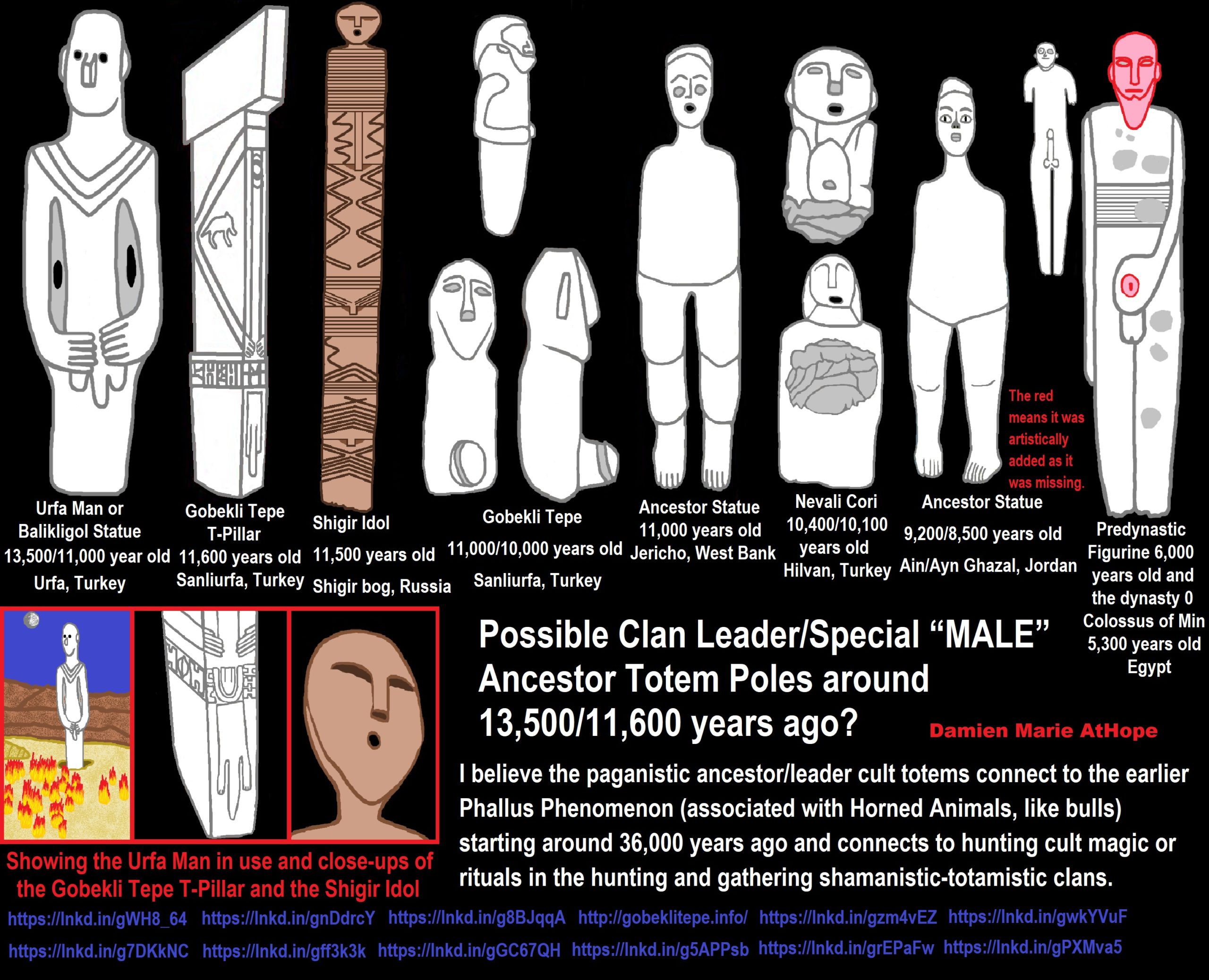
ref, ref, ref, ref, ref, ref, ref, ref, ref, ref, ref, ref, ref
I believe the paganistic ancestor/leader cult totems connect to the earlier Phallus Phenomenon (associated with Horned Animals, like bulls) starting around 36,000 years ago and connects to hunting cult magic or rituals in the hunting and gathering shamanistic-totamistic clans.
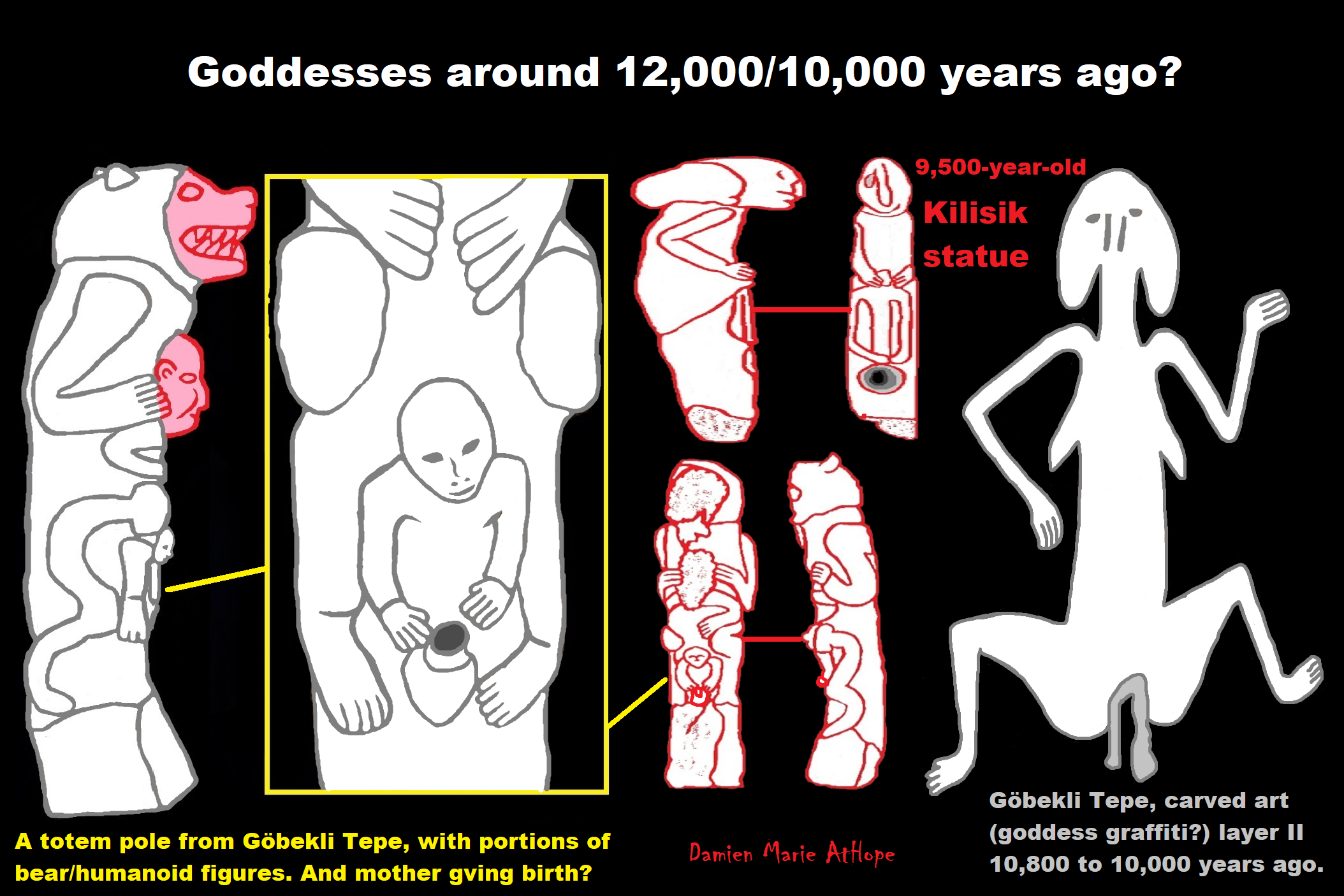
10,800-10,000 years old “Göbekli Tepe, engraving of a female person from layer II.” ref
The Ochre Painted Stones from the Riparo Dalmeri (Trento). Development of the Research on the Art and Rituality of the Epigravettian Site https://www.researchgate.net/publication/285689545_The_Ochre_Painted_Stones_from_the_Riparo_Dalmeri_Trento_Development_of_the_Research_on_the_Art_and_Rituality_of_the_Epigravettian_Site
“The Epigravettian is the last stage of the Upper Paleolithic succeeded by Mesolithic cultures after 10,000 BP. In a genetic study published in Nature in May 2016, the remains an Epigravettian male from Ripari Villabruna in Italy were examined. He carried the paternal haplogroup R1b1 and the maternal haplogroup U5b. An Epigravettian from the Satsurblia Cave in Georgia examined in a previous study has been found to be carrying the paternal haplogroup J2 and the maternal haplogroup K3.” ref
Paleolithic Y–chromosomal haplogroups by chronological period
- Proto-Aurignacian (47,000 to 43,000 years before present; eastern Europe): F
- Aurignacian Culture (43,000 to 28,000 ybp ; all ice-free Europe): CT, C1a, C1b, I
- Gravettian Culture (31,000 to 24,000 ybp ; all ice-free Europe): BT, CT, F, C1a2
- Solutrean Culture (22,000 to 17,000 ybp ; France, Spain): ?
- Epiravettian Culture (22,000 to 8,000 ybp ; Italy): R1b1a
- Magdalenian Culture 17,000 to 12,000 ybp ; Western Europe): IJK, I
- Epipaleolithic France (13,000 to 10,000 ybp): I
- Azilian Culture (12,000 to 9,000 ybp; Western Europe): I2 ref
“According to ancient DNA studies, R1a and the majority of R1b would have expanded from the Caspian Sea along with the Indo-European languages. R1b1a (R-L754) contains the vast majority of R1b. The only known example of R-L754* (xL389, V88) is also the earliest known individual to carry R1b: “Villabruna 1“, who lived circa 14,000 years BP (north east Italy). Villabruna 1 belonged to the Epigravettian culture.” ref
R1b include:
- Villabruna 1 (individual I9030), a Western Hunter-Gatherer (WHG), found in an Epigravettian culture setting in the Cismon valley (modern Veneto, Italy), who lived circa 14000 BP and belonged to R1b1a.
- Several males of the Iron Gates Mesolithic in the Balkans buried between 11200 and 8200 BP carried R1b1a1a. These individuals were determined to be largely of WHG ancestry, with slight Eastern Hunter-Gatherer (EHG) admixture.
- Several males of the Mesolithic Kunda culture and Neolithic Narva culture buried in the Zvejnieki burial ground in modern-day Latvia c. 9500–6000 BP carried R1b1b. These individuals were determined to be largely of WHG ancestry, with slight EHG admixture.
- Several Mesolithic and Neolithic males buried at Deriivka and Vasil’evka in modern-day Ukraine c. 9500-7000 BP carried R1b1a. These individuals were largely of EHG ancestry, with significant WHG admixture.
- A WHG male buried at Ostrovul Corbuli, Romania c. 8700 BP carried R1b1c.
- A male buried at Lepenski Vir, Serbia c. 8200-7900 BP carried R1b1a.
- An EHG buried near Samara, Russia 7500 BP carried R1b1a1a.
- An Eneolithic male buried at Khvalynsk, Russia c. 7200-6000 BP carried R1b1a.
- A Neolithic male buried at Els Trocs, Spain c. 7178-7066 BP, who may have belonged to the Epi-Cardial culture, was found to be a carrier of R1b1.
- A Late Chalcolithic male buried in Smyadovo, Bulgaria c. 6500 BP carried R1b1a.
- An Early Copper Age male buried in Cannas di Sotto, Carbonia, Sardinia c. 6450 BP carried R1b1b2.
- A male of the Baalberge group in Central Europe buried c. 5600 BP carried R1b1a.
- A male of the Botai culture in Central Asia buried c. 5500 BP carried R1b1a1 (R1b-M478).
- Males of the closely related Yamnaya culture (c. 5300-4800 BP) Afanasievo culture (5300-4500 BP), Catacomb culture (4800-3700 BP), Poltavka culture (4700-4100 BP), and Bell Beaker culture (4800-3800 BP) of Eurasia overwhelmingly carry R1b1a1a2a2.” ref
“R1b is a subclade within the “macro-haplogroup” K (M9), the most common group of human male lines outside of Africa. K is believed to have originated in Asia (as is the case with an even earlier ancestral haplogroup, F (F-M89). Karafet T. et al. (2014) “rapid diversification process of K-M526 likely occurred in Southeast Asia, with subsequent westward expansions of the ancestors of haplogroups R and Q“.” ref
“Three genetic studies in 2015 gave support to the Kurgan hypothesis of Marija Gimbutas regarding the Proto-Indo-European homeland. According to those studies, haplogroups R1b-M269 and R1a, now the most common in Europe (R1a is also common in South Asia) would have expanded from the West Eurasian Steppe, along with the Indo-European languages; they also detected an autosomal component present in modern Europeans which was not present in Neolithic Europeans, which would have been introduced with paternal lineages R1b and R1a, as well as Indo-European languages.” ref
“R-M269 has received significant scientific and popular interest due to its possible connection to the Indo-European expansion in Europe. Specifically, the R-L23 (R-Z2103) subclade has been found to be prevalent in ancient DNA associated with the Yamna culture. Seven individuals were determined to belong to the R1b-M269 subclade. Older research, published before researchers could study the DNA of ancient remains, proposed that R-M269 likely originated in Western Asia and was present in Europe by the Neolithic period.” ref
“But results based on actual ancient DNA noticed that there was a dearth of R-M269 in Europe before the Bronze Age, and the distribution of subclades within Europe is substantially due to the various migrations of the Bronze and Iron Age. Likewise, the oldest samples classified as belonging to R-M269, have been found in Eastern Europe and Pontic-Caspian steppe, not Western Asia. Western European populations are divided between the R-P312/S116 and R-U106/S21 subclades of R-M412 (R-L51).” ref
“The distribution of R-M269 in Europe increases in frequency from east to west. It peaks at the national level in Wales at a rate of 92%, at 82% in Ireland, 70% in Scotland, 68% in Spain, 60% in France (76% in Normandy), about 60% in Portugal, 45% in Eastern England, 50% in Germany, 50% in the Netherlands, 42% in Iceland, and 43% in Denmark, 39% in Italy. R-M269 reaches levels as high as 95% in parts of Ireland. It has also been found at lower frequencies throughout central Eurasia, but with relatively high frequency among the Bashkirs of the Perm region (84.0%). This marker is present in China and India at frequencies of less than one percent. In North Africa and adjoining islands, while R-V88 (R1b1a2) is more strongly represented, R-M269 appears to have been present since antiquity.” ref
“R-M269 has been found, for instance, at a rate of ~44% among remains dating from the 11th to 13th centuries at Punta Azul, in the Canary Islands. These remains have been linked to the Bimbache (or Bimape), a subgroup of the Guanche. In living males, it peaks in parts of North Africa, especially Algeria, at a rate of 10%. In Sub-Saharan Africa, R-M269 appears to peak in Namibia, at a rate of 8% among Herero males. In western Asia, R-M269 has been reported in 40% of Armenian males and over 35% in Turkmen males. (The table below lists in more detail the frequencies of M269 in regions in Asia, Europe, and Africa.)” ref
R1b1a2 (R-V88)
“R1b1a2 (PF6279/V88; previously R1b1c) is defined by the presence of SNP marker V88, the discovery of which was announced in 2010 by Cruciani et al. Apart from individuals in southern Europe and Western Asia, the majority of R-V88 was found in the Sahel, especially among populations speaking Afroasiatic languages of the Chadic branch.” ref
“Studies in 2005–08 reported “R1b*” at high levels in Jordan, Egypt, and Sudan. Subsequent research by Myres et al. (2011) indicates that the samples concerned most likely belong to the subclade R-V88, which is now concentrated in Sub-Saharan Africa. According to Myres et al. (2011), this may be explained by a back-migration from Asia into Africa by R1b-carrying people. Gonzales et al (2013), using more advanced techniques, indicate that it is equally probable that V88 originated in central Africa and spread northward toward Asia. However, Shriner, D., & Rotimi, C. N. (2018), associate the introduction of R1b into Chad, with the more recent movements of Baggara Arabs.” ref
“D’Atanasio et al. (2018) propose that R1b-V88 originated in Europe about 12 000 years ago and crossed to North Africa by about 8000 years ago; it may formerly have been common in southern Europe, where it has since been replaced by waves of other haplogroups, leaving remnant subclades almost exclusively in Sardinia. It first radiated within Africa likely between 7 and 8 000 years ago – at the same time as trans-Saharan expansions within the unrelated haplogroups E-M2 and A-M13 – possibly due to population growth allowed by humid conditions and the adoption of livestock herding in the Sahara. R1b-V1589, the main subclade within R1b-V88, underwent a further expansion around 5500 years ago, likely in the Lake Chad Basin region, from which some lines recrossed the Sahara to North Africa.” ref
“Marcus et al. (2020) provide strong evidence for this proposed model of North to South trans-Saharan movement: The earliest basal R1b-V88 haplogroups are found in several Eastern European Hunter-Gatherers close to 10,000 years ago. The haplogroup then seemingly further spread with the Neolithic Cardial Ware expansion, which established agriculture in the Western Mediterranean around 7500 BP: R1b-V88 haplogroups were identified in ancient Neolithic individuals in central Italy, Iberia, and, at a particularly high frequency, in Sardinia. A part of the branch leading to present-day African haplogroups (V2197) is already derived in some of these ancient Neolithic European individuals, providing further support for a North to South trans-Saharan movement.” ref
“The other primary branch of R1b1 is R-PH155 (R1b1b), which is extremely rare and defined by the presence of PH155. Living males carrying subclades of R-PH155 have been found in Bahrain, Bhutan, Ladakh, Tajikistan, Turkey, Xinjiang, and Yunnan. ISOGG (2017) cites two primary branches: R-M335 (R1b1b1) and R-PH200 (R1b1b2).” ref
“The defining SNP of R1b1b1, M335, was first documented in 2004, when an example was discovered in Turkey, though it was classified at that time as R1b4. Other examples of R-M335 have been reported in a sample of Hui from Yunnan, China and in a sample of people from Ladakh, India.” ref

The number of settlements contemporaneous with Gobekli Tepe Layer II (assigned to Pre-Pottery Neolithic B: 10,800 – 8,500 years ago) increased amongst the Neolithic settlements in the Urfa region and become widespread all around the region.
- Gobekli Tepe, 2. Nevali Cori, 3. Tasli Tepe, 4. Kurt Tepesi, 5. Sefer Tepe, 6. Karahan Tepe, 7. Harbetsuvan Tepesi, 8. Hamzan Tepe, 9. Urfa, 10. Ayanlar Hoyuk/Gaziantep, 11. Kilisik, 12. Tell Abr 3, 13. Boncuklu Tarla, 14. Gusir Hoyuk, 15. Nemrik 9, 16. Qermez Dere, 17. Hasankeyf, 18. Cayonu, 19. Hallan Cemi, 20. Demirci, 21. Kortik Tepe, 22. Mureybet, 23. Cheik Hassan, 24. Jerf el Ahmar, 25. Dja’de, 26. Tell Abr, 27. Akarcay, and 28. Tell Qarmel
Göbekli Tepe is not alone, in fact, it is part of a religious/cultural connected ritual culture in the general region. There are several other similar sites with similar T-pillars to Göbekli Tepe or other types of stone pillar providing a seeming connected cult belief or religious culture of pillars seen in the PPNA-PPNB in the northern portion of the Near East.
“The locations of the sites that contain “T” shaped pillars are the main topic that needs more understanding to grasp the larger sociocultural-religious cultural complex in the same general region. Another matter under discussion is to comprehend the differences between the small-scale settlements that contain cult centers and “T” shaped pillars and the larger ones found at Gobekli Tepe layer III. The fact that settlements with “T” shaped pillars contain both the remains of circular domestic buildings and the pillars such as seen at Cayonu and Nevali Cori, which are also known to contain cult and domestic buildings. It is contemplated that such settlements are contemporary with Gobekli Tepe layer II and the cult building known from Nevali Cori based on the similarities and differences of the “T” shaped pillars. In the light of the finds unearthed from the settlements in Şanliurfa region that contain “T” shaped pillars, such settlements should be dated to the end of Late Pre-Pottery Neolithic A (LPPNA) and the Early Pre-Pottery Neolithic B (EPPNB).” ref
Domesticating Space: Construction, Community, and Cosmology in the Late Prehistoric Near East
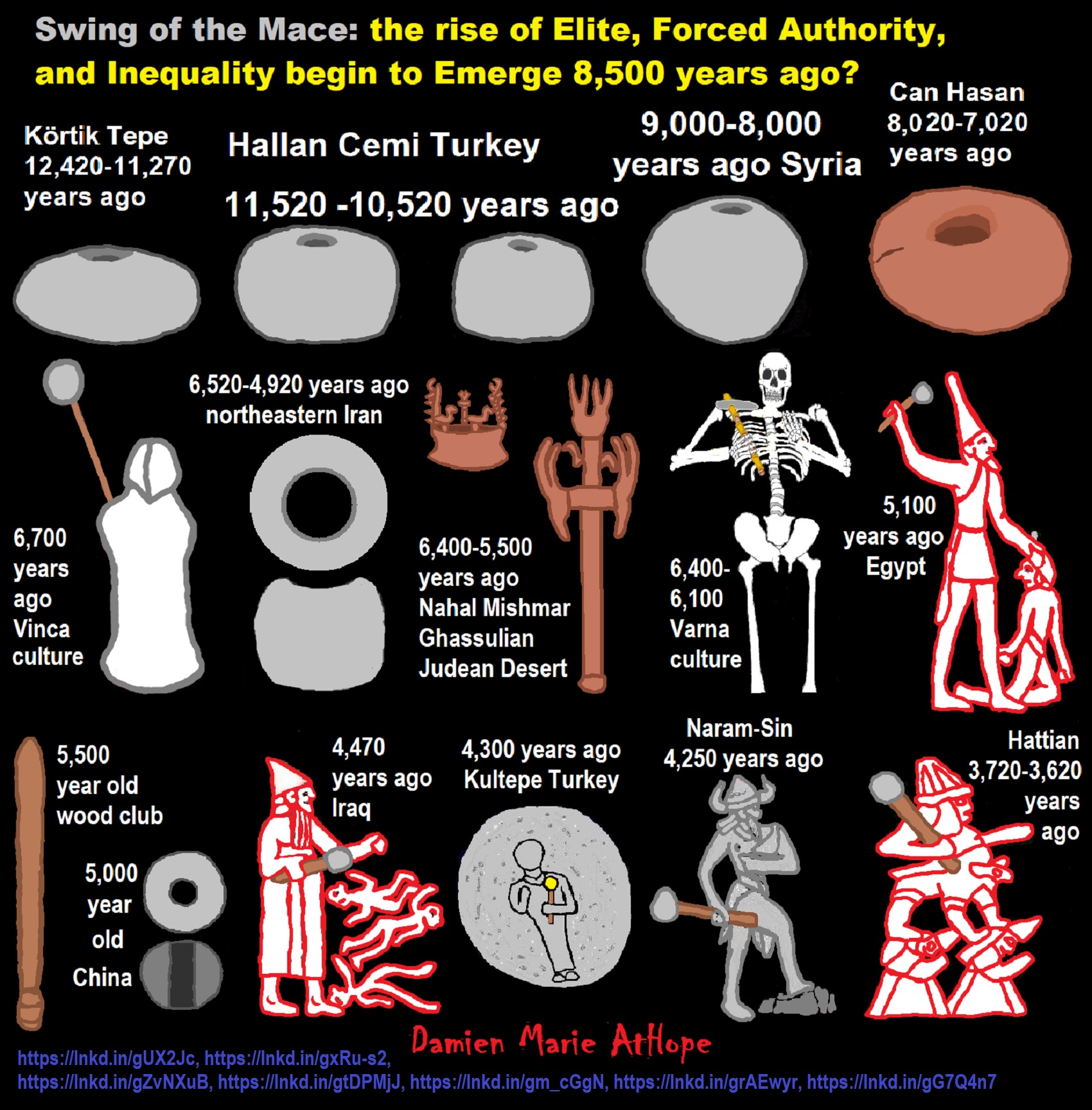
Haplogroup R1a Y-DNA
“Haplogroup R* originated in North Asia just before the Last Glacial Maximum (26,500-19,000 years before present). This haplogroup has been identified in the 24,000 year-old remains of the so-called “Mal’ta boy” from the Altai region, in south-central Siberia (Raghavan et al. 2013). This individual belonged to a tribe of mammoth hunters that may have roamed across Siberia and parts of Europe during the Paleolithic. Autosomally this Paleolithic population appears to have passed on its genes mostly to the modern populations of Europea and South Asia, the two regions where haplogroup R also happens to be the most common nowadays (R1b in Western Europe, R1a in Eastern Europe, Central and South Asia, and R2 in South Asia).” ref
“The series of mutations that made haplogroup R1* evolve into R1a probably took place during or soon after the Last Glacial Maxium. Little is know for certain about R1a’s place of origin. Some think it might have originated in the Balkans or around Pakistan and Northwest India, due to the greater genetic diversity found in these regions. The diversity can be explained by other factors though. The Balkans have been subject to 5000 years of migrations from the Eurasian Steppes, each bringing new varieties of R1a. South Asia has had a much bigger population than any other parts of the world (occasionally equalled by China) for at least 10,000 years, and larger population bring about more genetic diversity. The most likely place of origin of R1a is Central Asia or southern Russia/Siberia.” ref
“From there, R1a could have migrated directly to eastern Europe (European Russia, Ukraine, Belarus), or first southward through Central Asia and Iran. In that latter scenario, R1a would have crossed the Caucasus during the Neolithic, alongside R1b, to colonize the Pontic-Caspian Steppe. In the absence of ancient Y-DNA from those regions the best evidence supporting a Late Paleolithic migration to Iran is the presence of very old subclades of R1a (like M420) in the region, notably in the Zagros mountains. However, these samples only make up a fraction of all R1a in the region and could just as well represent the descendants of Eastern European hunter-gatherers who branched off from other R1a tribes and crossed from the North Caucasus any time between 20,000 and 8,000 years ago. The logic behind this is that most known historical migrations in Eurasia took place from north to south, as people sought warmer climes. The only exception happened during the Holocene warming up of the climate, which corresponds to the Neolithic colonization of Europe from the Near East. A third possibility is that R1a tribes split in two around Kazakhstan during the Late Paleolithic, with one group moving to eastern Europe, while the other moved south to Iran.” ref
Did R1a come to Europe with Neolithic farmers ?
“Some people have theorized that R1a was one of the lineages of the Neolithic farmers, and would have entered Europe through Anatolia, then spread across the Balkans toward Central Europe, then only to Eastern Europe. There are many issues with this scenario. The first is that 99% of modern R1a descends from the branch R1a-M417, which clearly expanded from the Bronze Age onwards, not from the early Neolithic. Its phylogeny also points at an Eastern European origin. Secondly, most of the R1a in Middle East are deep subclades of the R1a-Z93 branch, which originated in Russia. It could not have been ancestral to Balkanic or Central European R1a. Thirdly, there is a very strong correlation between the Northeast European autosomal admixture and R1a populations, and this component is missing from the genome of all European Neolithic farmers tested to date – even from Ötzi, who was a Chalcolithic farmer. This admixture is also missing from modern Sardinians, who are mostly descended from Neolithic farmers. This is incontrovertible evidence that R1a did not come to Europe with Neolithic farmers, but only propagated from Eastern Europe to the rest of Europe from the Bronze Age onwards.” ref
Bronze Age Proto-Indo-Europeans
“R1a is thought to have been the dominant haplogroup among the northern and eastern Proto-Indo-European tribes, who evolved into the Indo-Iranian, Thracian, Baltic and Slavic people. The Proto-Indo-Europeans originated in the Yamna culture (3300-2500 BCE). Their dramatic expansion was possible thanks to an early adoption of bronze weapons and the domestication of the horse in the Eurasian steppes (circa 4000-3500 BCE). Individuals from the southern part of the Steppe are believed to have carried predominantly lineages belonging to haplogroup R1b (L23 and subclades), while the people of northern forest-steppe to the north would have belonged essentially to haplogroup R1a. The first expansion of the forest-steppe people occurred with the Corded Ware Culture (see Germanic branch below). The forest-steppe origin of this culture is obvious from the usage of corded pottery and the abundant use of polished battle axes, the two most prominent features of the Corded Ware culture. This is also probably the time when the satemisation process of the Indo-European languages began, considering that the Balto-Slavic and Indo-Iranian language groups belong to the same Satem isogloss and both appear to have evolved from the Catacomb and Srubna cultures. Ancient DNA testing has confirmed the presence of haplogroup R1a-M417 in samples from the Corded Ware culture in Germany (2600 BCE), from Tocharian mummies (2000 BCE) in Northwest China, from Kurgan burials (circa 1600 BCE) from the Andronovo culture in southern Russia and southern Siberia, as well as from a variety of Iron-age sites from Russia, Siberia, Mongolia, and Central Asia.” ref
Haplogroup R1b Y-DNA
“Haplogroup R* originated in North Asia just before the Last Glacial Maximum (26,500-19,000 years ago). This haplogroup has been identified in the remains of a 24,000 year-old boy from the Altai region, in south-central Siberia (Raghavan et al. 2013). This individual belonged to a tribe of mammoth hunters that may have roamed across Siberia and parts of Europe during the Paleolithic. Autosomally this Paleolithic population appears to have contributed mostly to the ancestry of modern Europeans and South Asians, the two regions where haplogroup R also happens to be the most common nowadays (R1b in Western Europe, R1a in Eastern Europe, Central and South Asia, and R2 in South Asia).” ref
“The oldest forms of R1b (M343, P25, L389) are found dispersed at very low frequencies from Western Europe to India, a vast region where could have roamed the nomadic R1b hunter-gatherers during the Ice Age. The three main branches of R1b1 (R1b1a, R1b1b, R1b1c) all seem to have stemmed from the Middle East. The southern branch, R1b1c (V88), is found mostly in the Levant and Africa. The northern branch, R1b1a (P297), seems to have originated around the Caucasus, eastern Anatolia or northern Mesopotamia, then to have crossed over the Caucasus, from where they would have invaded Europe and Central Asia. R1b1b (M335) has only been found in Anatolia.” ref
R1b Neolithic cattle herders?
“It has been hypothesized that R1b people (perhaps alongside neighboring J2 tribes) were the first to domesticate cattle in northern Mesopotamia some 10,500 years ago. R1b tribes descended from mammoth hunters, and when mammoths went extinct, they started hunting other large game such as bisons and aurochs. With the increase of the human population in the Fertile Crescent from the beginning of the Neolithic (starting 12,000 years ago), selective hunting and culling of herds started replacing the indiscriminate killing of wild animals. The increased involvement of humans in the life of aurochs, wild boars, and goats led to their progressive taming. Cattle herders probably maintained a nomadic or semi-nomadic existence, while other people in the Fertile Crescent (presumably represented by haplogroups E1b1b, G, and T) settled down to cultivate the land or keep smaller domesticates.” ref
“The analysis of bovine DNA has revealed that all the taurine cattle (Bos taurus) alive today descend from a population of only 80 aurochs. The earliest evidence of cattle domestication dates from circa 8,500 BCE in the Pre-Pottery Neolithic cultures in the Taurus Mountains. The two oldest archaeological sites showing signs of cattle domestication are the villages of Çayönü Tepesi in southeastern Turkey and Dja’de el-Mughara in northern Iraq, two sites only 250 km away from each others. This is presumably the area from which R1b lineages started expanding – or in other words the “original homeland” of R1b.” ref
“The early R1b cattle herders would have split in at least three groups. One branch (M335) remained in Anatolia, but judging from its extreme rarity today wasn’t very successful, perhaps due to the heavy competition with other Neolithic populations in Anatolia, or to the scarcity of pastures in this mountainous environment. A second branch migrated south to the Levant, where it became the V88 branch. Some of them searched for new lands south in Africa, first in Egypt, then colonizing most of northern Africa, from the Mediterranean coast to the Sahel. The third branch (P297), crossed the Caucasus into the vast Pontic-Caspian Steppe, which provided ideal grazing grounds for cattle. They split into two factions: R1b1a1 (M73), which went east along the Caspian Sea to Central Asia, and R1b1a2 (M269), which at first remained in the North Caucasus and the Pontic Steppe between the Dnieper and the Volga. It is not yet clear whether M73 actually migrated across the Caucasus and reached Central Asia via Kazakhstan, or if it went south through Iran and Turkmenistan. In any case, M73 would be a pre-Indo-European branch of R1b, just like V88 and M335.” ref
“R1b-M269 (the most common form in Europe) is closely associated with the diffusion of Indo-European languages, as attested by its presence in all regions of the world where Indo-European languages were spoken in ancient times, from the Atlantic coast of Europe to the Indian subcontinent, which comprised almost all Europe (except Finland, Sardinia, and Bosnia-Herzegovina), Anatolia, Armenia, European Russia, southern Siberia, many pockets around Central Asia (notably in Xinjiang, Turkmenistan, Tajikistan, and Afghanistan), without forgetting Iran, Pakistan, northern India, and Nepal. The history of R1b and R1a are intricately connected to each others.” ref
The Levantine & African branch of R1b (V88)
“Like its northern counterpart (R1b-M269), R1b-V88 is associated with the domestication of cattle in northern Mesopotamia. Both branches of R1b probably split soon after cattle were domesticated, approximately 10,500 years ago (8,500 BCE). R1b-V88 migrated south towards the Levant and Egypt. The migration of R1b people can be followed archeologically through the presence of domesticated cattle, which appear in central Syria around 8,000-7,500 BCE (late Mureybet period), then in the Southern Levant and Egypt around 7,000-6,500 BCE (e.g. at Nabta Playa and Bir Kiseiba). Cattle herders subsequently spread across most of northern and eastern Africa. The Sahara desert would have been more humid during the Neolithic Subpluvial period (c. 7250-3250 BCE), and would have been a vast savannah full of grass, an ideal environment for cattle herding.” ref
“Evidence of cow herding during the Neolithic has shown up at Uan Muhuggiag in central Libya around 5500 BCE, at the Capeletti Cave in northern Algeria around 4500 BCE. But the most compelling evidence that R1b people related to modern Europeans once roamed the Sahara is to be found at Tassili n’Ajjer in southern Algeria, a site famous pyroglyphs (rock art) dating from the Neolithic era. Some paintings dating from around 3000 BCE depict fair-skinned and blond or auburn haired women riding on cows. The oldest known R1b-V88 sample in Europe is a 6,200 year-old farmer/herder from Catalonia tested by Haak et al. (2015). Autosomally this individual was a typical Near Eastern farmer, possessing just a little bit of Mesolithic West European admixture. After reaching the Maghreb, R1b-V88 cattle herders could have crossed the Strait of Gibraltar to Iberia, probably accompanied by G2 farmers, J1, and T1a goat herders. These North African Neolithic farmers/herders could have been the ones who established the Almagra Pottery culture in Andalusia in the 6th millennium BCE.” ref
“Nowadays small percentages (1 to 4%) of R1b-V88 are found in the Levant, among the Lebanese, the Druze, and the Jews, and almost in every country in Africa north of the equator. Higher frequency in Egypt (5%), among Berbers from the Egypt-Libya border (23%), among the Sudanese Copts (15%), the Hausa people of Sudan (40%), the Fulani people of the Sahel (54% in Niger and Cameroon), and Chadic tribes of northern Nigeria and northern Cameroon (especially among the Kirdi), where it is observed at a frequency ranging from 30% to 95% of men. According to Cruciani et al. (2010) R1b-V88 would have crossed the Sahara between 9,200 and 5,600 years ago, and is most probably associated with the diffusion of Chadic languages, a branch of the Afroasiatic languages. V88 would have migrated from Egypt to Sudan, then expanded along the Sahel until northern Cameroon and Nigeria. However, R1b-V88 is not only present among Chadic speakers, but also among Senegambian speakers (Fula-Hausa) and Semitic speakers (Berbers, Arabs).” ref
“R1b-V88 is found among the native populations of Rwanda, South Africa, Namibia, Angola, Congo, Gabon, Equatorial Guinea, Ivory Coast, Guinea-Bissau. The wide distribution of V88 in all parts of Africa, its incidence among herding tribes, and the coalescence age of the haplogroup all support a Neolithic dispersal. In any case, a later migration out of Egypt would be improbable since it would have brought haplogroups that came to Egypt during the Bronze Age, such as J1, J2, R1a, or R1b-L23. The maternal lineages associated with the spread of R1b-V88 in Africa are mtDNA haplogroups J1b, U5, and V, and perhaps also U3 and some H subclades (=> see Retracing the mtDNA haplogroups of the original R1b people).” ref
The North Caucasus and the Pontic-Caspian steppe : the Indo-European link
“Modern linguists have placed the Proto-Indo-European homeland in the Pontic-Caspian Steppe, a distinct geographic and archeological region extending from the Danube estuary to the Ural mountains to the east and North Caucasus to the south. The Neolithic, Eneolithic, and early Bronze Age cultures in Pontic-Caspian steppe has been called the Kurgan culture (4200-2200 BCE) by Marija Gimbutas, due to the lasting practice of burying the deads under mounds (“kurgan”) among the succession of cultures in that region. It is now known that kurgan-type burials only date from the 4th Millenium BCE and almost certainly originated south of the Caucasus. The genetic diversity of R1b being greater around eastern Anatolia, it is hard to deny that R1b evolved there before entering the steppe world.” ref
“Horses were first domesticated around 4600 BCE in the Caspian Steppe, perhaps somewhere around the Don or the lower Volga, and soon became a defining element of steppe culture. Nevertheless, it is unlikely that R1b was already present in the eastern steppes at the time, so the domestication of the horse should be attributed to the indigenous R1a people, or tribes belonging to the older R1b-P297 branch, which settled in eastern Europe during the Late Paleolithic or Mesolithic period. Samples from Mesolithic Samara (Haak 2015) and Latvia (Jones 2017) all belonged to R1b-P297. Autosomally these Mesolithic R1a and R1b individuals were nearly pure Mesolithic East European, sometimes with a bit of Siberian admixture, but lacked the additional Caucasian admixture found in the Chalcolithic Afanasevo, Yamna, and Corded Ware samples.” ref
“It is not yet entirely clear when R1b-M269 crossed over from the South Caucasus to the Pontic-Caspian steppe. This might have happened with the appearance of the Dnieper-Donets culture (c. 5100-4300 BCE). This was the first truly Neolithic society in the Pontic-Caspian Steppe. Domesticated animals (cattle, sheep, and goats) were herded throughout the steppes and funeral rituals were elaborate. Sheep wool would play an important role in Indo-European society, notably in the Celtic and Germanic (R1b branches of the Indo-Europeans) clothing traditions up to this day. However, many elements indicate a continuity in the Dnieper-Donets culture with the previous Mesolithic hunter-gatherers, and at the same time an influence from the Balkans and Carpathians, with regular imports of pottery and copper objects. It is therefore more likely that Dnieper-Donets marked the transition of indigenous R1a and/or I2a1b people to early agriculture, perhaps with an influx of Near Eastern farmers from ‘Old Europe’. Over 30 DNA samples from Neolithic Ukraine (5500-4800 BCE) were tested by Mathieson et al. (2017). They belonged to Y-haplogroups I, I2a2, R1a, R1b1a (L754), and one R1b1a2 (L388). None of them belonged to R1b-M269 or R1b-L23 clades, which dominated during the Yamna period. Mitochondrial lineages were also exclusively of Mesolithic European origin (U4a, U4b, U4d, U5a1, U5a2, U5b2, as well as one J2b1 and one U2e1).” ref
“None of those maternal lineages include typical Indo-European haplogroups, like H2a1, H6, H8, H15, I1a1, J1b1a, W3, W4, or W5 that would later show up in the Yamna, Corded Ware, and Unetice cultures. Indeed, autosomally genomes from Neolithic Ukraine were purely Mesolithic European (about 90% EHG and 10% WHG) and completely lacked the Caucasian (CHG) admxiture later found in Yamna and subsequent Indo-European cultures during the Bronze Age. The first clearly Proto-Indo-European cultures were the Khvalynsk (5200-4500 BCE) and Sredny Stog (4600-3900 BCE) cultures in the Pontic-Caspian Steppe. This is when small kurgan burials begin to appear, with the distinctive posturing of the dead on the back with knees raised and oriented toward the northeast, which would be found in later steppe cultures as well. There is evidence of population blending from the variety of skull shapes. Towards the end of the 5th millennium, an elite starts to develop with cattle, horses, and copper used as status symbols. It is at the turn of the Khvalynsk and Sredny Stog periods that R1b-M269’s main subclade, L23, is thought to have appeared, around 4,500 BCE. 99% of Indo-European R1b descends from this L23 clade. The other branch descended from M269 is PF7562, which is found mostly in the Balkans, Turkey, and Armenia today, and may represent an early Steppe migration to the Balkans dating from the Sredny Stog period.” ref
“Another migration across the Caucasus happened shortly before 3700 BCE, when the Maykop culture, the world’s first Bronze Age society, suddenly materialised in the north-west Caucasus, apparently out of nowhere. The origins of Maykop are still uncertain, but archeologists have linked it to contemporary Chalcolithic cultures in Assyria and western Iran. Archeology also shows a clear diffusion of bronze working and kurgan-type burials from the Maykop culture to the Pontic Steppe, where the Yamna culture developed soon afterwards (from 3500 BCE). Kurgan (a.k.a. tumulus) burials would become a dominant feature of ancient Indo-European societies and were widely used by the Celts, Romans, Germanic tribes, and Scythians, among others.” ref
“The Yamna period (3500-2500 BCE) is the most important one in the creation of Indo-European culture and society. Middle Eastern R1b-M269 people had been living and blending to some extent with the local R1a foragers and herders for over a millennium, perhaps even two or three. The close cultural contact and interactions between R1a and R1b people all over the Pontic-Caspian Steppe resulted in the creation of a common vernacular, a new lingua franca, which linguists have called Proto-Indo-European (PIE). It is pointless to try to assign another region of origin to the PIE language. Linguistic similarities exist between PIE and Caucasian and Hurrian languages in the Middle East on the one hand, and Uralic languages in the Volga-Ural region on the other hand, which makes the Pontic Steppe the perfect intermediary region. During the Yamna period cattle and sheep herders adopted wagons to transport their food and tents, which allowed them to move deeper into the steppe, giving rise to a new mobile lifestyle that would eventually lead to the great Indo-European migrations. This type of mass migration in which whole tribes moved with the help of wagons was still common in Gaul at the time of Julius Caesar, and among Germanic peoples in the late Antiquity.” ref
“The Yamna horizon was not a single, unified culture. In the south, along the northern shores of the Black Sea coast until the north-west Caucasus, was a region of open steppe, expanding eastward until the Caspian Sea, Siberia, and Mongolia (the Eurasian Steppe). The western section, between the Don and Dniester Rivers (and later the Danube), was the one most densely settled by R1b people, with only a minority of R1a people (5-10%). The eastern section, in the Volga basin until the Ural mountains, was inhabited by R1a people with a substantial minority of R1b people (whose descendants can be found among the Bashkirs, Turkmans, Uyghurs, and Hazaras, among others). The northern part of the Yamna horizon was forest-steppe occupied by R1a people, also joined by a small minority of R1b (judging from Corded Ware samples and from modern Russians and Belarussians, whose frequency of R1b is from seven to nine times lower than R1a). The western branch would migrate to the Balkans and Greece, then to Central and Western Europe, and back to their ancestral Anatolia in successive waves (Hittites, Phrygians, Armenians, etc.). The eastern branch would migrate to Central Asia, Xinjiang, Siberia, and South Asia (Iran, Pakistan, India). The northern branch would evolve into the Corded Ware culture and disperse around the Baltic, Poland, Germany, and Scandinavia.” ref
The Maykop culture, the R1b link to the Steppe?
“The Maykop culture (3700-2500 BCE) in the north-west Caucasus was culturally speaking a sort of southern extension of the Yamna horizon. Although not generally considered part of the Pontic-Caspian steppe culture due to its geography, the North Caucasus had close links with the steppes, as attested by numerous ceramics, gold, copper, and bronze weapons and jewelry in the contemporaneous cultures of Mikhaylovka, Sredny Stog, and Kemi Oba. The link between the northern Black Sea coast and the North Caucasus is older than the Maykop period. Its predecessor, the Svobodnoe culture (4400-3700 BCE), already had links to the Suvorovo-Novodanilovka and early Sredny Stog cultures. The even older Nalchik settlement (5000-4500 BCE) in the North Caucasus displayed a similar culture as Khvalynsk in the Caspian Steppe and Volga region. This may be the period when R1b started interacting and blending with the R1a population of the steppes.” ref
“The Yamna and Maykop people both used kurgan burials, placing their deads in a supine position with raised knees and oriented in a north-east/south-west axis. Graves were sprinkled with red ochre on the floor, and sacrificed domestic animal buried alongside humans. They also had in common horses, wagons, a heavily cattle-based economy with a minority of sheep kept for their wool, use of copper/bronze battle-axes (both hammer-axes and sleeved axes), and tanged daggers. In fact, the oldest wagons and bronze artifacts are found in the North Caucasus, and appear to have spread from there to the steppes.” ref
“Maykop was an advanced Bronze Age culture, actually one of the very first to develop metalworking, and therefore metal weapons. The world’s oldest sword was found at a late Maykop grave in Klady kurgan 31. Its style is reminiscent of the long Celtic swords, though less elaborated. Horse bones and depictions of horses already appear in early Maykop graves, suggesting that the Maykop culture might have been founded by steppe people or by people who had close link with them. However, the presence of cultural elements radically different from the steppe culture in some sites could mean that Maykop had a hybrid population. Without DNA testing it is impossible to say if these two populations were an Anatolian R1b group and a G2a Caucasian group, or whether R1a people had settled there too. The two or three ethnicities might even have cohabited side by side in different settlements. The one typical Caucasian Y-DNA lineage that does follow the pattern of Indo-European migrations is G2a-L13, which is found throughout Europe, Central Asia, and South Asia. In the Balkans, the Danube basin, and Central Europe its frequency is somewhat proportional to the percentage of R1b.” ref
“Maykop people are the ones credited for the introduction of primitive wheeled vehicles (wagons) from Mesopotamia to the Steppe. This would revolutionize the way of life in the steppe, and would later lead to the development of (horse-drawn) war chariots around 2000 BCE. Cavalry and chariots played an vital role in the subsequent Indo-European migrations, allowing them to move quickly and defeat easily anybody they encountered. Combined with advanced bronze weapons and their sea-based culture, the western branch (R1b) of the Indo-Europeans from the Black Sea shores are excellent candidates for being the mysterious Sea Peoples, who raided the eastern shores of the Mediterranean during the second millennium BCE.” ref
“The rise of the IE-speaking Hittites in Central Anatolia happened a few centuries after the disappearance of the Maykop and Yamna cultures. Considering that most Indo-European forms of R1b found in Anatolia today belong to the R1b-Z2103 subclade, it makes little doubt that the Hittites came to Anatolia via the Balkans, after Yamna/Maykop people invaded Southeast Europe. The Maykop and Yamna cultures were succeeded by the Srubna culture (1600-1200 BCE), possibly representing an advance of R1a-Z282 people from the northern steppes towards the Black Sea shores, filling the vacuum left by the R1b tribes who migrated to Southeast Europe and Anatolia.” ref

Animism: Respecting the Living World by Graham Harvey
“How have human cultures engaged with and thought about animals, plants, rocks, clouds, and other elements in their natural surroundings? Do animals and other natural objects have a spirit or soul? What is their relationship to humans? In this new study, Graham Harvey explores current and past animistic beliefs and practices of Native Americans, Maori, Aboriginal Australians, and eco-pagans. He considers the varieties of animism found in these cultures as well as their shared desire to live respectfully within larger natural communities. Drawing on his extensive casework, Harvey also considers the linguistic, performative, ecological, and activist implications of these different animisms.” ref


My thoughts on Religion Evolution with external links for more info:
- (Pre-Animism Africa mainly, but also Europe, and Asia at least 300,000 years ago), (Pre-Animism – Oxford Dictionaries)
- (Animism Africa around 100,000 years ago), (Animism – Britannica.com)
- (Totemism Europe around 50,000 years ago), (Totemism – Anthropology)
- (Shamanism Siberia around 30,000 years ago), (Shamanism – Britannica.com)
- (Paganism Turkey around 12,000 years ago), (Paganism – BBC Religion)
- (Progressed Organized Religion “Institutional Religion” Egypt around 5,000 years ago), (Ancient Egyptian Religion – Britannica.com)
- (CURRENT “World” RELIGIONS after 4,000 years ago) (Origin of Major Religions – Sacred Texts)
- (Early Atheistic Doubting at least by 2,600 years ago) (History of Atheism – Wikipedia)
“Religion is an Evolved Product” and Yes, Religion is Like Fear Given Wings…
Atheists talk about gods and religions for the same reason doctors talk about cancer, they are looking for a cure, or a firefighter talks about fires because they burn people and they care to stop them. We atheists too often feel a need to help the victims of mental slavery, held in the bondage that is the false beliefs of gods and the conspiracy theories of reality found in religions.
Understanding Religion Evolution:
- Pre-Animism (at least 300,000 years ago)
- Animism (Africa: 100,000 years ago)
- Totemism (Europe: 50,000 years ago)
- Shamanism (Siberia: 30,000 years ago)
- Paganism (Turkey: 12,000 years ago)
- Progressed organized religion (Egypt: 5,000 years ago), (Egypt, the First Dynasty 5,150 years ago)
- CURRENT “World” RELIGIONS (after 4,000 years ago)
- Early Atheistic Doubting (at least by 2,600 years ago)
“An Archaeological/Anthropological Understanding of Religion Evolution”
It seems ancient peoples had to survived amazing threats in a “dangerous universe (by superstition perceived as good and evil),” and human “immorality or imperfection of the soul” which was thought to affect the still living, leading to ancestor worship. This ancestor worship presumably led to the belief in supernatural beings, and then some of these were turned into the belief in gods. This feeble myth called gods were just a human conceived “made from nothing into something over and over, changing, again and again, taking on more as they evolve, all the while they are thought to be special,” but it is just supernatural animistic spirit-belief perceived as sacred.
Quick Evolution of Religion?
Pre-Animism (at least 300,000 years ago) pre-religion is a beginning that evolves into later Animism. So, Religion as we think of it, to me, all starts in a general way with Animism (Africa: 100,000 years ago) (theoretical belief in supernatural powers/spirits), then this is physically expressed in or with Totemism (Europe: 50,000 years ago) (theoretical belief in mythical relationship with powers/spirits through a totem item), which then enlists a full-time specific person to do this worship and believed interacting Shamanism (Siberia/Russia: 30,000 years ago) (theoretical belief in access and influence with spirits through ritual), and then there is the further employment of myths and gods added to all the above giving you Paganism (Turkey: 12,000 years ago) (often a lot more nature-based than most current top world religions, thus hinting to their close link to more ancient religious thinking it stems from). My hypothesis is expressed with an explanation of the building of a theatrical house (modern religions development). Progressed organized religion (Egypt: 5,000 years ago) with CURRENT “World” RELIGIONS (after 4,000 years ago).
Historically, in large city-state societies (such as Egypt or Iraq) starting around 5,000 years ago culminated to make religion something kind of new, a sociocultural-governmental-religious monarchy, where all or at least many of the people of such large city-state societies seem familiar with and committed to the existence of “religion” as the integrated life identity package of control dynamics with a fixed closed magical doctrine, but this juggernaut integrated religion identity package of Dogmatic-Propaganda certainly did not exist or if developed to an extent it was highly limited in most smaller prehistoric societies as they seem to lack most of the strong control dynamics with a fixed closed magical doctrine (magical beliefs could be at times be added or removed). Many people just want to see developed religious dynamics everywhere even if it is not. Instead, all that is found is largely fragments until the domestication of religion.
Religions, as we think of them today, are a new fad, even if they go back to around 6,000 years in the timeline of human existence, this amounts to almost nothing when seen in the long slow evolution of religion at least around 70,000 years ago with one of the oldest ritual worship. Stone Snake of South Africa: “first human worship” 70,000 years ago. This message of how religion and gods among them are clearly a man-made thing that was developed slowly as it was invented and then implemented peace by peace discrediting them all. Which seems to be a simple point some are just not grasping how devastating to any claims of truth when we can see the lie clearly in the archeological sites.
I wish people fought as hard for the actual values as they fight for the group/clan names political or otherwise they think support values. Every amount spent on war is theft to children in need of food or the homeless kept from shelter.
Here are several of my blog posts on history:
- To Find Truth You Must First Look
- (Magdalenian/Iberomaurusian) Connections to the First Paganists of the early Neolithic Near East Dating from around 17,000 to 12,000 Years Ago
- Natufians: an Ancient People at the Origins of Agriculture and Sedentary Life
- Possible Clan Leader/Special “MALE” Ancestor Totem Poles At Least 13,500 years ago?
- Jewish People with DNA at least 13,200 years old, Judaism, and the Origins of Some of its Ideas
- Baltic Reindeer Hunters: Swiderian, Lyngby, Ahrensburgian, and Krasnosillya cultures 12,020 to 11,020 years ago are evidence of powerful migratory waves during the last 13,000 years and a genetic link to Saami and the Finno-Ugric peoples.
- The Rise of Inequality: patriarchy and state hierarchy inequality
- Fertile Crescent 12,500 – 9,500 Years Ago: fertility and death cult belief system?
- 12,400 – 11,700 Years Ago – Kortik Tepe (Turkey) Pre/early-Agriculture Cultic Ritualism
- Ritualistic Bird Symbolism at Gobekli Tepe and its “Ancestor Cult”
- Male-Homosexual (female-like) / Trans-woman (female) Seated Figurine from Gobekli Tepe
- Could a 12,000-year-old Bull Geoglyph at Göbekli Tepe relate to older Bull and Female Art 25,000 years ago and Later Goddess and the Bull cults like Catal Huyuk?
- Sedentism and the Creation of goddesses around 12,000 years ago as well as male gods after 7,000 years ago.
- Alcohol, where Agriculture and Religion Become one? Such as Gobekli Tepe’s Ritualistic use of Grain as Food and Ritual Drink
- Neolithic Ritual Sites with T-Pillars and other Cultic Pillars
- Paganism: Goddesses around 12,000 years ago then Male Gods after 7,000 years ago
- First Patriarchy: Split of Women’s Status around 12,000 years ago & First Hierarchy: fall of Women’s Status around 5,000 years ago.
- Natufians: an Ancient People at the Origins of Agriculture and Sedentary Life
- J DNA and the Spread of Agricultural Religion (paganism)
- Paganism: an approximately 12,000-year-old belief system
- Paganism 12,000 years old: related to “Anarchism and Socialism” (Pre-Capitalism)
- Shaman burial in Israel 12,000 years ago and the Shamanism Phenomena
- Need to Mythicized: gods and goddesses
- 12,000 – 7,000 Years Ago – Paleo-Indian Culture (The Americas)
- 12,000 – 2,000 Years Ago – Indigenous-Scandinavians (Nordic)
- Norse did not wear helmets with horns?
- Pre-Pottery Neolithic Skull Cult around 11,500 to 8,400 Years Ago?
- 10,400 – 10,100 Years Ago, in Turkey the Nevail Cori Religious Settlement
- 9,000-6,500 Years Old Submerged Pre-Pottery/Pottery Neolithic Ritual Settlements off Israel’s Coast
- Catal Huyuk “first religious designed city” around 9,500 to 7,700 years ago (Turkey)
- Cultic Hunting at Catal Huyuk “first religious designed city”
- Special Items and Art as well as Special Elite Burials at Catal Huyuk
- New Rituals and Violence with the appearance of Pottery and People?
- Haplogroup N and its related Uralic Languages and Cultures
- Ainu people, Sámi people, Native Americans, the Ancient North Eurasians, and Paganistic-Shamanism with Totemism
- Ideas, Technology and People from Turkey, Europe, to China and Back again 9,000 to 5,000 years ago?
- First Pottery of Europe and the Related Cultures
- 9,000 years old Neolithic Artifacts Judean Desert and Hills Israel
- 9,000-7,000 years-old Sex and Death Rituals: Cult Sites in Israel, Jordan, and the Sinai
- 9,000-8500 year old Horned Female shaman Bad Dürrenberg Germany
- Neolithic Jewelry and the Spread of Farming in Europe Emerging out of West Turkey
- 8,600-year-old Tortoise Shells in Neolithic graves in central China have Early Writing and Shamanism
- Swing of the Mace: the rise of Elite, Forced Authority, and Inequality begin to Emerge 8,500 years ago?
- Migrations and Changing Europeans Beginning around 8,000 Years Ago
- My “Steppe-Anatolian-Kurgan hypothesis” 8,000/7,000 years ago
- Around 8,000-year-old Shared Idea of the Mistress of Animals, “Ritual” Motif
- Pre-Columbian Red-Paint (red ochre) Maritime Archaic Culture 8,000-3,000 years ago
- 7,522-6,522 years ago Linear Pottery culture which I think relates to Arcane Capitalism’s origins
- Arcane Capitalism: Primitive socialism, Primitive capital, Private ownership, Means of production, Market capitalism, Class discrimination, and Petite bourgeoisie (smaller capitalists)
- 7,500-4,750 years old Ritualistic Cucuteni-Trypillian culture of Moldova, Romania, and Ukraine
- Roots of a changing early society 7,200-6,700 years ago Jordan and Israel
- Agriculture religion (Paganism) with farming reached Britain between about 7,000 to 6,500 or so years ago and seemingly expressed in things like Western Europe’s Long Barrows
- My Thoughts on Possible Migrations of “R” DNA and Proto-Indo-European?
- “Millet” Spreading from China 7,022 years ago to Europe and related Language may have Spread with it leading to Proto-Indo-European
- Proto-Indo-European (PIE), ancestor of Indo-European languages: DNA, Society, Language, and Mythology
- The Dnieper–Donets culture and Asian varieties of Millet from China to the Black Sea region of Europe by 7,022 years ago
- Kurgan 6,000 years ago/dolmens 7,000 years ago: funeral, ritual, and other?
- 7,020 to 6,020-year-old Proto-Indo-European Homeland of Urheimat or proposed home of their Language and Religion
- Ancient Megaliths: Kurgan, Ziggurat, Pyramid, Menhir, Trilithon, Dolman, Kromlech, and Kromlech of Trilithons
- The Mytheme of Ancient North Eurasian Sacred-Dog belief and similar motifs are found in Indo-European, Native American, and Siberian comparative mythology
- Elite Power Accumulation: Ancient Trade, Tokens, Writing, Wealth, Merchants, and Priest-Kings
- Sacred Mounds, Mountains, Kurgans, and Pyramids may hold deep connections?
- Between 7,000-5,000 Years ago, rise of unequal hierarchy elite, leading to a “birth of the State” or worship of power, strong new sexism, oppression of non-elites, and the fall of Women’s equal status
- Paganism 7,000-5,000 years old: related to “Anarchism and Socialism” (Capitalism) (World War 0) Elite & their slaves
- Hell and Underworld mythologies starting maybe as far back as 7,000 to 5,000 years ago with the Proto-Indo-Europeans?
- The First Expression of the Male God around 7,000 years ago?
- White (light complexion skin) Bigotry and Sexism started 7,000 years ago?
- Around 7,000-year-old Shared Idea of the Divine Bird (Tutelary and/or Trickster spirit/deity), “Ritual” Motif
- Nekhbet an Ancient Egyptian Vulture Goddess and Tutelary Deity
- 6,720 to 4,920 years old Ritualistic Hongshan Culture of Inner Mongolia with 5,000-year-old Pyramid Mounds and Temples
- First proto-king in the Balkans, Varna culture around 6,500 years ago?
- 6,500–5,800 years ago in Israel Late Chalcolithic (Copper Age) Period in the Southern Levant Seems to Express Northern Levant Migrations, Cultural and Religious Transfer
- KING OF BEASTS: Master of Animals “Ritual” Motif, around 6,000 years old or older…
- Around 6000-year-old Shared Idea of the Solid Wheel & the Spoked Wheel-Shaped Ritual Motif
- “The Ghassulian Star,” a mysterious 6,000-year-old mural from Jordan; a Proto-Star of Ishtar, Star of Inanna or Star of Venus?
- Religious/Ritual Ideas, including goddesses and gods as well as ritual mounds or pyramids from Northeastern Asia at least 6,000 years old, seemingly filtering to Iran, Iraq, the Mediterranean, Europe, Egypt, and the Americas?
- Maykop (5,720–5,020 years ago) Caucasus region Bronze Age culture-related to Copper Age farmers from the south, influenced by the Ubaid period and Leyla-Tepe culture, as well as influencing the Kura-Araxes culture
- 5-600-year-old Tomb, Mummy, and First Bearded Male Figurine in a Grave
- Kura-Araxes Cultural 5,520 to 4,470 years old DNA traces to the Canaanites, Arabs, and Jews
- Minoan/Cretan (Keftiu) Civilization and Religion around 5,520 to 3,120 years ago
- Evolution Of Science at least by 5,500 years ago
- 5,500 Years old birth of the State, the rise of Hierarchy, and the fall of Women’s status
- “Jiroft culture” 5,100 – 4,200 years ago and the History of Iran
- Stonehenge: Paganistic Burial and Astrological Ritual Complex, England (5,100-3,600 years ago)
- Around 5,000-year-old Shared Idea of the “Tree of Life” Ritual Motif
- Complex rituals for elite, seen from China to Egypt, at least by 5,000 years ago
- Around 5,000 years ago: “Birth of the State” where Religion gets Military Power and Influence
- The Center of the World “Axis Mundi” and/or “Sacred Mountains” Mythology Could Relate to the Altai Mountains, Heart of the Steppe
- Progressed organized religion starts, an approximately 5,000-year-old belief system
- China’s Civilization between 5,000-3,000 years ago, was a time of war and class struggle, violent transition from free clans to a Slave or Elite society
- Origin of Logics is Naturalistic Observation at least by around 5,000 years ago.
- Paganism 5,000 years old: progressed organized religion and the state: related to “Anarchism and Socialism” (Kings and the Rise of the State)
- Ziggurats (multi-platform temples: 4,900 years old) to Pyramids (multi-platform tombs: 4,700 years old)
- Did a 4,520–4,420-year-old Volcano In Turkey Inspire the Bible God?
- Finland’s Horned Shaman and Pre-Horned-God at least 4,500 years ago?
- 4,000-year-Old Dolmens in Israel: A Connected Dolmen Religious Phenomenon?
- Creation myths: From chaos, Ex nihilo, Earth-diver, Emergence, World egg, and World parent
- Bronze Age “Ritual” connections of the Bell Beaker culture with the Corded Ware/Single Grave culture, which were related to the Yamnaya culture and Proto-Indo-European Languages/Religions
- Low Gods (Earth/ Tutelary deity), High Gods (Sky/Supreme deity), and Moralistic Gods (Deity enforcement/divine order)
- The exchange of people, ideas, and material-culture including, to me, the new god (Sky Father) and goddess (Earth Mother) religion between the Cucuteni-Trypillians and others which is then spread far and wide
- Koryaks: Indigenous People of the Russian Far East and Big Raven myths also found in Tlingit, Haida, Tsimshian, and other Indigenous People of North America
- 42 Principles Of Maat (Egyptian Goddess of the justice) around 4,400 years ago, 2000 Years Before Ten Commandments
- “Happy Easter” Well Happy Eostre/Ishter
- 4,320-3,820 years old “Shimao” (North China) site with Totemistic-Shamanistic Paganism and a Stepped Pyramid
- 4,250 to 3,400 Year old Stonehenge from Russia: Arkaim?
- 4,100-year-old beaker with medicinal & flowering plants in a grave of a woman in Scotland
- Early European Farmer ancestry, Kelif el Boroud people with the Cardial Ware culture, and the Bell Beaker culture Paganists too, spread into North Africa, then to the Canary Islands off West Africa
- Flood Accounts: Gilgamesh epic (4,100 years ago) Noah in Genesis (2,600 years ago)
- Paganism 4,000 years old: related to “Anarchism and Socialism” (First Moralistic gods, then the Origin time of Monotheism)
- When was the beginning: TIMELINE OF CURRENT RELIGIONS, which start around 4,000 years ago.
- Early Religions Thought to Express Proto-Monotheistic Systems around 4,000 years ago
- Kultepe? An archaeological site with a 4,000 years old women’s rights document.
- Single God Religions (Monotheism) = “Man-o-theism” started around 4,000 years ago with the Great Sky Spirit/God Tiān (天)?
- Confucianism’s Tiān (Shangdi god 4,000 years old): Supernaturalism, Pantheism or Theism?
- Yes, Your Male God is Ridiculous
- Mythology, a Lunar Deity is a Goddess or God of the Moon
- Sacred Land, Hills, and Mountains: Sami Mythology (Paganistic Shamanism)
- Horse Worship/Sacrifice: mythical union of Ruling Elite/Kingship and the Horse
- The Amorite/Amurru people’s God Amurru “Lord of the Steppe”, relates to the Origins of the Bible God?
- Bronze Age Exotic Trade Routes Spread Quite Far as well as Spread Religious Ideas with Them
- Sami and the Northern Indigenous Peoples Landscape, Language, and its Connection to Religion
- Prototype of Ancient Analemmatic Sundials around 3,900-3,150 years ago and a Possible Solar Connection to gods?
- Judaism is around 3,450 or 3,250 years old. (“Paleo-Hebrew” 3,000 years ago and Torah 2,500 years ago)
- The Weakening of Ancient Trade and the Strengthening of Religions around 3000 years ago?
- Are you aware that there are religions that worship women gods, explain now religion tears women down?
- Animistic, Totemistic, and Paganistic Superstition Origins of bible god and the bible’s Religion.
- Myths and Folklore: “Trickster gods and goddesses”
- Jews, Judaism, and the Origins of Some of its Ideas
- An Old Branch of Religion Still Giving Fruit: Sacred Trees
- Dating the BIBLE: naming names and telling times (written less than 3,000 years ago, provable to 2,200 years ago)
- Did a Volcano Inspire the bible god?
- The Amorite/Amurru people’s God Amurru “Lord of the Steppe”, relates to the Origins of the Bible God?
- Dené–Yeniseian language, Old Copper Complex, and Pre-Columbian Mound Builders?
- No “dinosaurs and humans didn’t exist together just because some think they are in the bible itself”
- Sacred Shit and Sacred Animals?
- Everyone Killed in the Bible Flood? “Nephilim” (giants)?
- Hey, Damien dude, I have a question for you regarding “the bible” Exodus.
- Archaeology Disproves the Bible
- Bible Battle, Just More, Bible Babble
- The Jericho Conquest lie?
- Canaanites and Israelites?
- Accurate Account on how did Christianity Began?
- Let’s talk about Christianity.
- So the 10 commandments isn’t anything to go by either right?
- Misinformed christian
- Debunking Jesus?
- Paulism vs Jesus
- Ok, you seem confused so let’s talk about Buddhism.
- Unacknowledged Buddhism: Gods, Savior, Demons, Rebirth, Heavens, Hells, and Terrorism
- His Foolishness The Dalai Lama
- Yin and Yang is sexist with an ORIGIN around 2,300 years ago?
- I Believe Archaeology, not Myths & Why Not, as the Religious Myths Already Violate Reason!
- Archaeological, Scientific, & Philosophic evidence shows the god myth is man-made nonsense.
- Aquatic Ape Theory/Hypothesis? As Always, Just Pseudoscience.
- Ancient Aliens Conspiracy Theorists are Pseudohistorians
- The Pseudohistoric and Pseudoscientific claims about “Bakoni Ruins” of South Africa
- Why do people think Religion is much more than supernaturalism and superstitionism?
- Religion is an Evolved Product
- Was the Value of Ancient Women Different?
- 1000 to 1100 CE, human sacrifice Cahokia Mounds a pre-Columbian Native American site
- Feminist atheists as far back as the 1800s?
- Promoting Religion as Real is Mentally Harmful to a Flourishing Humanity
- Screw All Religions and Their Toxic lies, they are all fraud
- Forget Religions’ Unfounded Myths, I Have Substantiated “Archaeology Facts.”
- Religion Dispersal throughout the World
- I Hate Religion Just as I Hate all Pseudoscience
- Exposing Scientology, Eckankar, Wicca and Other Nonsense?
- Main deity or religious belief systems
- Quit Trying to Invent Your God From the Scraps of Science.
- Archaeological, Scientific, & Philosophic evidence shows the god myth is man-made nonsense.
- Ancient Alien Conspiracy Theorists: Misunderstanding, Rhetoric, Misinformation, Fabrications, and Lies
- Misinformation, Distortion, and Pseudoscience in Talking with a Christian Creationist
- Judging the Lack of Goodness in Gods, Even the Norse God Odin
- Challenging the Belief in God-like Aliens and Gods in General
- A Challenge to Christian use of Torture Devices?
- Yes, Hinduism is a Religion
- Trump is One of the Most Reactionary Forces of Far-right Christian Extremism
- Was the Bull Head a Symbol of God? Yes!
- Primate Death Rituals
- Christian – “God and Christianity are objectively true”
- Australopithecus afarensis Death Ritual?
- You Claim Global Warming is a Hoax?
- Doubter of Science and Defamer of Atheists?
- I think that sounds like the Bible?
- History of the Antifa (“anti-fascist”) Movements
- Indianapolis Anti-Blasphemy Laws #Free Soheil Rally
- Damien, you repeat the golden rule in so many forms then you say religion is dogmatic?
- Science is a Trustable Methodology whereas Faith is not Trustable at all!
- Was I ever a believer, before I was an atheist?
- Atheists rise in reason
- Mistrust of science?
- Open to Talking About the Definition of ‘God’? But first, we address Faith.
- ‘United Monarchy’ full of splendor and power – Saul, David, and Solomon? Most likely not.
- Is there EXODUS ARCHAEOLOGY? The short answer is “no.”
- Lacking Proof of Bigfoots, Unicorns, and Gods is Just a Lack of Research?
- Religion and Politics: Faith Beliefs vs. Rational Thinking
- Hammer of Truth that lying pig RELIGION: challenged by an archaeologist
- “The Hammer of Truth” -ontology question- What do You Mean by That?
- Navigation of a bad argument: Ad Hominem vs. Attack
- Why is it Often Claimed that Gods have a Gender?
- Why are basically all monotheistic religions ones that have a male god?
- Shifting through the Claims in support of Faith
- Dear Mr. AtHope, The 20th Century is an Indictment of Secularism and a Failed Atheist Century
- An Understanding of the Worldwide Statistics and Dynamics of Terrorist Incidents and Suicide Attacks
- Intoxication and Evolution? Addressing and Assessing the “Stoned Ape” or “Drunken Monkey” Theories as Catalysts in Human Evolution
- Sacred Menstrual cloth? Inanna’s knot, Isis knot, and maybe Ma’at’s feather?
- Damien, why don’t the Hebrews accept the bible stories?
- Dealing with a Troll and Arguing Over Word Meaning
- Knowledge without Belief? Justified beliefs or disbeliefs worthy of Knowledge?
- Afrocentrism and African Religions
- Crecganford @crecganford offers history & stories of the people, places, gods, & culture
- Empiricism-Denier?
I am not an academic. I am a revolutionary that teaches in public, in places like social media, and in the streets. I am not a leader by some title given but from my commanding leadership style of simply to start teaching everywhere to everyone, all manner of positive education.






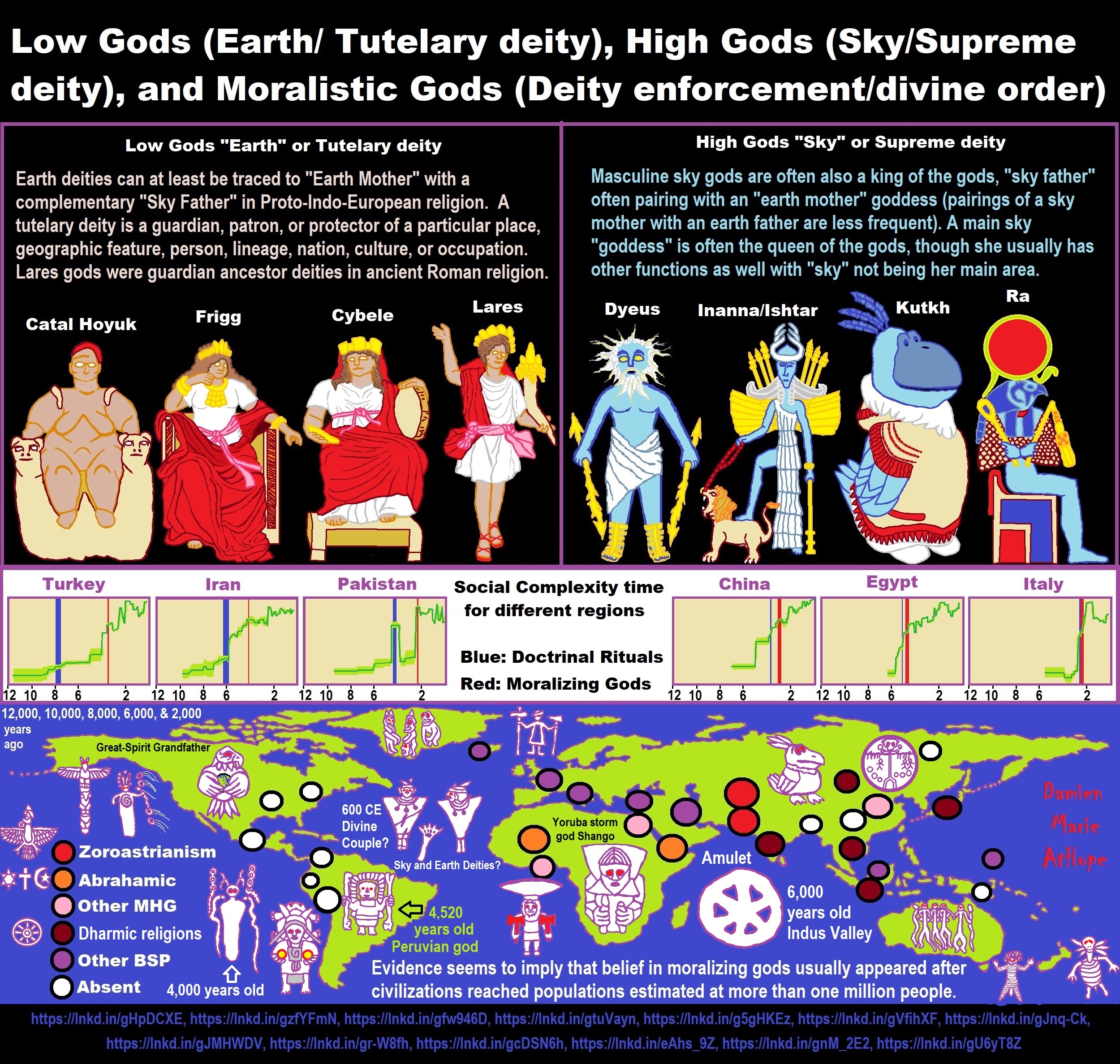
ref, ref, ref, ref, ref, ref, ref, ref, ref, ref, ref, ref, ref, ref, ref, ref, ref, ref, ref, ref, ref
Low Gods “Earth” or Tutelary deity and High Gods “Sky” or Supreme deity
“An Earth goddess is a deification of the Earth. Earth goddesses are often associated with the “chthonic” deities of the underworld. Ki and Ninhursag are Mesopotamian earth goddesses. In Greek mythology, the Earth is personified as Gaia, corresponding to Roman Terra, Indic Prithvi/Bhūmi, etc. traced to an “Earth Mother” complementary to the “Sky Father” in Proto-Indo-European religion. Egyptian mythology exceptionally has a sky goddess and an Earth god.” ref
“A mother goddess is a goddess who represents or is a personification of nature, motherhood, fertility, creation, destruction or who embodies the bounty of the Earth. When equated with the Earth or the natural world, such goddesses are sometimes referred to as Mother Earth or as the Earth Mother. In some religious traditions or movements, Heavenly Mother (also referred to as Mother in Heaven or Sky Mother) is the wife or feminine counterpart of the Sky father or God the Father.” ref
“Any masculine sky god is often also king of the gods, taking the position of patriarch within a pantheon. Such king gods are collectively categorized as “sky father” deities, with a polarity between sky and earth often being expressed by pairing a “sky father” god with an “earth mother” goddess (pairings of a sky mother with an earth father are less frequent). A main sky goddess is often the queen of the gods and may be an air/sky goddess in her own right, though she usually has other functions as well with “sky” not being her main. In antiquity, several sky goddesses in ancient Egypt, Mesopotamia, and the Near East were called Queen of Heaven. Neopagans often apply it with impunity to sky goddesses from other regions who were never associated with the term historically. The sky often has important religious significance. Many religions, both polytheistic and monotheistic, have deities associated with the sky.” ref
“In comparative mythology, sky father is a term for a recurring concept in polytheistic religions of a sky god who is addressed as a “father”, often the father of a pantheon and is often either a reigning or former King of the Gods. The concept of “sky father” may also be taken to include Sun gods with similar characteristics, such as Ra. The concept is complementary to an “earth mother“. “Sky Father” is a direct translation of the Vedic Dyaus Pita, etymologically descended from the same Proto-Indo-European deity name as the Greek Zeûs Pater and Roman Jupiter and Germanic Týr, Tir or Tiwaz, all of which are reflexes of the same Proto-Indo-European deity’s name, *Dyēus Ph₂tḗr. While there are numerous parallels adduced from outside of Indo-European mythology, there are exceptions (e.g. In Egyptian mythology, Nut is the sky mother and Geb is the earth father).” ref
Tutelary deity
“A tutelary (also tutelar) is a deity or spirit who is a guardian, patron, or protector of a particular place, geographic feature, person, lineage, nation, culture, or occupation. The etymology of “tutelary” expresses the concept of safety and thus of guardianship. In late Greek and Roman religion, one type of tutelary deity, the genius, functions as the personal deity or daimon of an individual from birth to death. Another form of personal tutelary spirit is the familiar spirit of European folklore.” ref
“A tutelary (also tutelar) in Korean shamanism, jangseung and sotdae were placed at the edge of villages to frighten off demons. They were also worshiped as deities. Seonangshin is the patron deity of the village in Korean tradition and was believed to embody the Seonangdang. In Philippine animism, Diwata or Lambana are deities or spirits that inhabit sacred places like mountains and mounds and serve as guardians. Such as: Maria Makiling is the deity who guards Mt. Makiling and Maria Cacao and Maria Sinukuan. In Shinto, the spirits, or kami, which give life to human bodies come from nature and return to it after death. Ancestors are therefore themselves tutelaries to be worshiped. And similarly, Native American beliefs such as Tonás, tutelary animal spirit among the Zapotec and Totems, familial or clan spirits among the Ojibwe, can be animals.” ref
“A tutelary (also tutelar) in Austronesian beliefs such as: Atua (gods and spirits of the Polynesian peoples such as the Māori or the Hawaiians), Hanitu (Bunun of Taiwan‘s term for spirit), Hyang (Kawi, Sundanese, Javanese, and Balinese Supreme Being, in ancient Java and Bali mythology and this spiritual entity, can be either divine or ancestral), Kaitiaki (New Zealand Māori term used for the concept of guardianship, for the sky, the sea, and the land), Kawas (mythology) (divided into 6 groups: gods, ancestors, souls of the living, spirits of living things, spirits of lifeless objects, and ghosts), Tiki (Māori mythology, Tiki is the first man created by either Tūmatauenga or Tāne and represents deified ancestors found in most Polynesian cultures). ” ref, ref, ref, ref, ref, ref, ref
Mesopotamian Tutelary Deities can be seen as ones related to City-States
“Historical city-states included Sumerian cities such as Uruk and Ur; Ancient Egyptian city-states, such as Thebes and Memphis; the Phoenician cities (such as Tyre and Sidon); the five Philistine city-states; the Berber city-states of the Garamantes; the city-states of ancient Greece (the poleis such as Athens, Sparta, Thebes, and Corinth); the Roman Republic (which grew from a city-state into a vast empire); the Italian city-states from the Middle Ages to the early modern period, such as Florence, Siena, Ferrara, Milan (which as they grew in power began to dominate neighboring cities) and Genoa and Venice, which became powerful thalassocracies; the Mayan and other cultures of pre-Columbian Mesoamerica (including cities such as Chichen Itza, Tikal, Copán and Monte Albán); the central Asian cities along the Silk Road; the city-states of the Swahili coast; Ragusa; states of the medieval Russian lands such as Novgorod and Pskov; and many others.” ref
“The Uruk period (ca. 4000 to 3100 BCE; also known as Protoliterate period) of Mesopotamia, named after the Sumerian city of Uruk, this period saw the emergence of urban life in Mesopotamia and the Sumerian civilization. City-States like Uruk and others had a patron tutelary City Deity along with a Priest-King.” ref
“Chinese folk religion, both past, and present, includes myriad tutelary deities. Exceptional individuals, highly cultivated sages, and prominent ancestors can be deified and honored after death. Lord Guan is the patron of military personnel and police, while Mazu is the patron of fishermen and sailors. Such as Tu Di Gong (Earth Deity) is the tutelary deity of a locality, and each individual locality has its own Earth Deity and Cheng Huang Gong (City God) is the guardian deity of an individual city, worshipped by local officials and locals since imperial times.” ref
“A tutelary (also tutelar) in Hinduism, personal tutelary deities are known as ishta-devata, while family tutelary deities are known as Kuladevata. Gramadevata are guardian deities of villages. Devas can also be seen as tutelary. Shiva is the patron of yogis and renunciants. City goddesses include: Mumbadevi (Mumbai), Sachchika (Osian); Kuladevis include: Ambika (Porwad), and Mahalakshmi. In NorthEast India Meitei mythology and religion (Sanamahism) of Manipur, there are various types of tutelary deities, among which Lam Lais are the most predominant ones. Tibetan Buddhism has Yidam as a tutelary deity. Dakini is the patron of those who seek knowledge.” ref
“A tutelary (also tutelar) The Greeks also thought deities guarded specific places: for instance, Athena was the patron goddess of the city of Athens. Socrates spoke of hearing the voice of his personal spirit or daimonion:
You have often heard me speak of an oracle or sign which comes to me … . This sign I have had ever since I was a child. The sign is a voice which comes to me and always forbids me to do something which I am going to do, but never commands me to do anything, and this is what stands in the way of my being a politician.” ref
“Tutelary deities who guard and preserve a place or a person are fundamental to ancient Roman religion. The tutelary deity of a man was his Genius, that of a woman her Juno. In the Imperial era, the Genius of the Emperor was a focus of Imperial cult. An emperor might also adopt a major deity as his personal patron or tutelary, as Augustus did Apollo. Precedents for claiming the personal protection of a deity were established in the Republican era, when for instance the Roman dictator Sulla advertised the goddess Victory as his tutelary by holding public games (ludi) in her honor.” ref
“Each town or city had one or more tutelary deities, whose protection was considered particularly vital in time of war and siege. Rome itself was protected by a goddess whose name was to be kept ritually secret on pain of death (for a supposed case, see Quintus Valerius Soranus). The Capitoline Triad of Juno, Jupiter, and Minerva were also tutelaries of Rome. The Italic towns had their own tutelary deities. Juno often had this function, as at the Latin town of Lanuvium and the Etruscan city of Veii, and was often housed in an especially grand temple on the arx (citadel) or other prominent or central location. The tutelary deity of Praeneste was Fortuna, whose oracle was renowned.” ref
“The Roman ritual of evocatio was premised on the belief that a town could be made vulnerable to military defeat if the power of its tutelary deity were diverted outside the city, perhaps by the offer of superior cult at Rome. The depiction of some goddesses such as the Magna Mater (Great Mother, or Cybele) as “tower-crowned” represents their capacity to preserve the city. A town in the provinces might adopt a deity from within the Roman religious sphere to serve as its guardian, or syncretize its own tutelary with such; for instance, a community within the civitas of the Remi in Gaul adopted Apollo as its tutelary, and at the capital of the Remi (present-day Rheims), the tutelary was Mars Camulus.” ref
Household deity (a kind of or related to a Tutelary deity)
“A household deity is a deity or spirit that protects the home, looking after the entire household or certain key members. It has been a common belief in paganism as well as in folklore across many parts of the world. Household deities fit into two types; firstly, a specific deity – typically a goddess – often referred to as a hearth goddess or domestic goddess who is associated with the home and hearth, such as the ancient Greek Hestia.” ref
“The second type of household deities are those that are not one singular deity, but a type, or species of animistic deity, who usually have lesser powers than major deities. This type was common in the religions of antiquity, such as the Lares of ancient Roman religion, the Gashin of Korean shamanism, and Cofgodas of Anglo-Saxon paganism. These survived Christianisation as fairy-like creatures existing in folklore, such as the Anglo-Scottish Brownie and Slavic Domovoy.” ref
“Household deities were usually worshipped not in temples but in the home, where they would be represented by small idols (such as the teraphim of the Bible, often translated as “household gods” in Genesis 31:19 for example), amulets, paintings, or reliefs. They could also be found on domestic objects, such as cosmetic articles in the case of Tawaret. The more prosperous houses might have a small shrine to the household god(s); the lararium served this purpose in the case of the Romans. The gods would be treated as members of the family and invited to join in meals, or be given offerings of food and drink.” ref
“In many religions, both ancient and modern, a god would preside over the home. Certain species, or types, of household deities, existed. An example of this was the Roman Lares. Many European cultures retained house spirits into the modern period. Some examples of these include:
- Brownie (Scotland and England) or Hob (England) / Kobold (Germany) / Goblin / Hobgoblin
- Domovoy (Slavic)
- Nisse (Norwegian or Danish) / Tomte (Swedish) / Tonttu (Finnish)
- Húsvættir (Norse)” ref
“Although the cosmic status of household deities was not as lofty as that of the Twelve Olympians or the Aesir, they were also jealous of their dignity and also had to be appeased with shrines and offerings, however humble. Because of their immediacy they had arguably more influence on the day-to-day affairs of men than the remote gods did. Vestiges of their worship persisted long after Christianity and other major religions extirpated nearly every trace of the major pagan pantheons. Elements of the practice can be seen even today, with Christian accretions, where statues to various saints (such as St. Francis) protect gardens and grottos. Even the gargoyles found on older churches, could be viewed as guardians partitioning a sacred space.” ref
“For centuries, Christianity fought a mop-up war against these lingering minor pagan deities, but they proved tenacious. For example, Martin Luther‘s Tischreden have numerous – quite serious – references to dealing with kobolds. Eventually, rationalism and the Industrial Revolution threatened to erase most of these minor deities, until the advent of romantic nationalism rehabilitated them and embellished them into objects of literary curiosity in the 19th century. Since the 20th century this literature has been mined for characters for role-playing games, video games, and other fantasy personae, not infrequently invested with invented traits and hierarchies somewhat different from their mythological and folkloric roots.” ref
“In contradistinction to both Herbert Spencer and Edward Burnett Tylor, who defended theories of animistic origins of ancestor worship, Émile Durkheim saw its origin in totemism. In reality, this distinction is somewhat academic, since totemism may be regarded as a particularized manifestation of animism, and something of a synthesis of the two positions was attempted by Sigmund Freud. In Freud’s Totem and Taboo, both totem and taboo are outward expressions or manifestations of the same psychological tendency, a concept which is complementary to, or which rather reconciles, the apparent conflict. Freud preferred to emphasize the psychoanalytic implications of the reification of metaphysical forces, but with particular emphasis on its familial nature. This emphasis underscores, rather than weakens, the ancestral component.” ref
“William Edward Hearn, a noted classicist, and jurist, traced the origin of domestic deities from the earliest stages as an expression of animism, a belief system thought to have existed also in the neolithic, and the forerunner of Indo-European religion. In his analysis of the Indo-European household, in Chapter II “The House Spirit”, Section 1, he states:
The belief which guided the conduct of our forefathers was … the spirit rule of dead ancestors.” ref
“In Section 2 he proceeds to elaborate:
It is thus certain that the worship of deceased ancestors is a vera causa, and not a mere hypothesis. …
In the other European nations, the Slavs, the Teutons, and the Kelts, the House Spirit appears with no less distinctness. … [T]he existence of that worship does not admit of doubt. … The House Spirits had a multitude of other names which it is needless here to enumerate, but all of which are more or less expressive of their friendly relations with man. … In [England] … [h]e is the Brownie. … In Scotland this same Brownie is well known. He is usually described as attached to particular families, with whom he has been known to reside for centuries, threshing the corn, cleaning the house, and performing similar household tasks. His favorite gratification was milk and honey.” ref

Hinduism around 3,700 to 3,500 years old. ref
Judaism around 3,450 or 3,250 years old. (The first writing in the bible was “Paleo-Hebrew” dated to around 3,000 years ago Khirbet Qeiyafa is the site of an ancient fortress city overlooking the Elah Valley. And many believe the religious Jewish texts were completed around 2,500) ref, ref
Judaism is around 3,450 or 3,250 years old. (“Paleo-Hebrew” 3,000 years ago and Torah 2,500 years ago)
“Judaism is an Abrahamic, its roots as an organized religion in the Middle East during the Bronze Age. Some scholars argue that modern Judaism evolved from Yahwism, the religion of ancient Israel and Judah, by the late 6th century BCE, and is thus considered to be one of the oldest monotheistic religions.” ref
“Yahwism is the name given by modern scholars to the religion of ancient Israel, essentially polytheistic, with a plethora of gods and goddesses. Heading the pantheon was Yahweh, the national god of the Israelite kingdoms of Israel and Judah, with his consort, the goddess Asherah; below them were second-tier gods and goddesses such as Baal, Shamash, Yarikh, Mot, and Astarte, all of whom had their own priests and prophets and numbered royalty among their devotees, and a third and fourth tier of minor divine beings, including the mal’ak, the messengers of the higher gods, who in later times became the angels of Judaism, Christianity and Islam. Yahweh, however, was not the ‘original’ god of Israel “Isra-El”; it is El, the head of the Canaanite pantheon, whose name forms the basis of the name “Israel”, and none of the Old Testament patriarchs, the tribes of Israel, the Judges, or the earliest monarchs, have a Yahwistic theophoric name (i.e., one incorporating the name of Yahweh).” ref
“El is a Northwest Semitic word meaning “god” or “deity“, or referring (as a proper name) to any one of multiple major ancient Near Eastern deities. A rarer form, ‘ila, represents the predicate form in Old Akkadian and in Amorite. The word is derived from the Proto-Semitic *ʔil-, meaning “god”. Specific deities known as ‘El or ‘Il include the supreme god of the ancient Canaanite religion and the supreme god of East Semitic speakers in Mesopotamia’s Early Dynastic Period. ʼĒl is listed at the head of many pantheons. In some Canaanite and Ugaritic sources, ʼĒl played a role as father of the gods, of creation, or both. For example, in the Ugaritic texts, ʾil mlk is understood to mean “ʼĒl the King” but ʾil hd as “the god Hadad“. The Semitic root ʾlh (Arabic ʾilāh, Aramaic ʾAlāh, ʾElāh, Hebrew ʾelōah) may be ʾl with a parasitic h, and ʾl may be an abbreviated form of ʾlh. In Ugaritic the plural form meaning “gods” is ʾilhm, equivalent to Hebrew ʾelōhîm “powers”. In the Hebrew texts this word is interpreted as being semantically singular for “god” by biblical commentators. However the documentary hypothesis for the Old Testament (corresponds to the Jewish Torah) developed originally in the 1870s, identifies these that different authors – the Jahwist, Elohist, Deuteronomist, and the Priestly source – were responsible for editing stories from a polytheistic religion into those of a monotheistic religion. Inconsistencies that arise between monotheism and polytheism in the texts are reflective of this hypothesis.” ref
Jainism around 2,599 – 2,527 years old. ref
Confucianism around 2,600 – 2,551 years old. ref
Buddhism around 2,563/2,480 – 2,483/2,400 years old. ref
Christianity around 2,o00 years old. ref
Shinto around 1,305 years old. ref
Islam around 1407–1385 years old. ref

Knowledge to Ponder:
Stars/Astrology:
- Possibly, around 30,000 years ago (in simpler form) to 6,000 years ago, Stars/Astrology are connected to Ancestors, Spirit Animals, and Deities.
- The star also seems to be a possible proto-star for Star of Ishtar, Star of Inanna, or Star of Venus.
- Around 7,000 to 6,000 years ago, Star Constellations/Astrology have connections to the “Kurgan phenomenon” of below-ground “mound” stone/wood burial structures and “Dolmen phenomenon” of above-ground stone burial structures.
- Around 6,500–5,800 years ago, The Northern Levant migrations into Jordon and Israel in the Southern Levant brought new cultural and religious transfer from Turkey and Iran.
- “The Ghassulian Star,” a mysterious 6,000-year-old mural from Jordan may have connections to the European paganstic kurgan/dolmens phenomenon.
“Astrology is a range of divinatory practices, recognized as pseudoscientific since the 18th century, that claim to discern information about human affairs and terrestrial events by studying the apparent positions of celestial objects. Different cultures have employed forms of astrology since at least the 2nd millennium BCE, these practices having originated in calendrical systems used to predict seasonal shifts and to interpret celestial cycles as signs of divine communications. Most, if not all, cultures have attached importance to what they observed in the sky, and some—such as the Hindus, Chinese, and the Maya—developed elaborate systems for predicting terrestrial events from celestial observations. Western astrology, one of the oldest astrological systems still in use, can trace its roots to 19th–17th century BCE Mesopotamia, from where it spread to Ancient Greece, Rome, the Islamicate world and eventually Central and Western Europe. Contemporary Western astrology is often associated with systems of horoscopes that purport to explain aspects of a person’s personality and predict significant events in their lives based on the positions of celestial objects; the majority of professional astrologers rely on such systems.” ref
Around 5,500 years ago, Science evolves, The first evidence of science was 5,500 years ago and was demonstrated by a body of empirical, theoretical, and practical knowledge about the natural world. ref
Around 5,000 years ago, Origin of Logics is a Naturalistic Observation (principles of valid reasoning, inference, & demonstration) ref
Around 4,150 to 4,000 years ago: The earliest surviving versions of the Sumerian Epic of Gilgamesh, which was originally titled “He who Saw the Deep” (Sha naqba īmuru) or “Surpassing All Other Kings” (Shūtur eli sharrī) were written. ref
Hinduism:
- 3,700 years ago or so, the oldest of the Hindu Vedas (scriptures), the Rig Veda was composed.
- 3,500 years ago or so, the Vedic Age began in India after the collapse of the Indus Valley Civilization.
Judaism:
- around 3,000 years ago, the first writing in the bible was “Paleo-Hebrew”
- around 2,500 years ago, many believe the religious Jewish texts were completed
Myths: The bible inspired religion is not just one religion or one myth but a grouping of several religions and myths
- Around 3,450 or 3,250 years ago, according to legend, is the traditionally accepted period in which the Israelite lawgiver, Moses, provided the Ten Commandments.
- Around 2,500 to 2,400 years ago, a collection of ancient religious writings by the Israelites based primarily upon the Hebrew Bible, Tanakh, or Old Testament is the first part of Christianity’s bible.
- Around 2,400 years ago, the most accepted hypothesis is that the canon was formed in stages, first the Pentateuch (Torah).
- Around 2,140 to 2,116 years ago, the Prophets was written during the Hasmonean dynasty, and finally the remaining books.
- Christians traditionally divide the Old Testament into four sections:
- The first five books or Pentateuch (Torah).
- The proposed history books telling the history of the Israelites from their conquest of Canaan to their defeat and exile in Babylon.
- The poetic and proposed “Wisdom books” dealing, in various forms, with questions of good and evil in the world.
- The books of the biblical prophets, warning of the consequences of turning away from God:
- Henotheism:
- Exodus 20:23 “You shall not make other gods besides Me (not saying there are no other gods just not to worship them); gods of silver or gods of gold, you shall not make for yourselves.”
- Polytheism:
- Judges 10:6 “Then the sons of Israel again did evil in the sight of the LORD, served the Baals and the Ashtaroth, the gods of Aram, the gods of Sidon, the gods of Moab, the gods of the sons of Ammon, and the gods of the Philistines; thus they forsook the LORD and did not serve Him.”
- 1 Corinthians 8:5 “For even if there are so-called gods whether in heaven or on earth, as indeed there are many gods and many lords.”
- Monotheism:
- Isaiah 43:10 “You are my witnesses,” declares the LORD, “and my servant whom I have chosen, so that you may know and believe me and understand that I am he. Before me no god was formed, nor will there be one after me.
Around 2,570 to 2,270 Years Ago, there is a confirmation of atheistic doubting as well as atheistic thinking, mainly by Greek philosophers. However, doubting gods is likely as old as the invention of gods and should destroy the thinking that belief in god(s) is the “default belief”. The Greek word is apistos (a “not” and pistos “faithful,”), thus not faithful or faithless because one is unpersuaded and unconvinced by a god(s) claim. Short Definition: unbelieving, unbeliever, or unbelief.

Expressions of Atheistic Thinking:
- Around 2,600 years ago, Ajita Kesakambali, ancient Indian philosopher, who is the first known proponent of Indian materialism. ref
- Around 2,535 to 2,475 years ago, Heraclitus, Greek pre-Socratic philosopher, a native of the Greek city Ephesus, Ionia, on the coast of Anatolia, also known as Asia Minor or modern Turkey. ref
- Around 2,500 to 2,400 years ago, according to The Story of Civilization book series certain African pygmy tribes have no identifiable gods, spirits, or religious beliefs or rituals, and even what burials accrue are without ceremony. ref
- Around 2,490 to 2,430 years ago, Empedocles, Greek pre-Socratic philosopher and a citizen of Agrigentum, a Greek city in Sicily. ref
- Around 2,460 to 2,370 years ago, Democritus, Greek pre-Socratic philosopher considered to be the “father of modern science” possibly had some disbelief amounting to atheism. ref
- Around 2,399 years ago or so, Socrates, a famous Greek philosopher was tried for sinfulness by teaching doubt of state gods. ref
- Around 2,341 to 2,270 years ago, Epicurus, a Greek philosopher known for composing atheistic critics and famously stated, “Is God willing to prevent evil, but not able? Then he is not omnipotent. Is he able, but not willing? Then he is malevolent. Is he both able and willing? Then whence cometh evil? Is he neither able nor willing? Then why call him god?” ref
This last expression by Epicurus, seems to be an expression of Axiological Atheism. To understand and utilize value or actually possess “Value Conscious/Consciousness” to both give a strong moral “axiological” argument (the problem of evil) as well as use it to fortify humanism and positive ethical persuasion of human helping and care responsibilities. Because value-blindness gives rise to sociopathic/psychopathic evil.



While hallucinogens are associated with shamanism, it is alcohol that is associated with paganism.
The Atheist-Humanist-Leftist Revolutionaries Shows in the prehistory series:
Show two: Pre-animism 300,000 years old and animism 100,000 years old: related to “Anarchism and Socialism”
Show tree: Totemism 50,000 years old: related to “Anarchism and Socialism”
Show four: Shamanism 30,000 years old: related to “Anarchism and Socialism”
Show five: Paganism 12,000 years old: related to “Anarchism and Socialism”
Show six: Emergence of hierarchy, sexism, slavery, and the new male god dominance: Paganism 7,000-5,000 years old: related to “Anarchism and Socialism” (Capitalism) (World War 0) Elite and their slaves!
Prehistory: related to “Anarchism and Socialism” the division of labor, power, rights, and recourses: VIDEO
Pre-animism 300,000 years old and animism 100,000 years old: related to “Anarchism and Socialism”: VIDEO
Totemism 50,000 years old: related to “Anarchism and Socialism”: VIDEO
Shamanism 30,000 years old: related to “Anarchism and Socialism”: VIDEO
Paganism 12,000 years old: related to “Anarchism and Socialism” (Pre-Capitalism): VIDEO
Paganism 7,000-5,000 years old: related to “Anarchism and Socialism” (Capitalism) (World War 0) Elite and their slaves: VIEDO
Paganism 5,000 years old: progressed organized religion and the state: related to “Anarchism and Socialism” (Kings and the Rise of the State): VIEDO
Paganism 4,000 years old: related to “Anarchism and Socialism” (First Moralistic gods, then the Origin time of Monotheism): VIEDO
I do not hate simply because I challenge and expose myths or lies any more than others being thought of as loving simply because of the protection and hiding from challenge their favored myths or lies.
The truth is best championed in the sunlight of challenge.
An archaeologist once said to me “Damien religion and culture are very different”
My response, So are you saying that was always that way, such as would you say Native Americans’ cultures are separate from their religions? And do you think it always was the way you believe?
I had said that religion was a cultural product. That is still how I see it and there are other archaeologists that think close to me as well. Gods too are the myths of cultures that did not understand science or the world around them, seeing magic/supernatural everywhere.
I personally think there is a goddess and not enough evidence to support a male god at Çatalhöyük but if there was both a male and female god and goddess then I know the kind of gods they were like Proto-Indo-European mythology.
This series idea was addressed in, Anarchist Teaching as Free Public Education or Free Education in the Public: VIDEO
Our 12 video series: Organized Oppression: Mesopotamian State Force and the Politics of power (9,000-4,000 years ago), is adapted from: The Complete and Concise History of the Sumerians and Early Bronze Age Mesopotamia (7000-2000 BC): https://www.youtube.com/watch?v=szFjxmY7jQA by “History with Cy“
Show #1: Mesopotamian State Force and the Politics of Power (Samarra, Halaf, Ubaid)
Show #2: Mesopotamian State Force and the Politics of Power (Eridu “Tell Abu Shahrain”)
Show #3: Mesopotamian State Force and the Politics of Power (Uruk and the First Cities)
Show #4: Mesopotamian State Force and the Politics of Power (First Kings)
Show #5: Mesopotamian State Force and the Politics of Power (Early Dynastic Period)
Show #6: Mesopotamian State Force and the Politics of Power (King/Ruler Lugalzagesi)
Show #7: Mesopotamian State Force and the Politics of Power (Sargon and Akkadian Rule)
Show #9: Mesopotamian State Force and the Politics of Power (Gudea of Lagash and Utu-hegal)
Show #12: Mesopotamian State Force and the Politics of Power (Aftermath and Legacy of Sumer)

The “Atheist-Humanist-Leftist Revolutionaries”
Cory Johnston ☭ Ⓐ Atheist Leftist @Skepticallefty & I (Damien Marie AtHope) @AthopeMarie (my YouTube & related blog) are working jointly in atheist, antitheist, antireligionist, antifascist, anarchist, socialist, and humanist endeavors in our videos together, generally, every other Saturday.
Why Does Power Bring Responsibility?
Think, how often is it the powerless that start wars, oppress others, or commit genocide? So, I guess the question is to us all, to ask, how can power not carry responsibility in a humanity concept? I know I see the deep ethical responsibility that if there is power their must be a humanistic responsibility of ethical and empathic stewardship of that power. Will I be brave enough to be kind? Will I possess enough courage to be compassionate? Will my valor reach its height of empathy? I as everyone, earns our justified respect by our actions, that are good, ethical, just, protecting, and kind. Do I have enough self-respect to put my love for humanity’s flushing, over being brought down by some of its bad actors? May we all be the ones doing good actions in the world, to help human flourishing.
I create the world I want to live in, striving for flourishing. Which is not a place but a positive potential involvement and promotion; a life of humanist goal precision. To master oneself, also means mastering positive prosocial behaviors needed for human flourishing. I may have lost a god myth as an atheist, but I am happy to tell you, my friend, it is exactly because of that, leaving the mental terrorizer, god belief, that I truly regained my connected ethical as well as kind humanity.
Cory and I will talk about prehistory and theism, addressing the relevance to atheism, anarchism, and socialism.
At the same time as the rise of the male god, 7,000 years ago, there was also the very time there was the rise of violence, war, and clans to kingdoms, then empires, then states. It is all connected back to 7,000 years ago, and it moved across the world.
Cory Johnston: https://damienmarieathope.com/2021/04/cory-johnston-mind-of-a-skeptical-leftist/?v=32aec8db952d
The Mind of a Skeptical Leftist (YouTube)
Cory Johnston: Mind of a Skeptical Leftist @Skepticallefty
The Mind of a Skeptical Leftist By Cory Johnston: “Promoting critical thinking, social justice, and left-wing politics by covering current events and talking to a variety of people. Cory Johnston has been thoughtfully talking to people and attempting to promote critical thinking, social justice, and left-wing politics.” http://anchor.fm/skepticalleft
Cory needs our support. We rise by helping each other.
Cory Johnston ☭ Ⓐ @Skepticallefty Evidence-based atheist leftist (he/him) Producer, host, and co-host of 4 podcasts @skeptarchy @skpoliticspod and @AthopeMarie
Damien Marie AtHope (“At Hope”) Axiological Atheist, Anti-theist, Anti-religionist, Secular Humanist. Rationalist, Writer, Artist, Poet, Philosopher, Advocate, Activist, Psychology, and Armchair Archaeology/Anthropology/Historian.
Damien is interested in: Freedom, Liberty, Justice, Equality, Ethics, Humanism, Science, Atheism, Antiteism, Antireligionism, Ignosticism, Left-Libertarianism, Anarchism, Socialism, Mutualism, Axiology, Metaphysics, LGBTQI, Philosophy, Advocacy, Activism, Mental Health, Psychology, Archaeology, Social Work, Sexual Rights, Marriage Rights, Woman’s Rights, Gender Rights, Child Rights, Secular Rights, Race Equality, Ageism/Disability Equality, Etc. And a far-leftist, “Anarcho-Humanist.”
I am not a good fit in the atheist movement that is mostly pro-capitalist, I am anti-capitalist. Mostly pro-skeptic, I am a rationalist not valuing skepticism. Mostly pro-agnostic, I am anti-agnostic. Mostly limited to anti-Abrahamic religions, I am an anti-religionist.
To me, the “male god” seems to have either emerged or become prominent around 7,000 years ago, whereas the now favored monotheism “male god” is more like 4,000 years ago or so. To me, the “female goddess” seems to have either emerged or become prominent around 11,000-10,000 years ago or so, losing the majority of its once prominence around 2,000 years ago due largely to the now favored monotheism “male god” that grow in prominence after 4,000 years ago or so.
My Thought on the Evolution of Gods?
Animal protector deities from old totems/spirit animal beliefs come first to me, 13,000/12,000 years ago, then women as deities 11,000/10,000 years ago, then male gods around 7,000/8,000 years ago. Moralistic gods around 5,000/4,000 years ago, and monotheistic gods around 4,000/3,000 years ago.

Damien Marie AtHope (Said as “At” “Hope”)/(Autodidact Polymath but not good at math):
Axiological Atheist, Anti-theist, Anti-religionist, Secular Humanist, Rationalist, Writer, Artist, Jeweler, Poet, “autodidact” Philosopher, schooled in Psychology, and “autodidact” Armchair Archaeology/Anthropology/Pre-Historian (Knowledgeable in the range of: 1 million to 5,000/4,000 years ago). I am an anarchist socialist politically. Reasons for or Types of Atheism
My Website, My Blog, & Short-writing or Quotes, My YouTube, Twitter: @AthopeMarie, and My Email: damien.marie.athope@gmail.com


